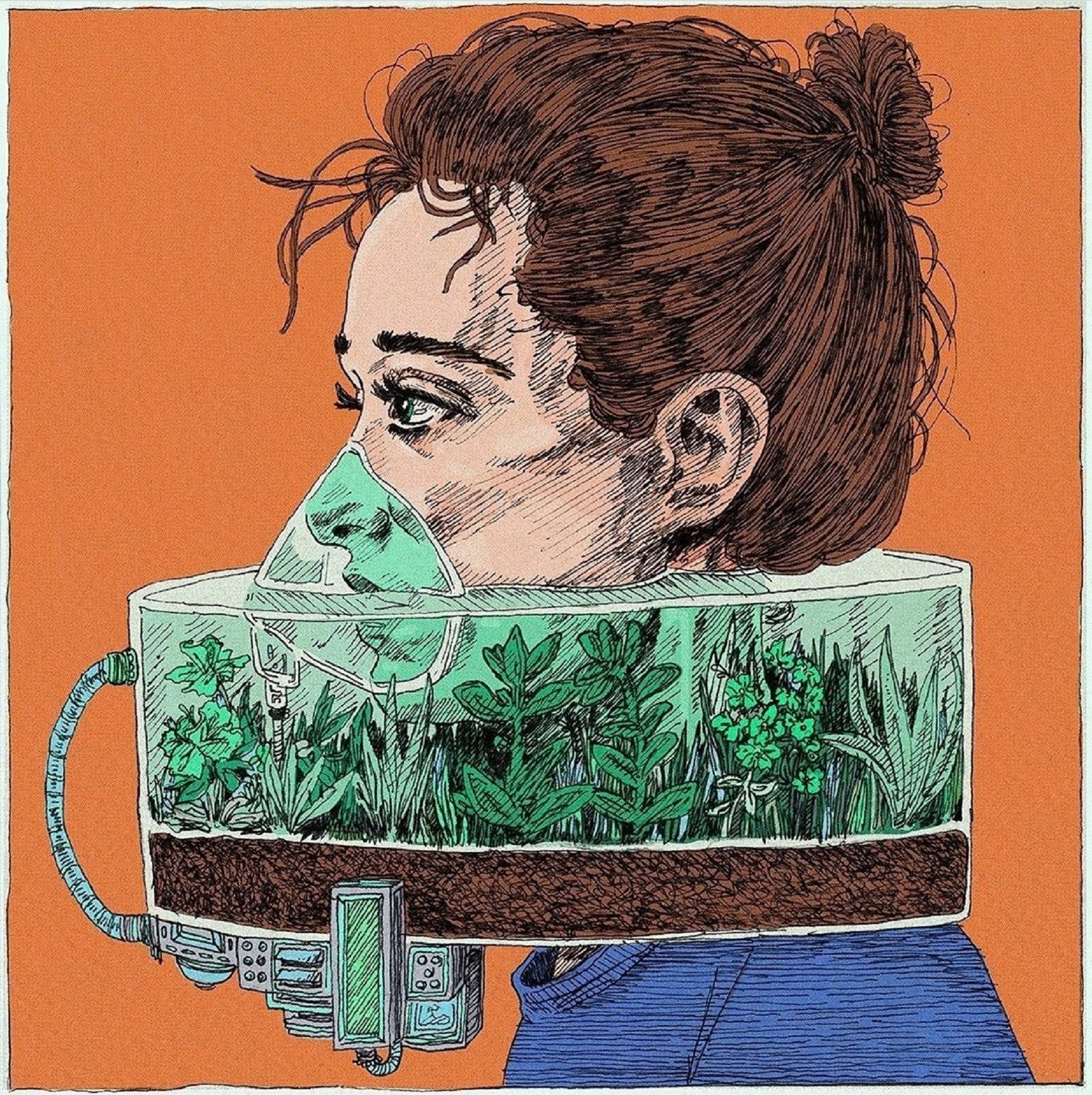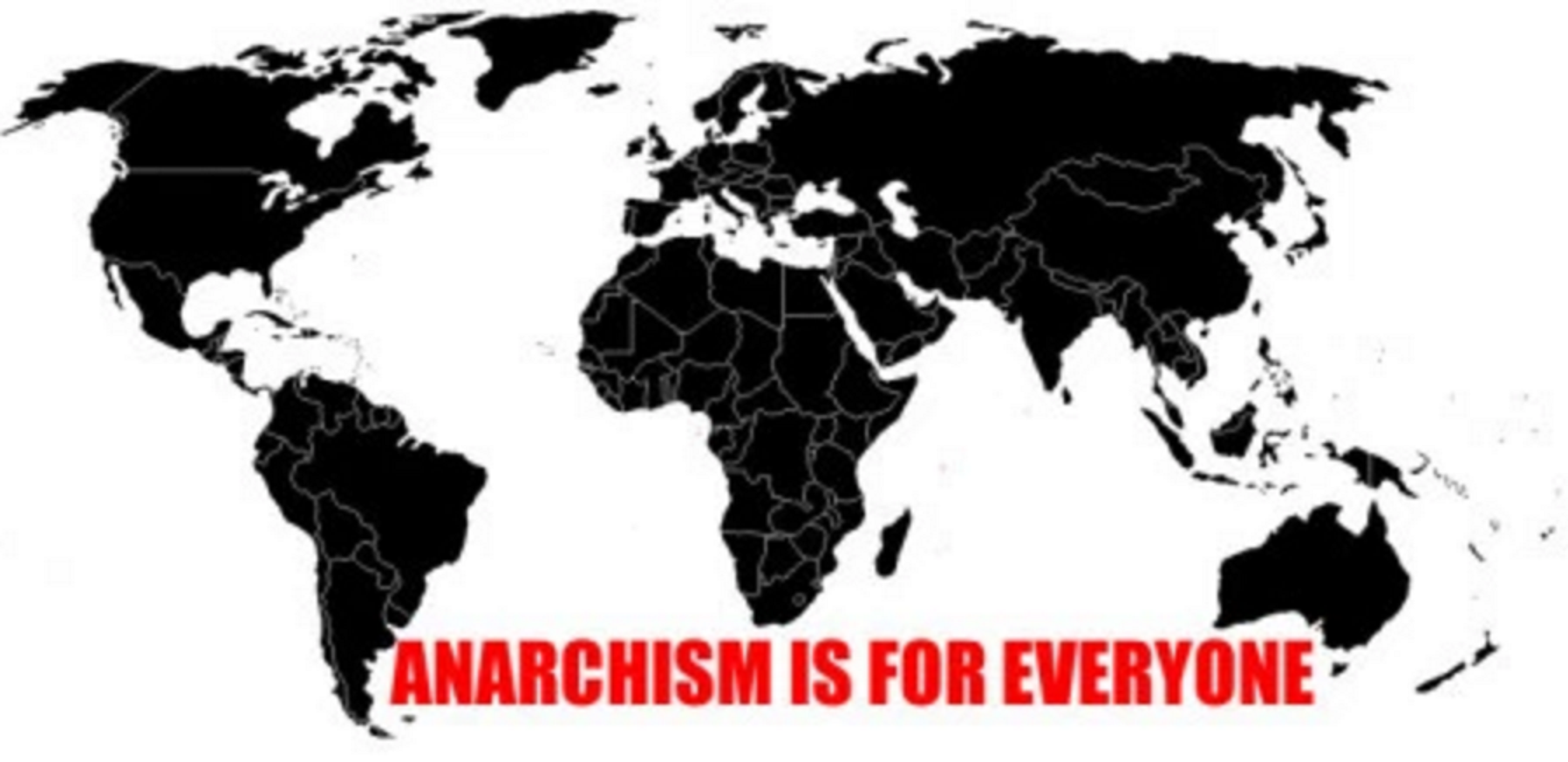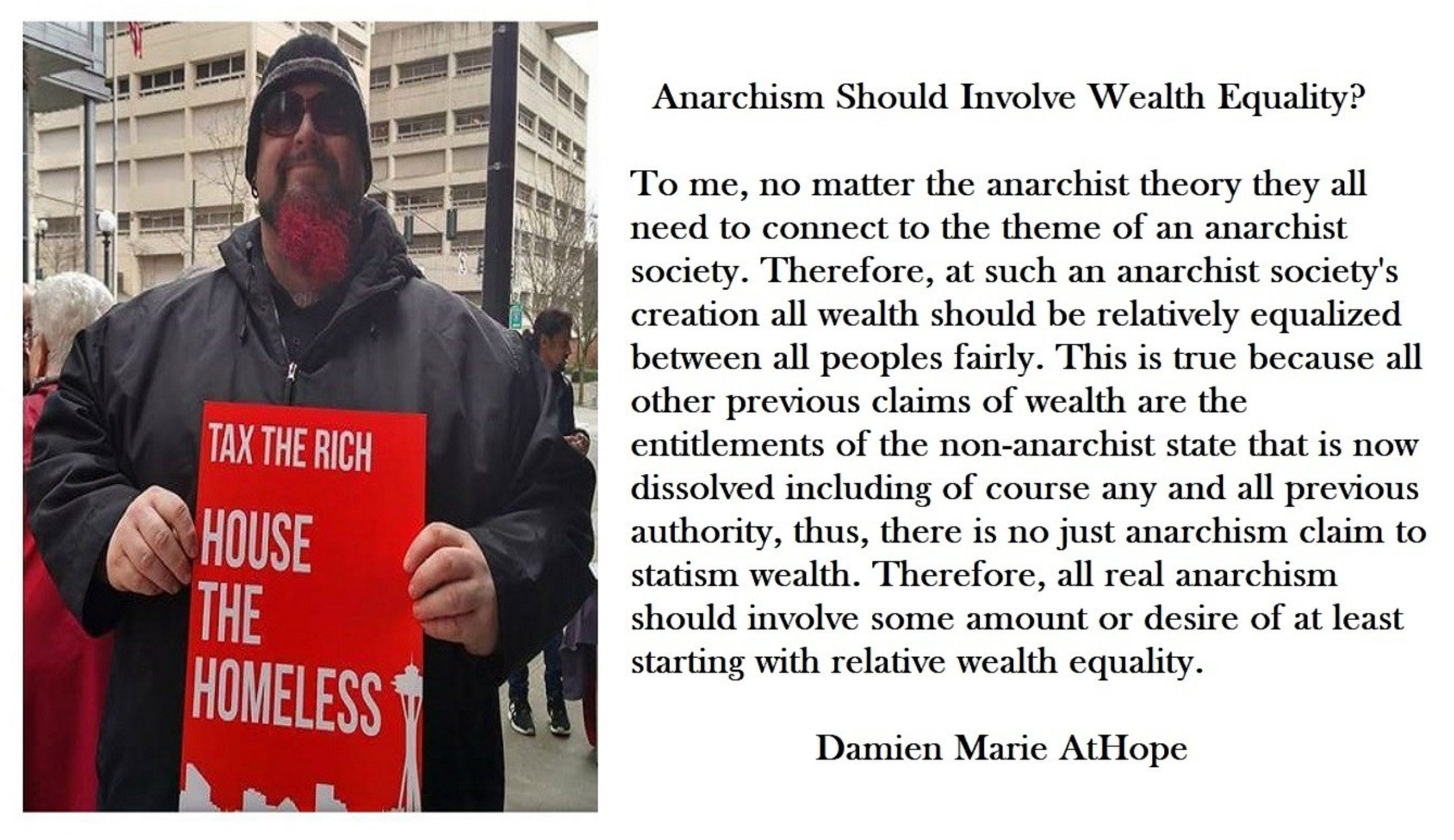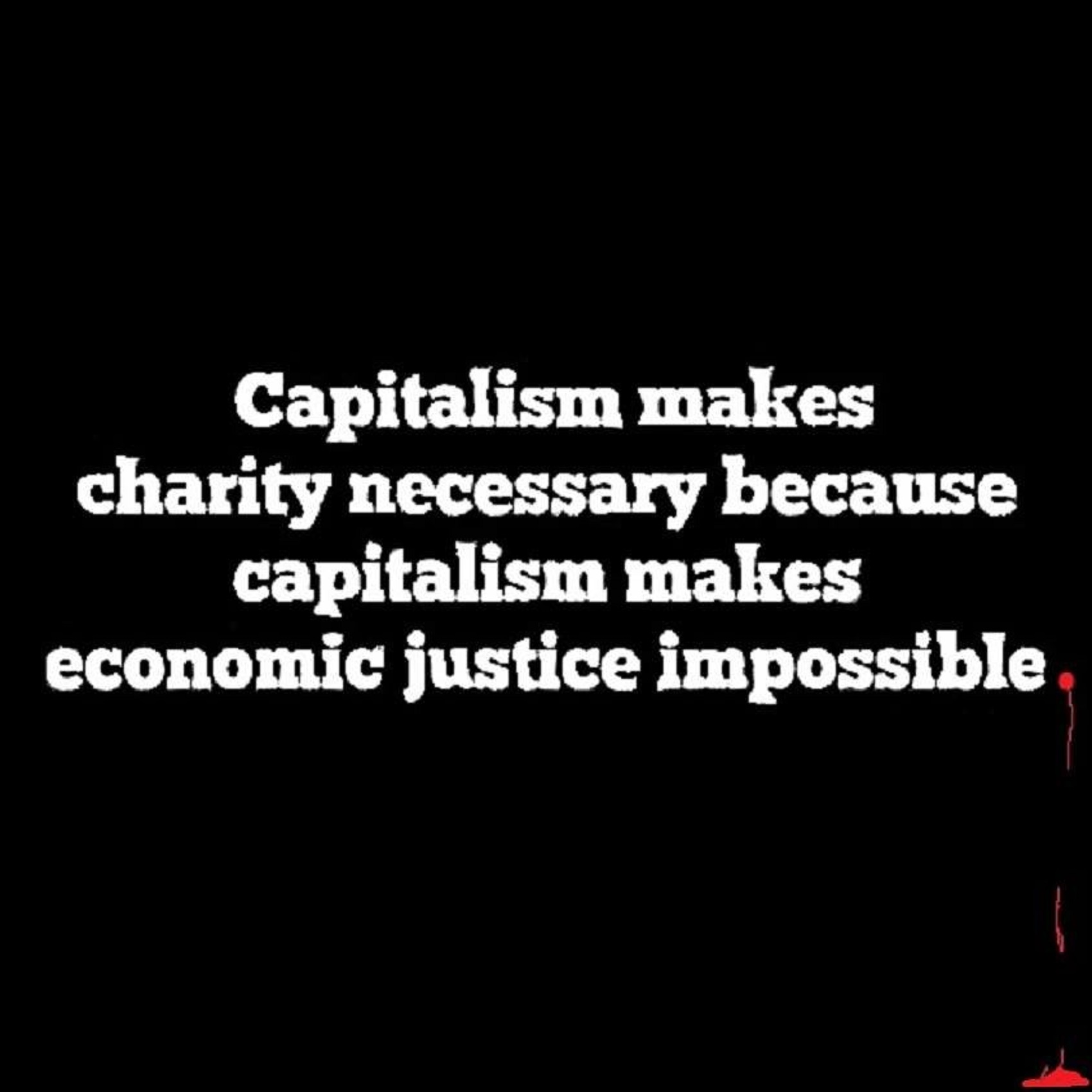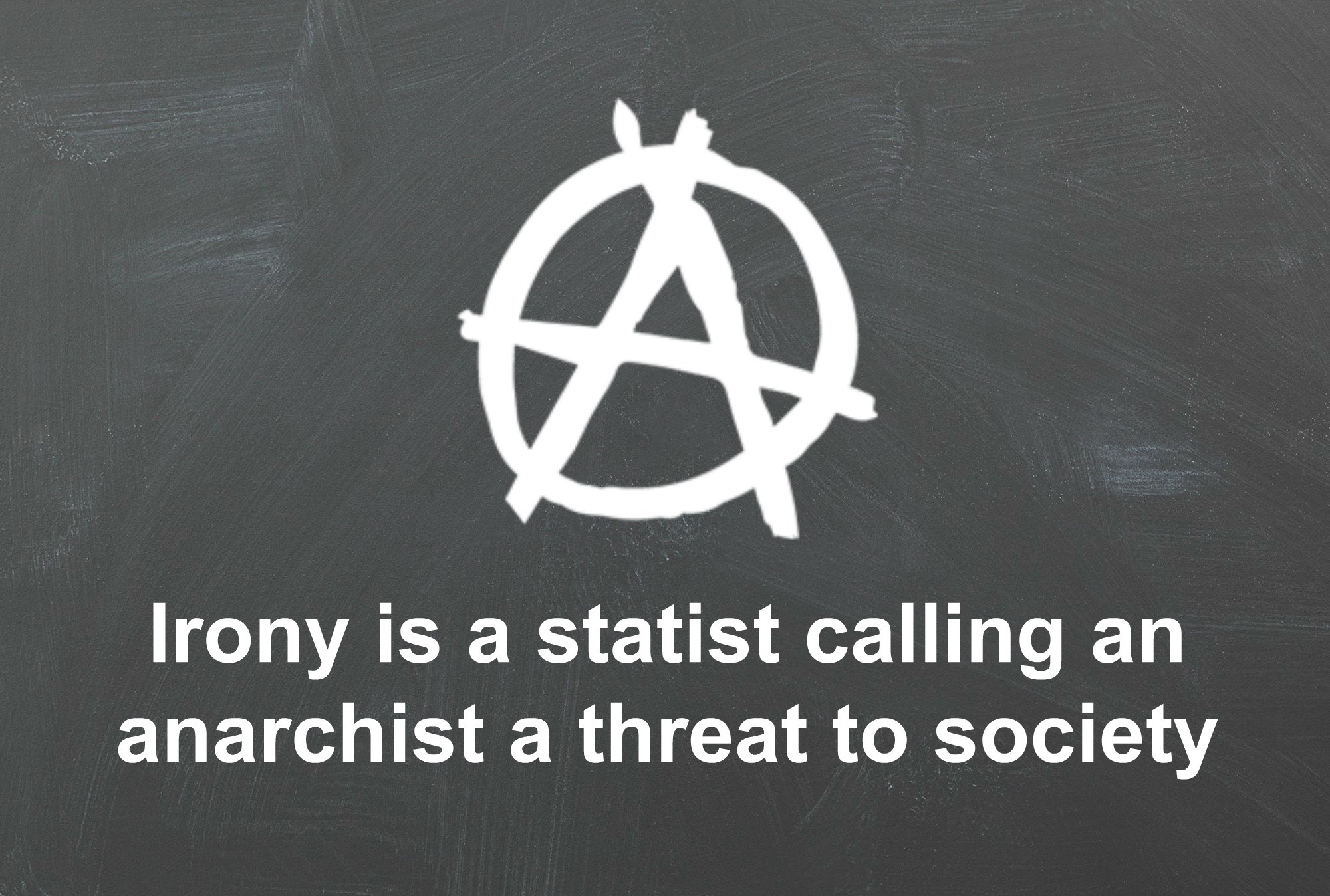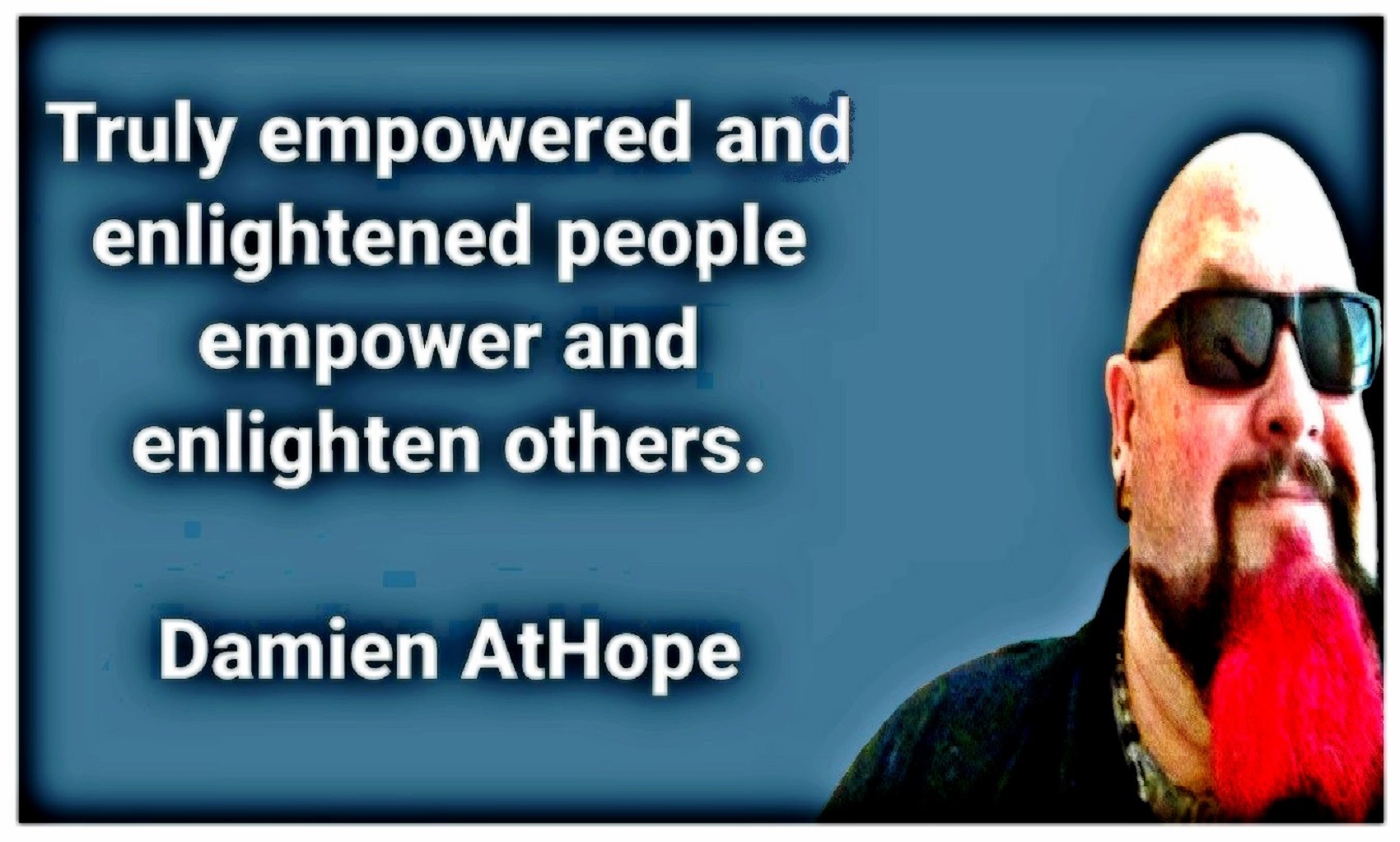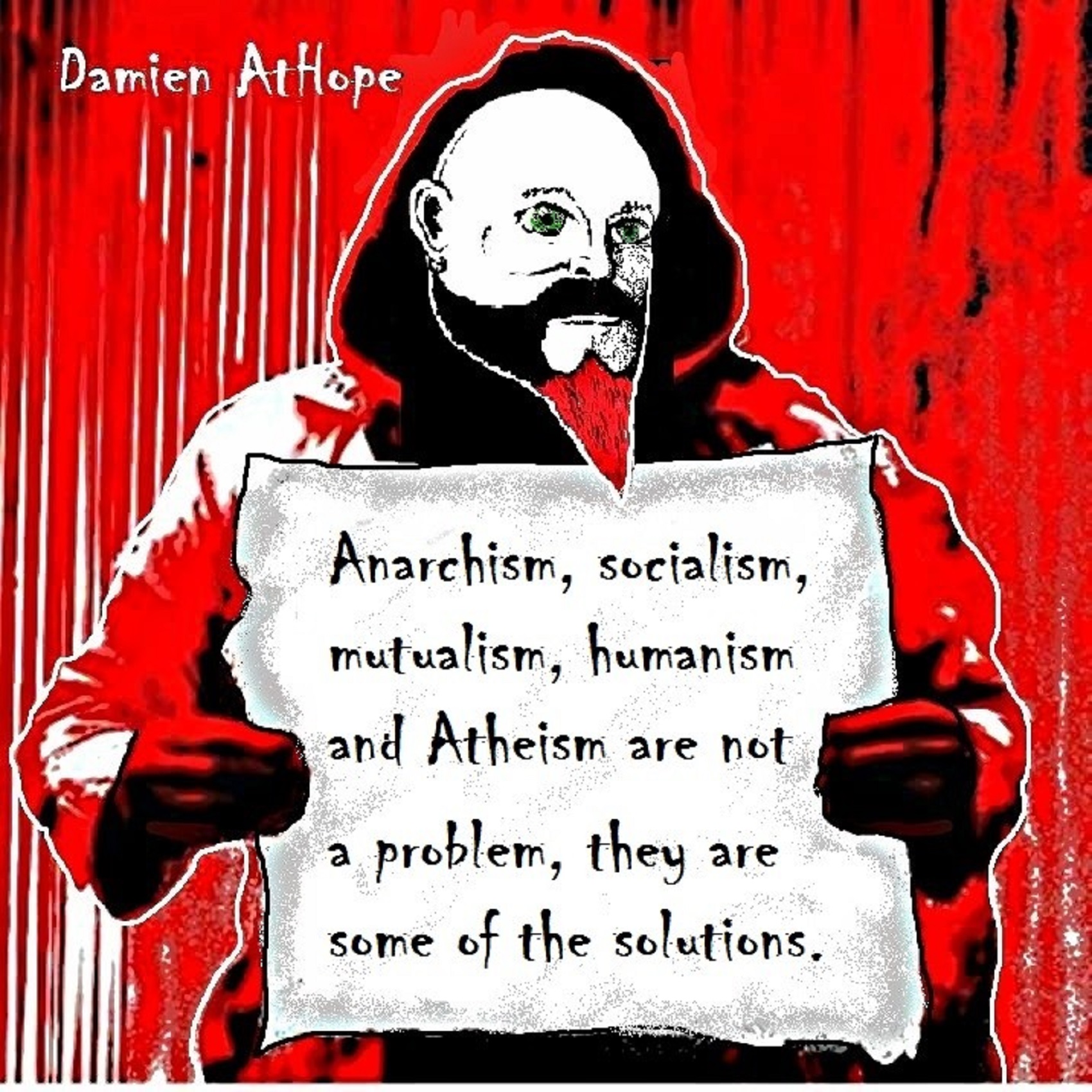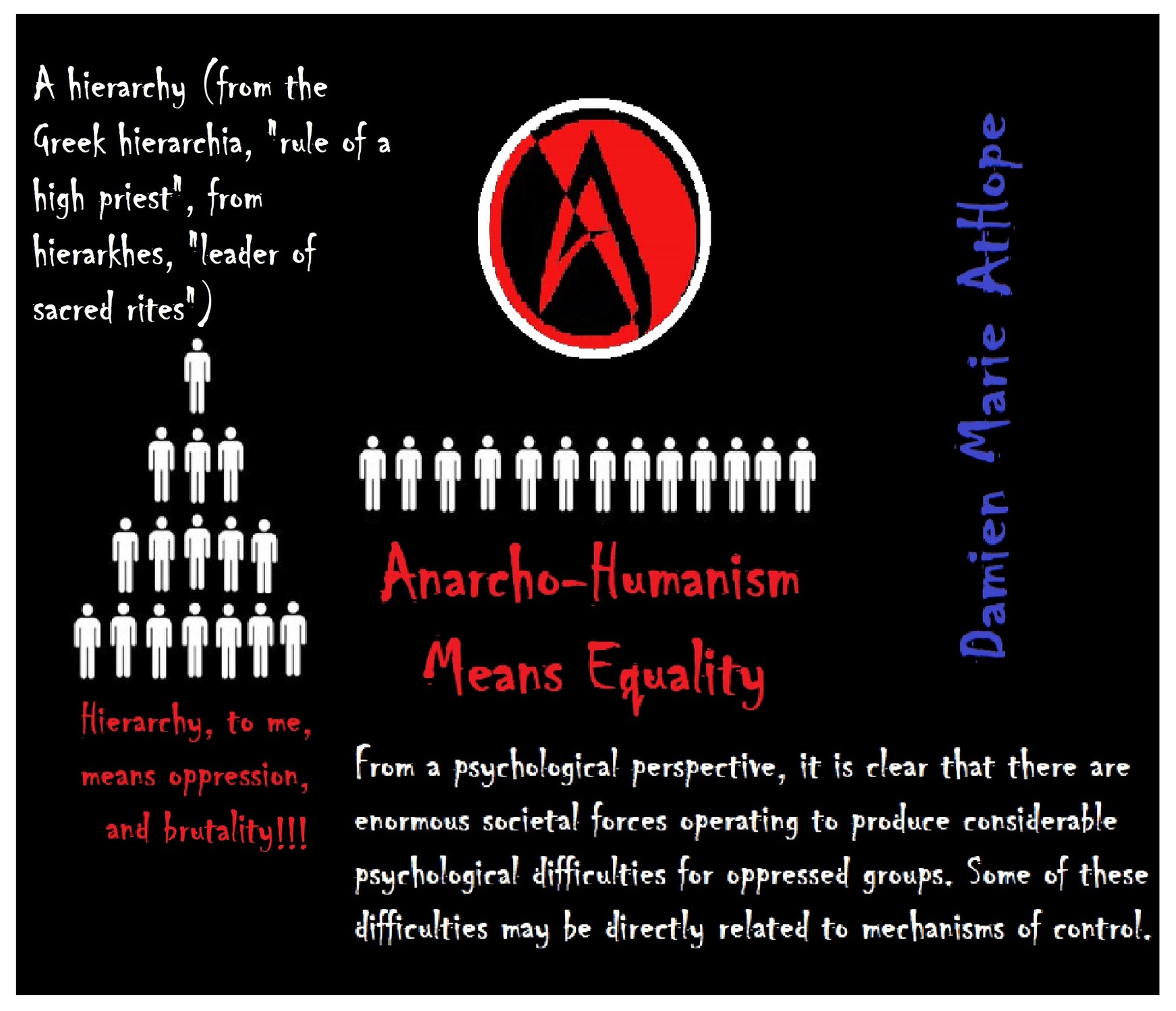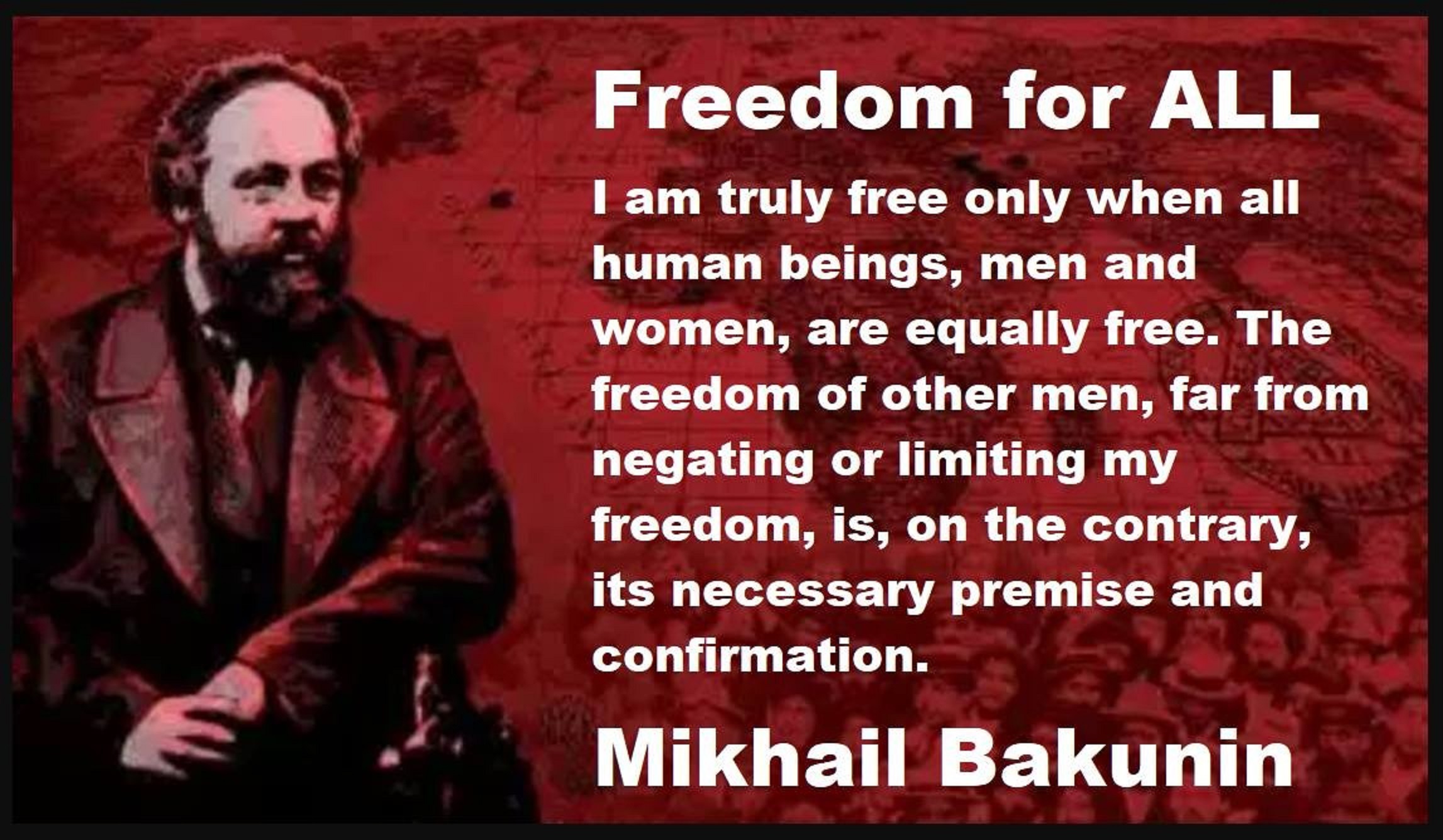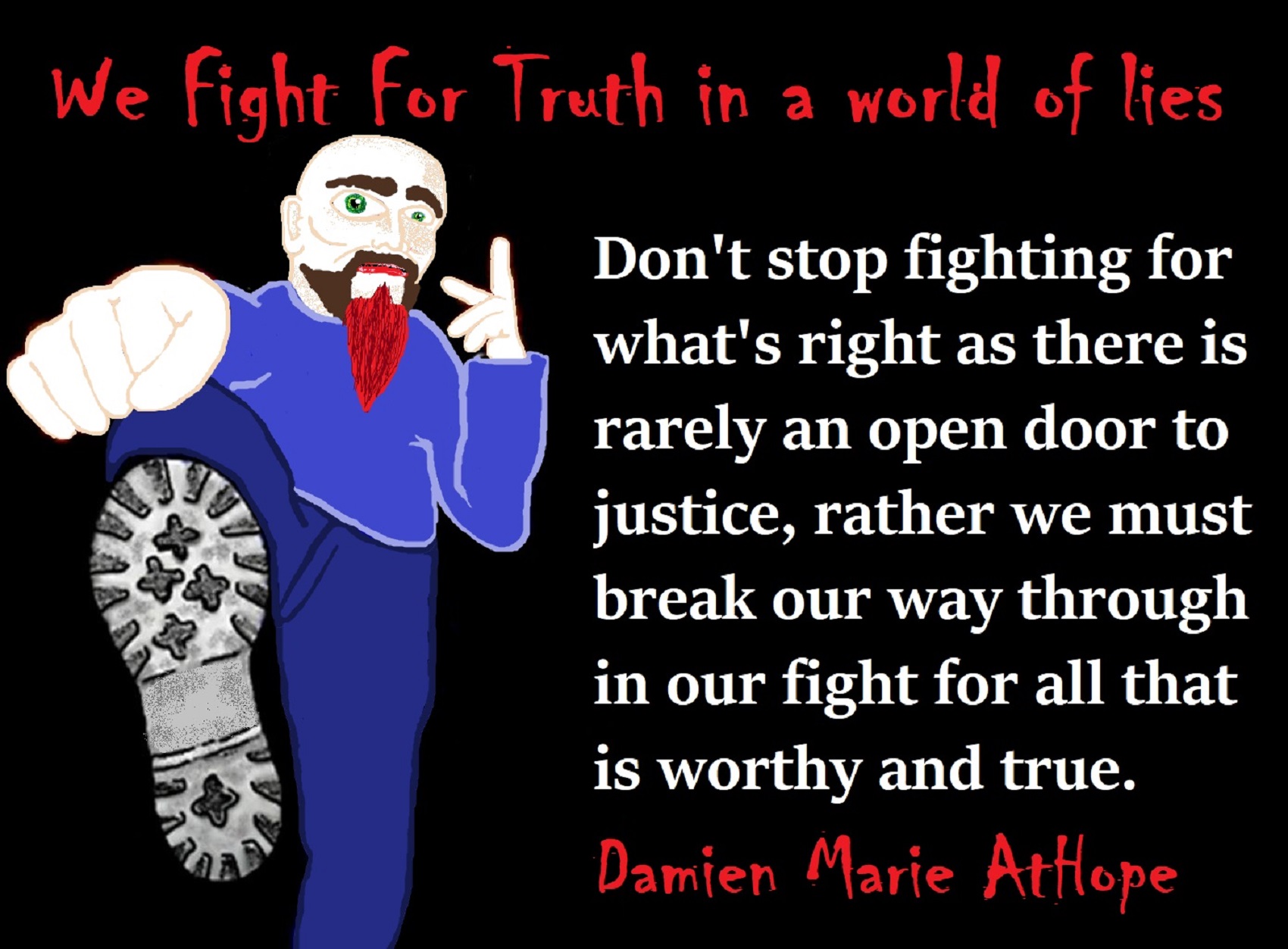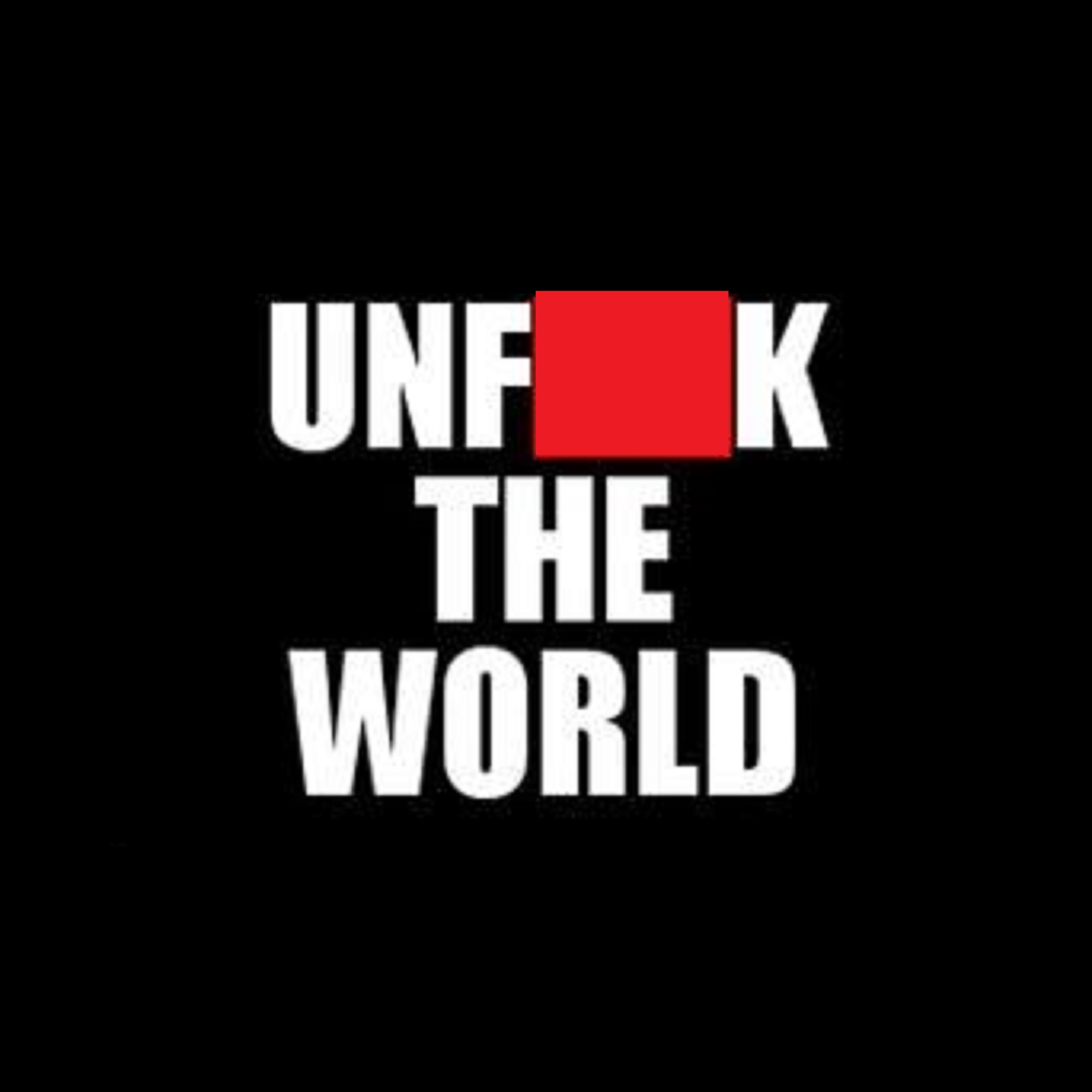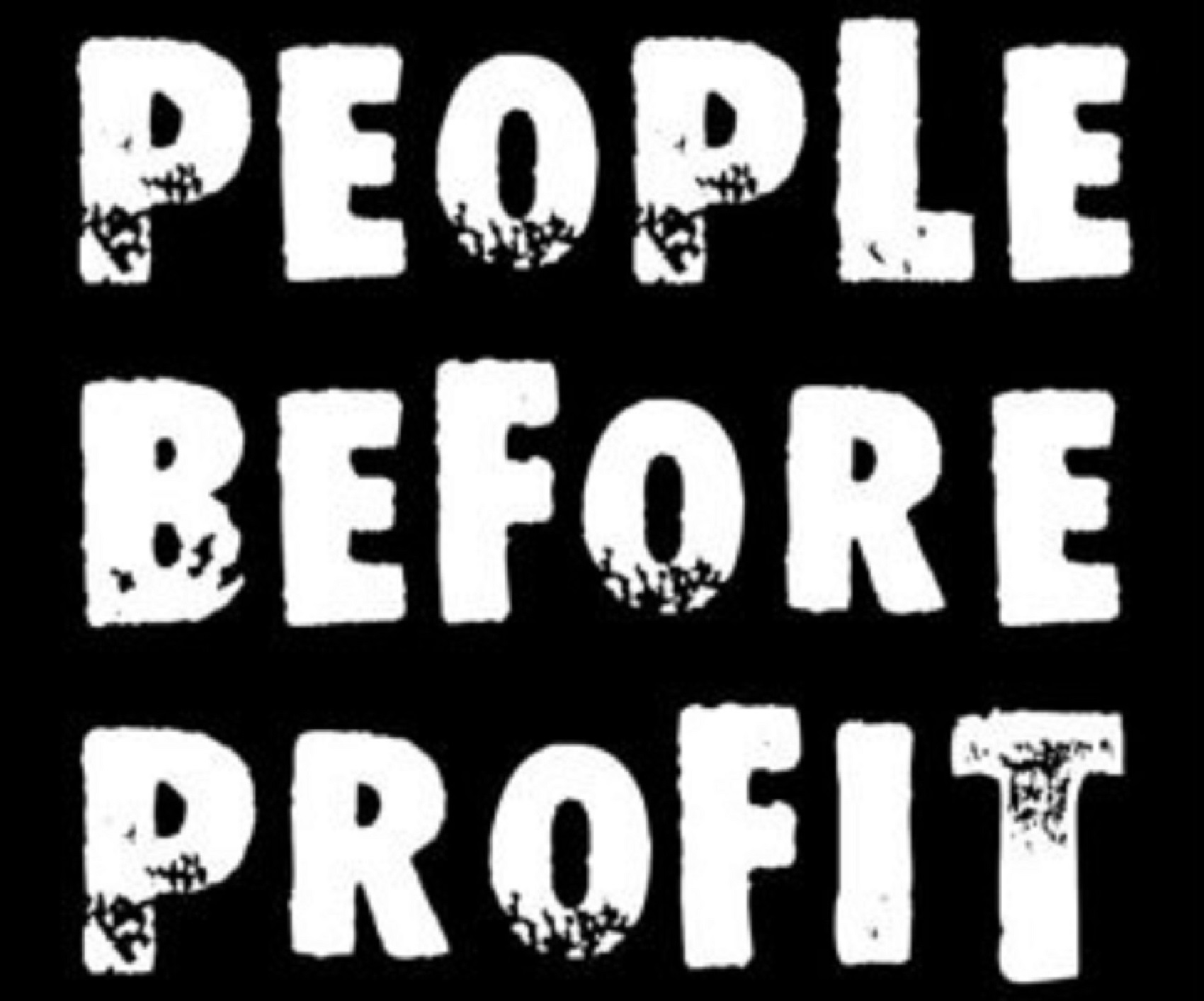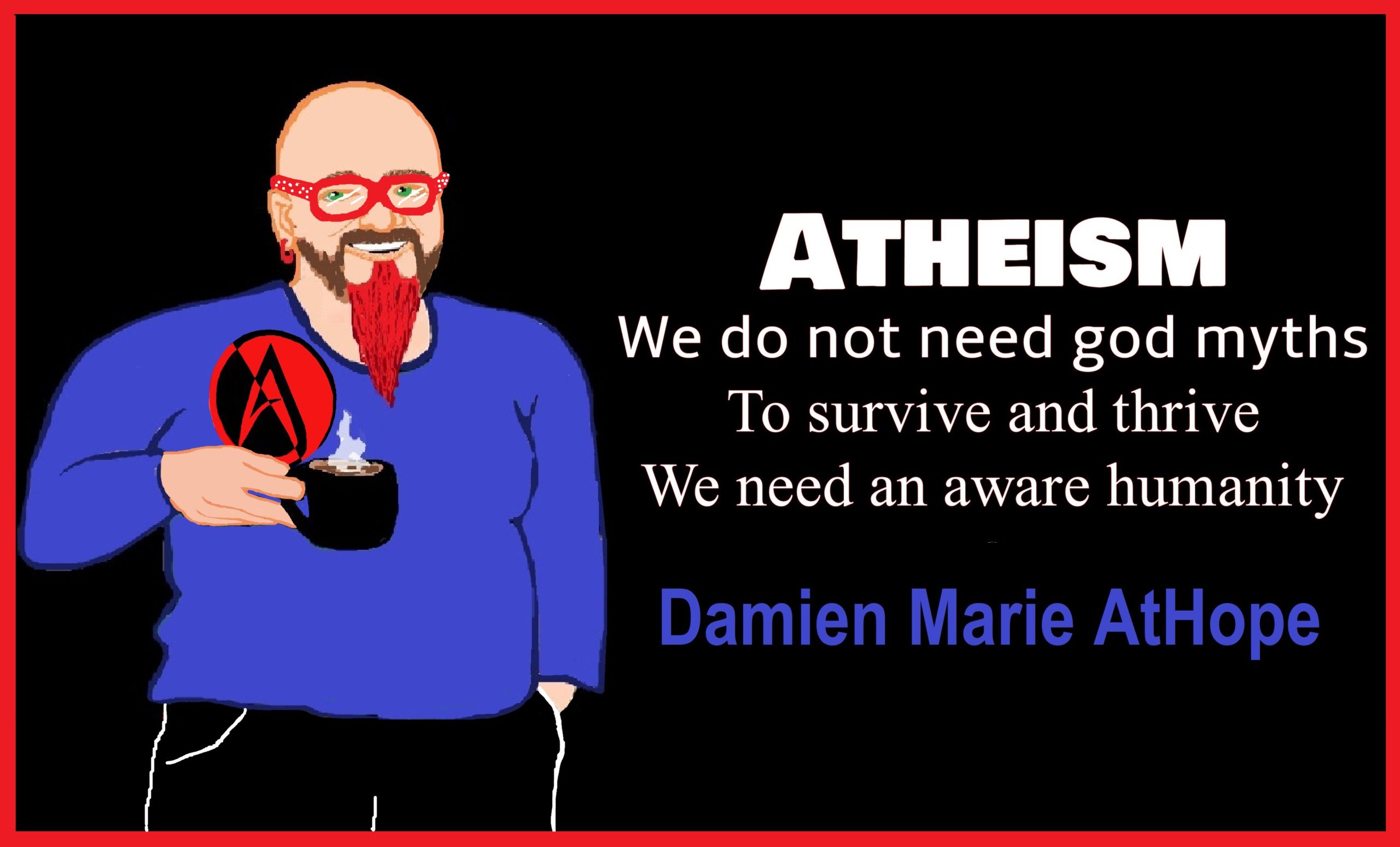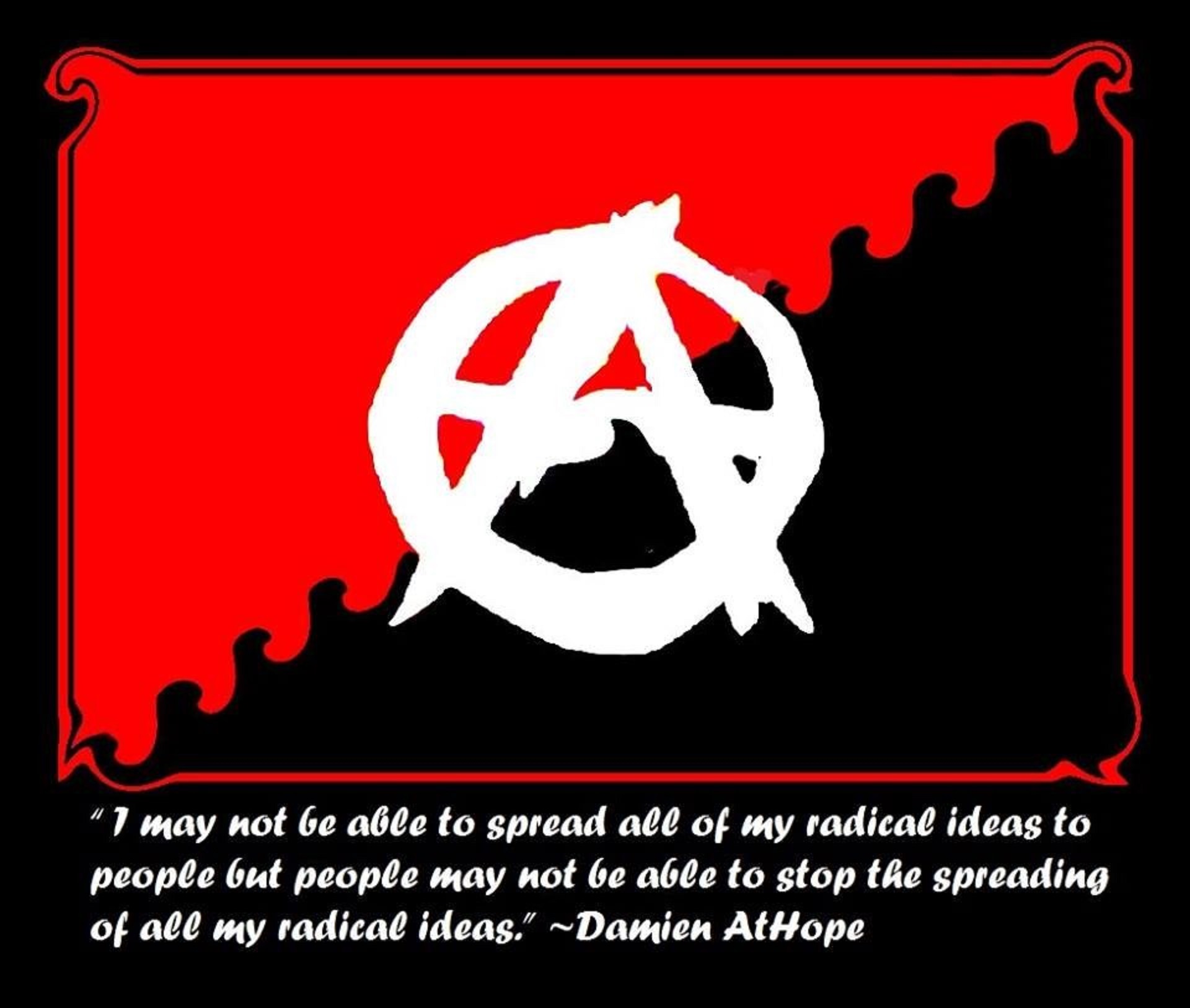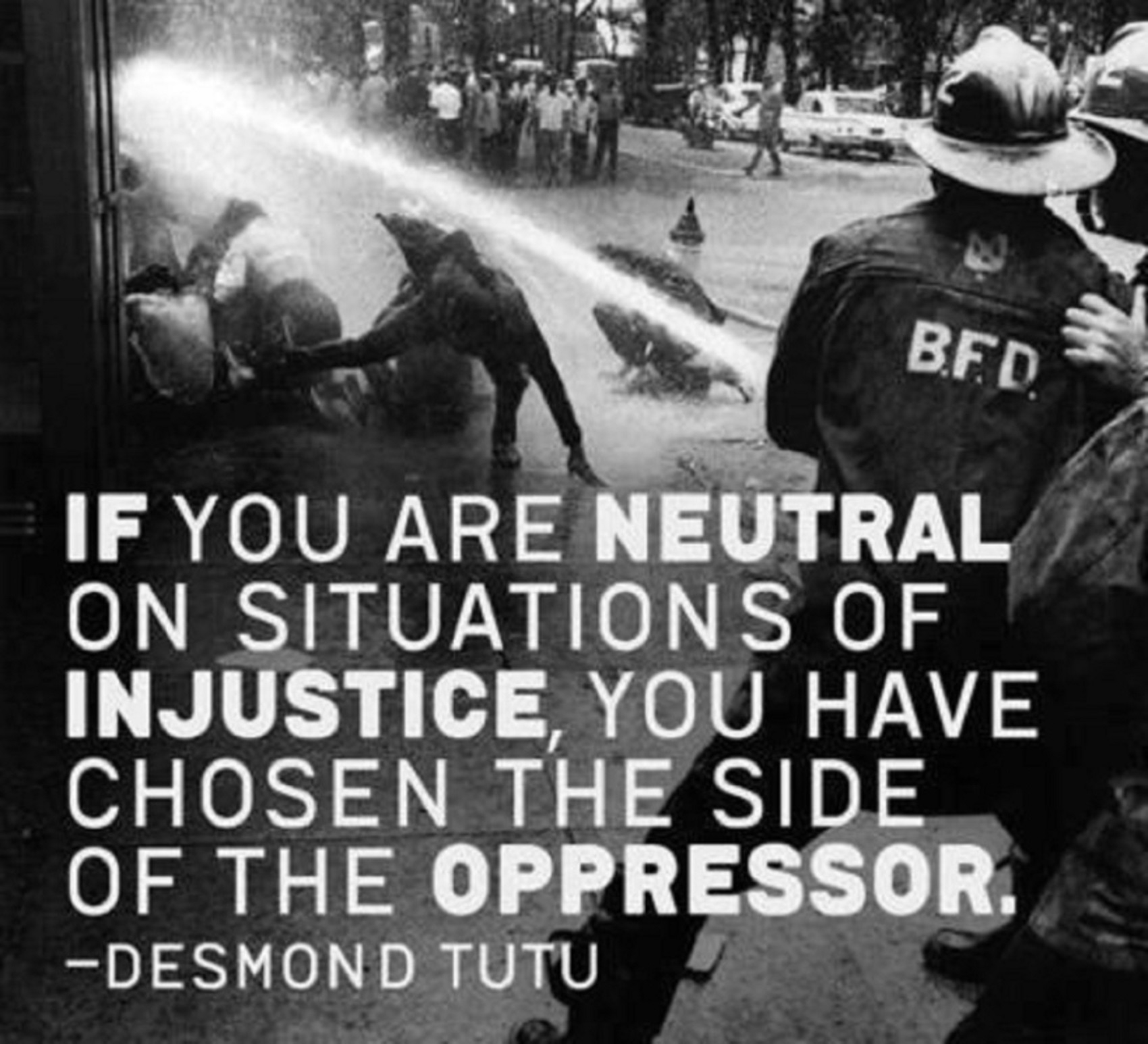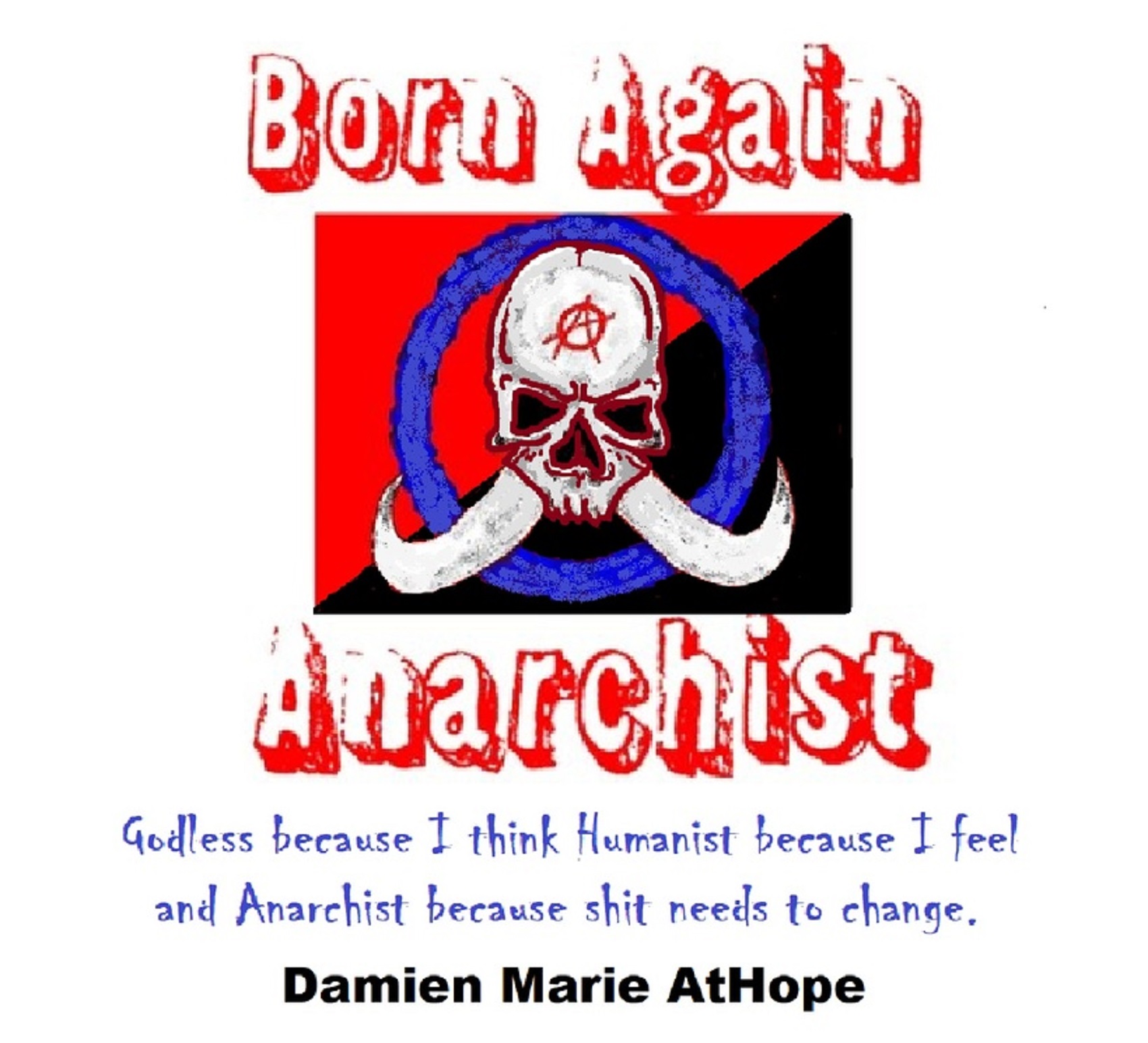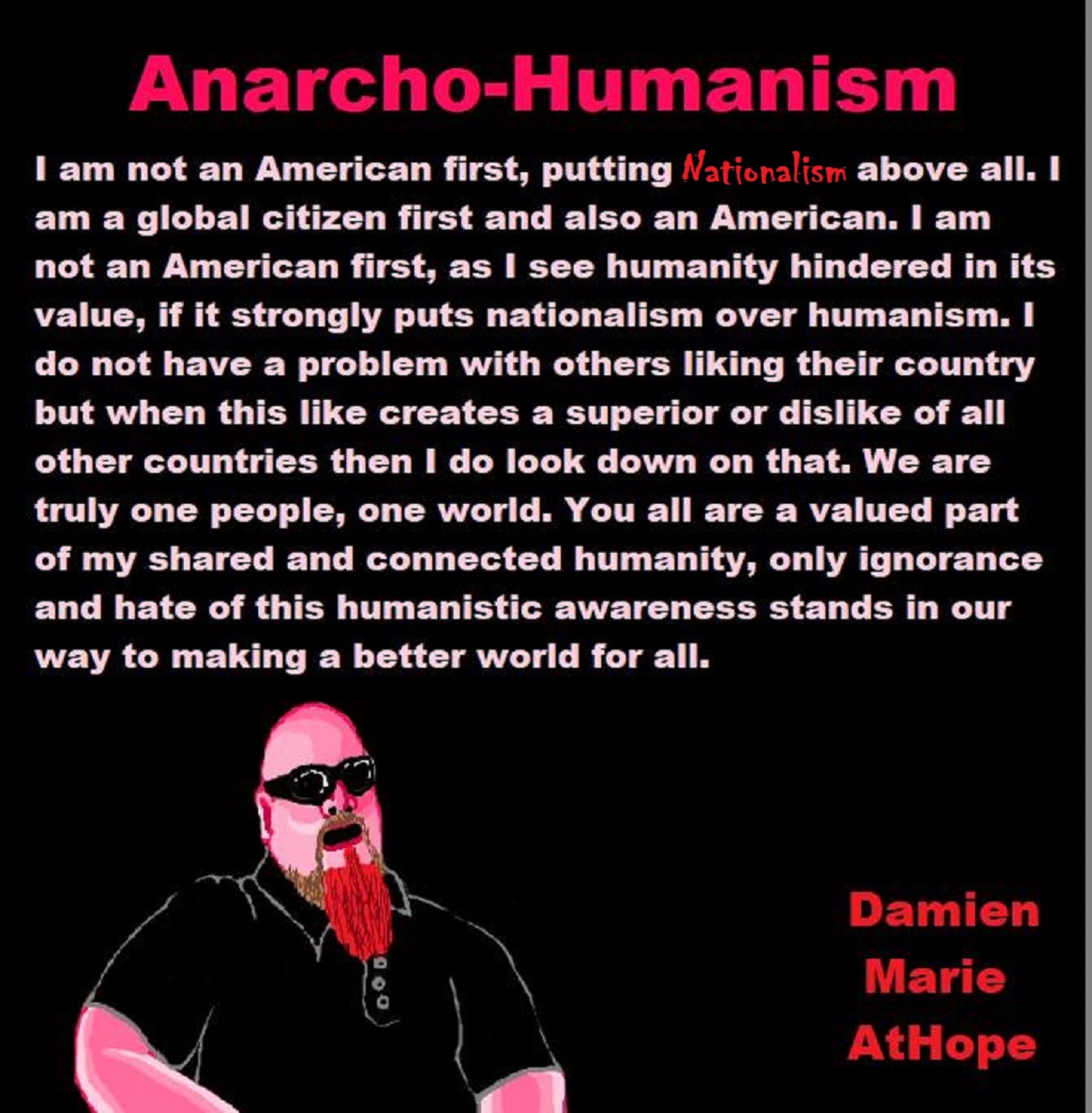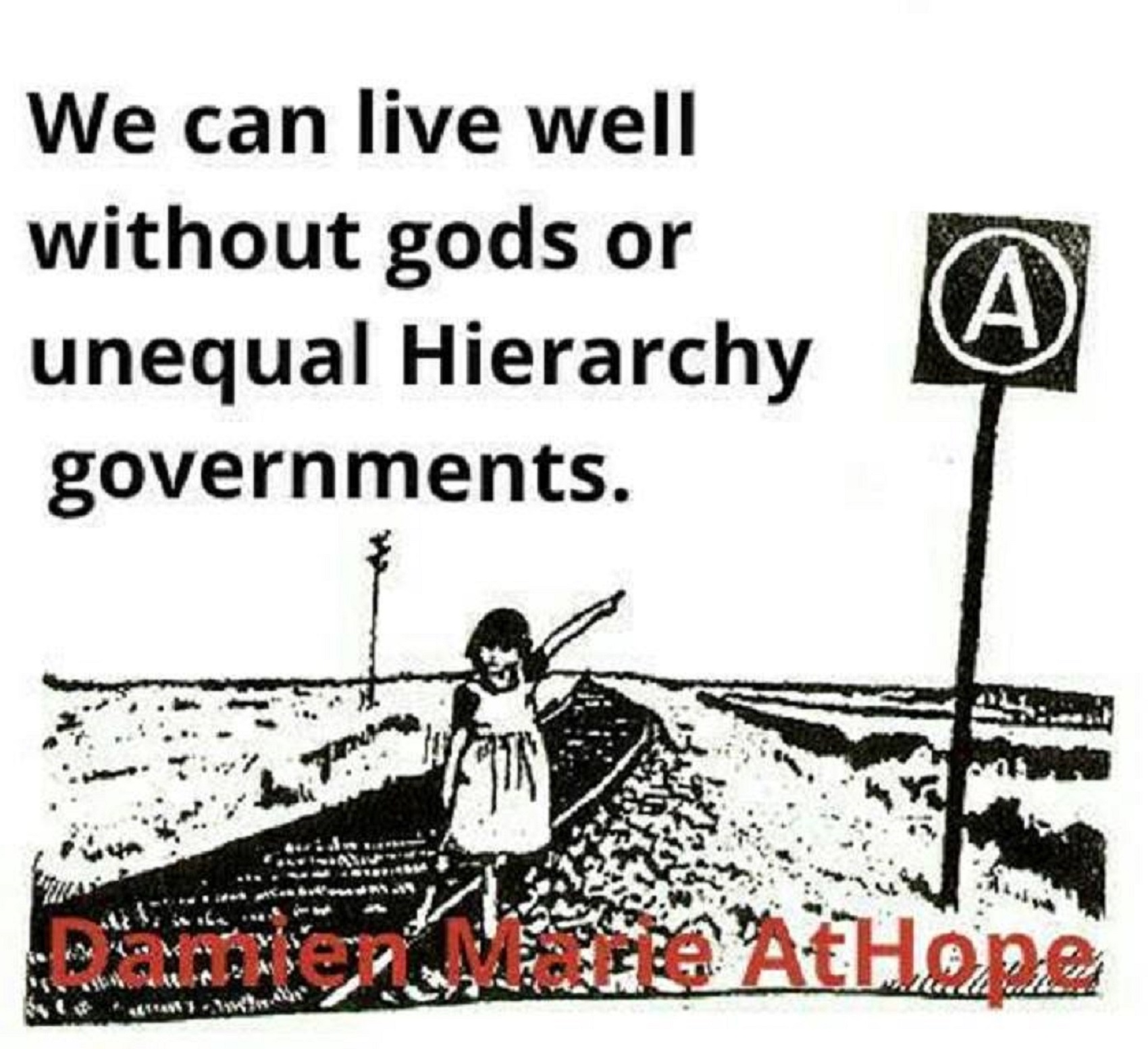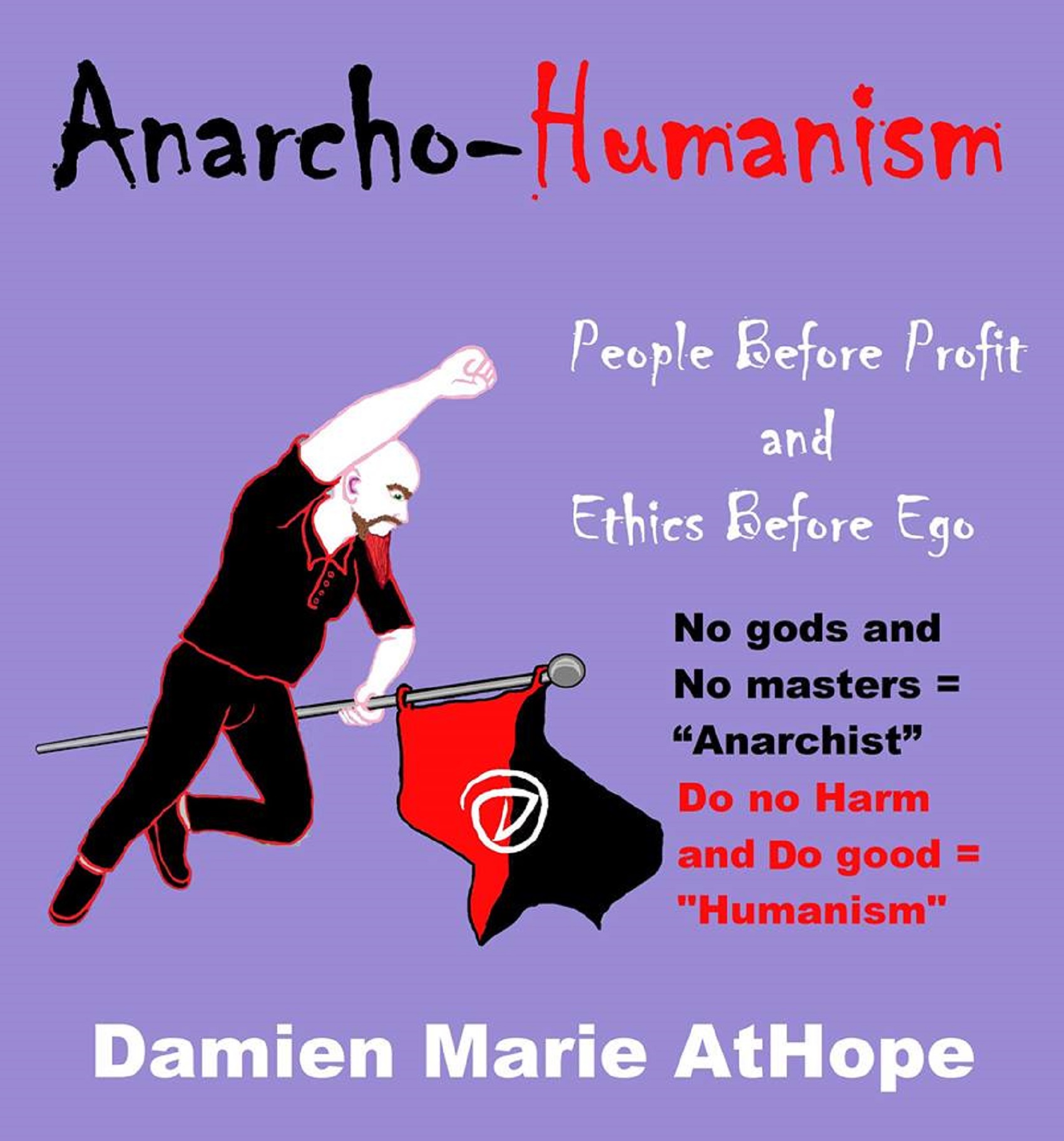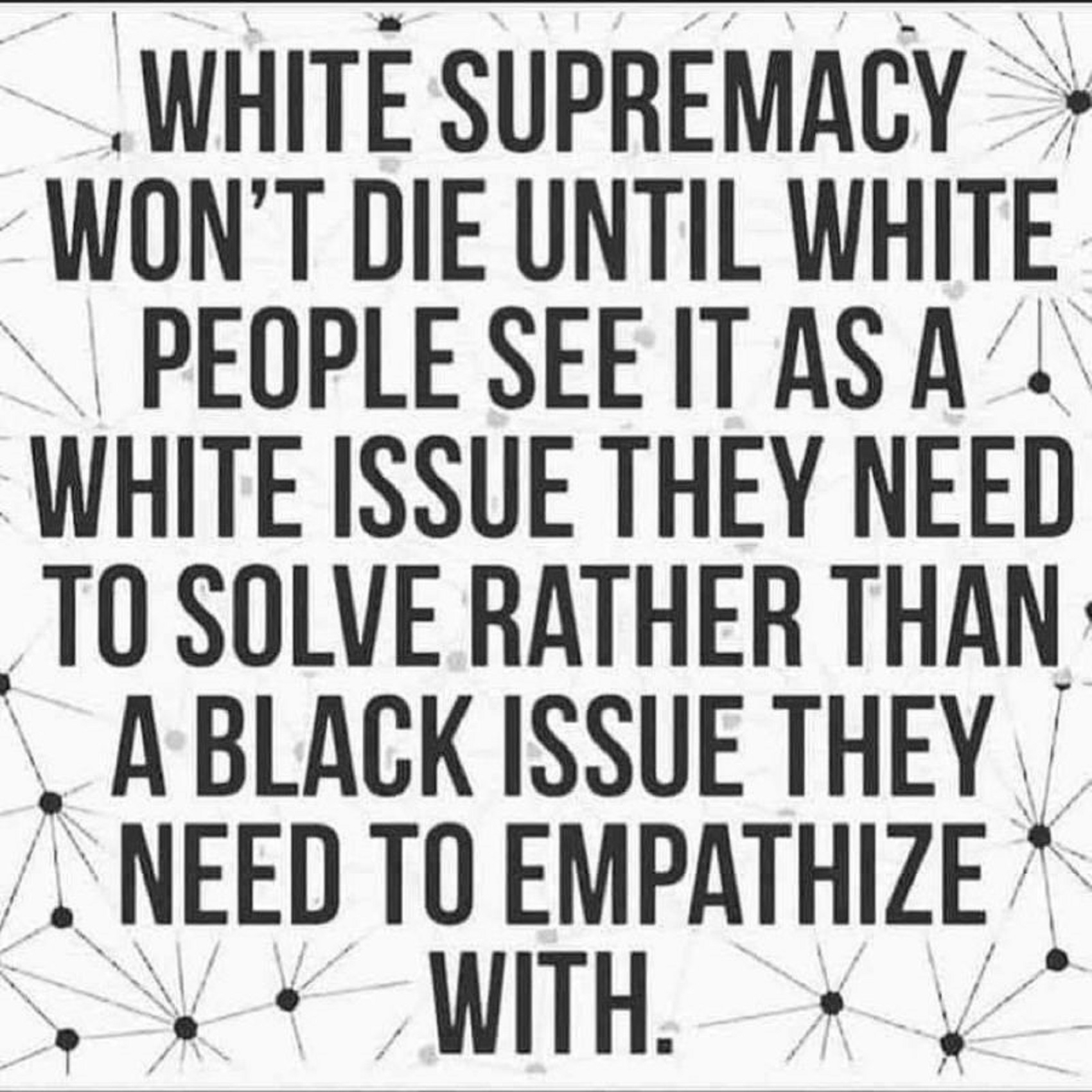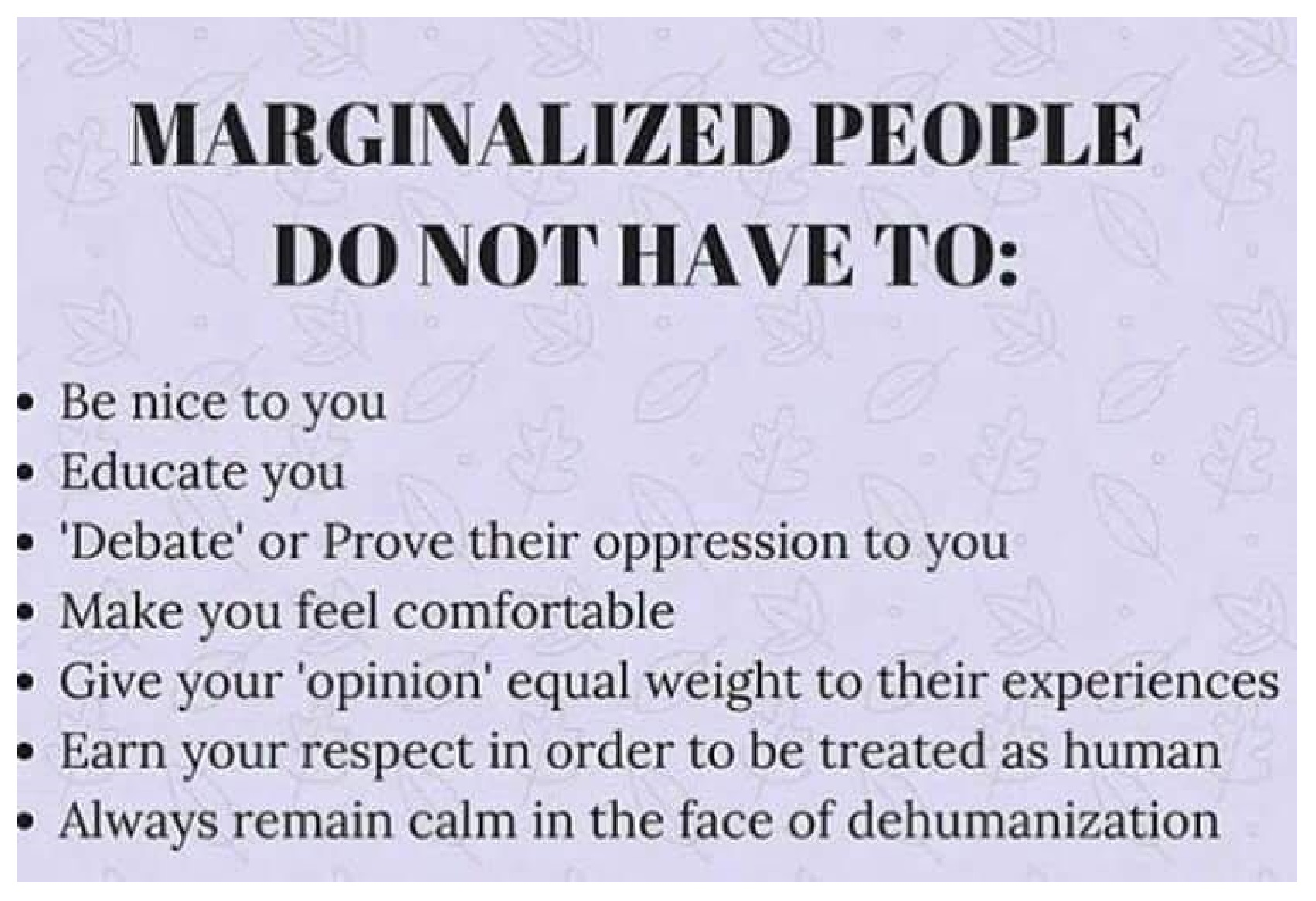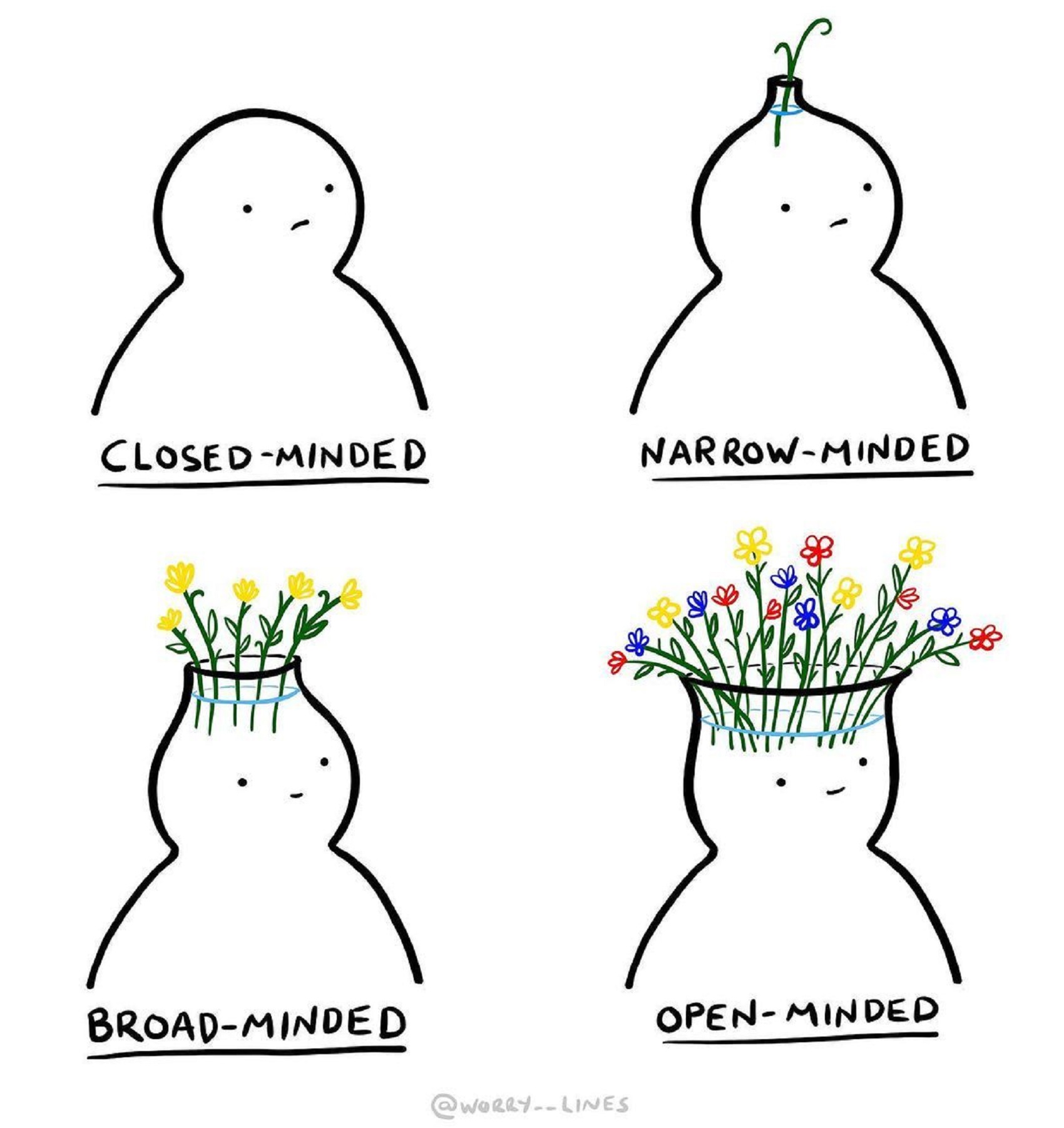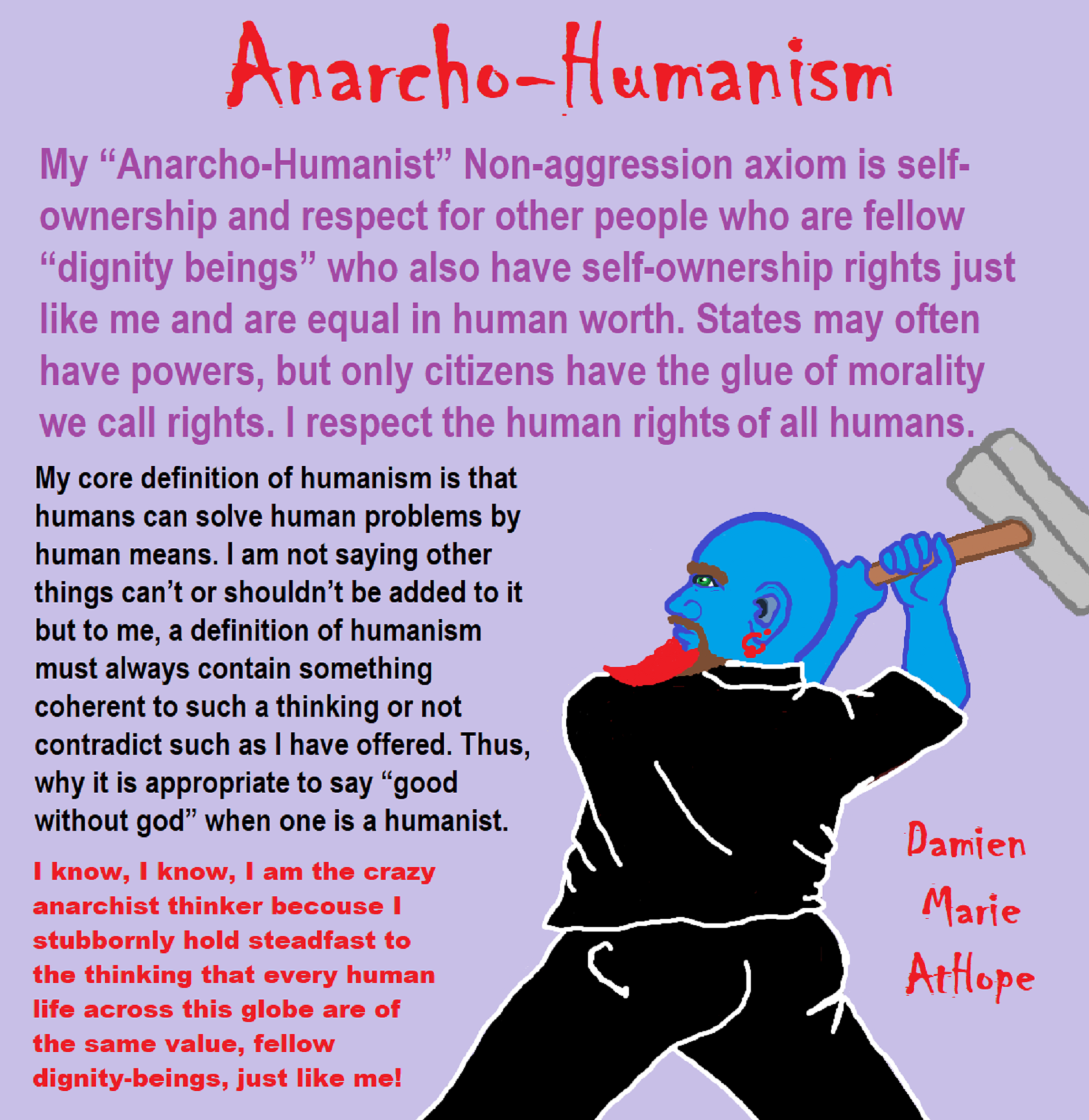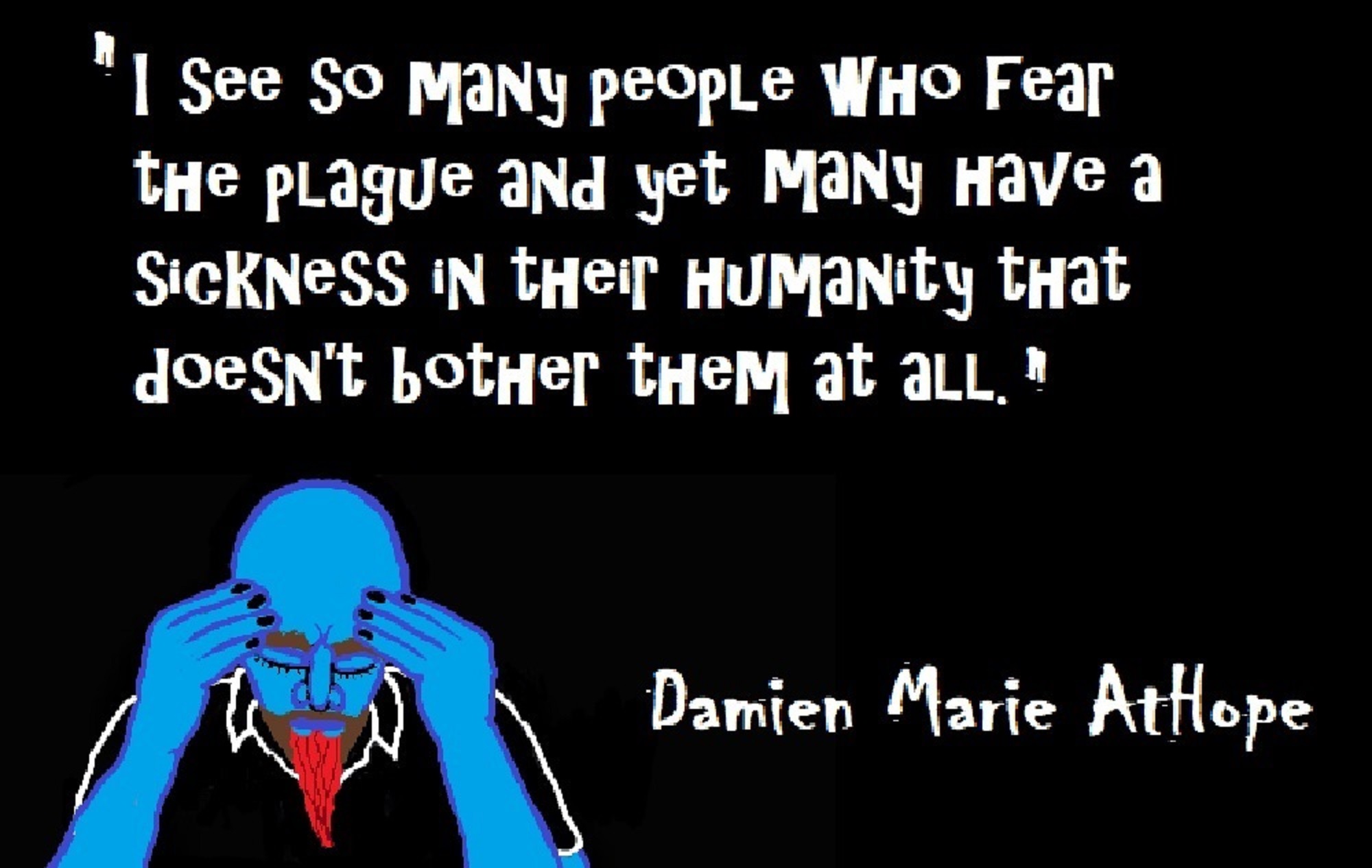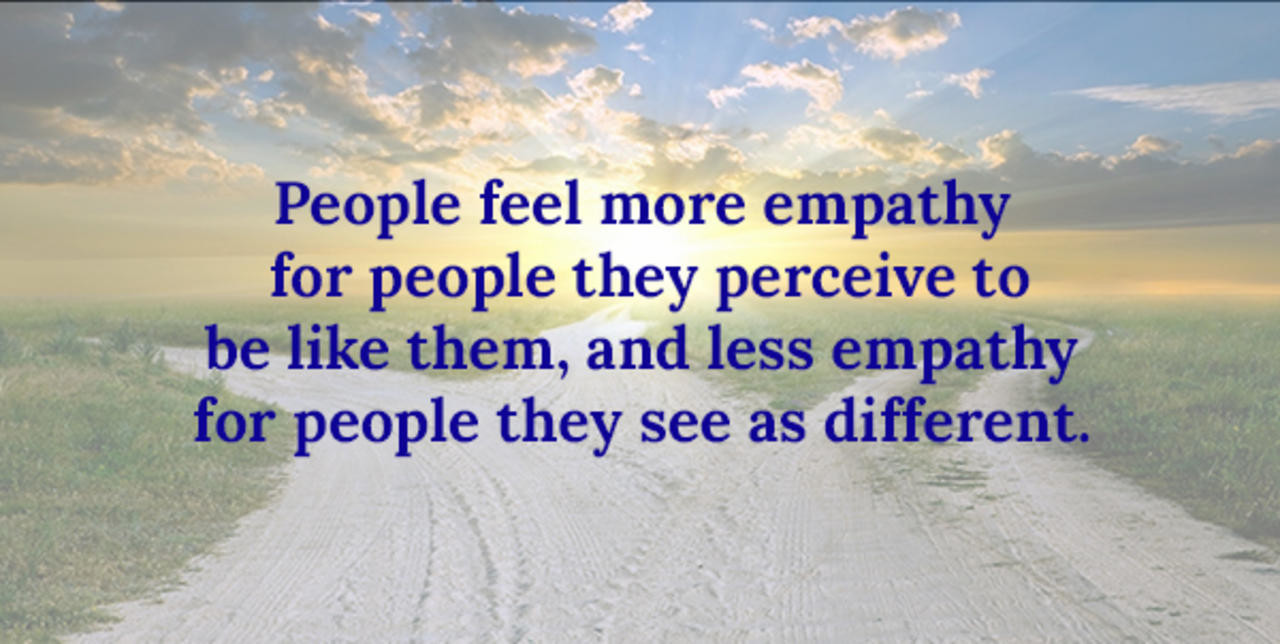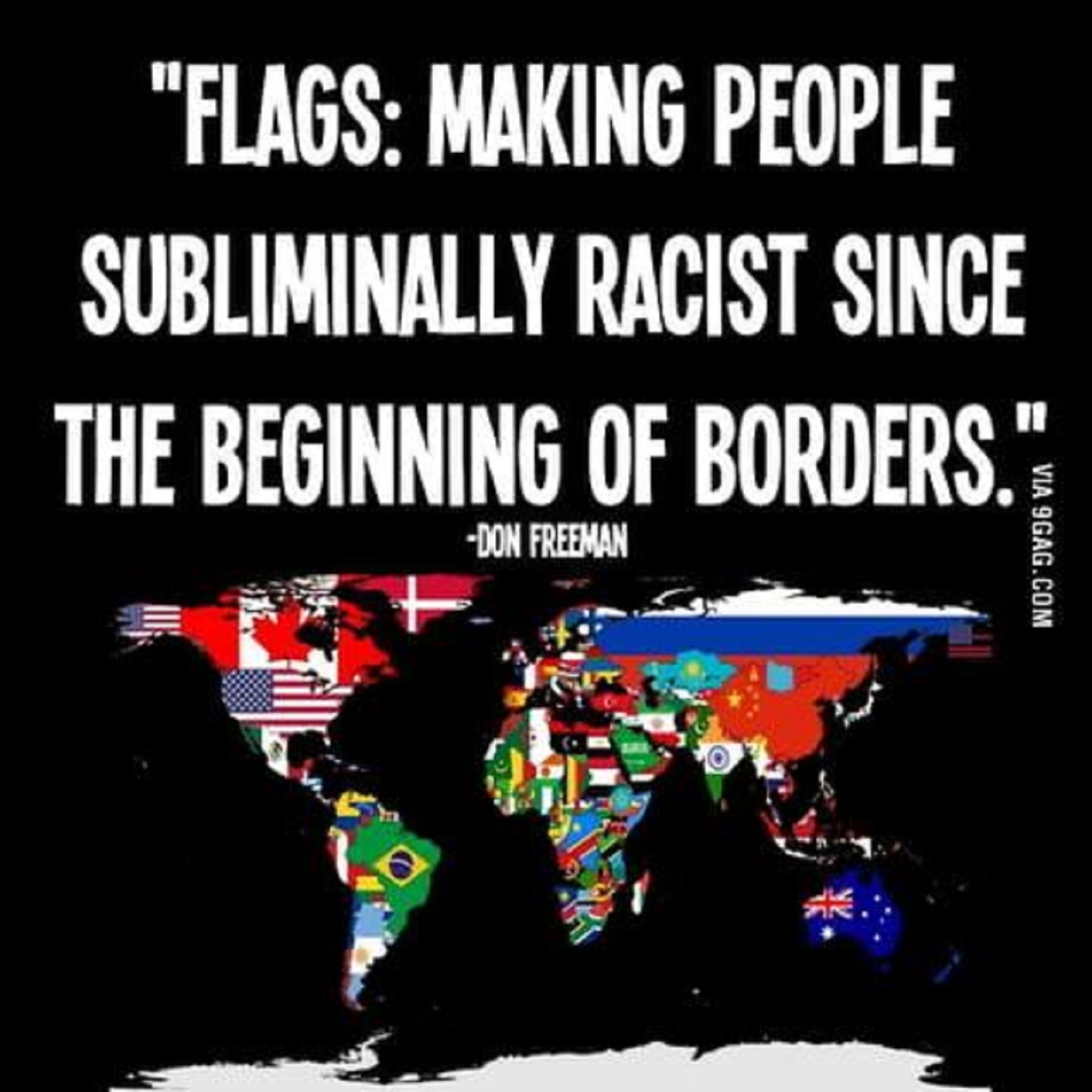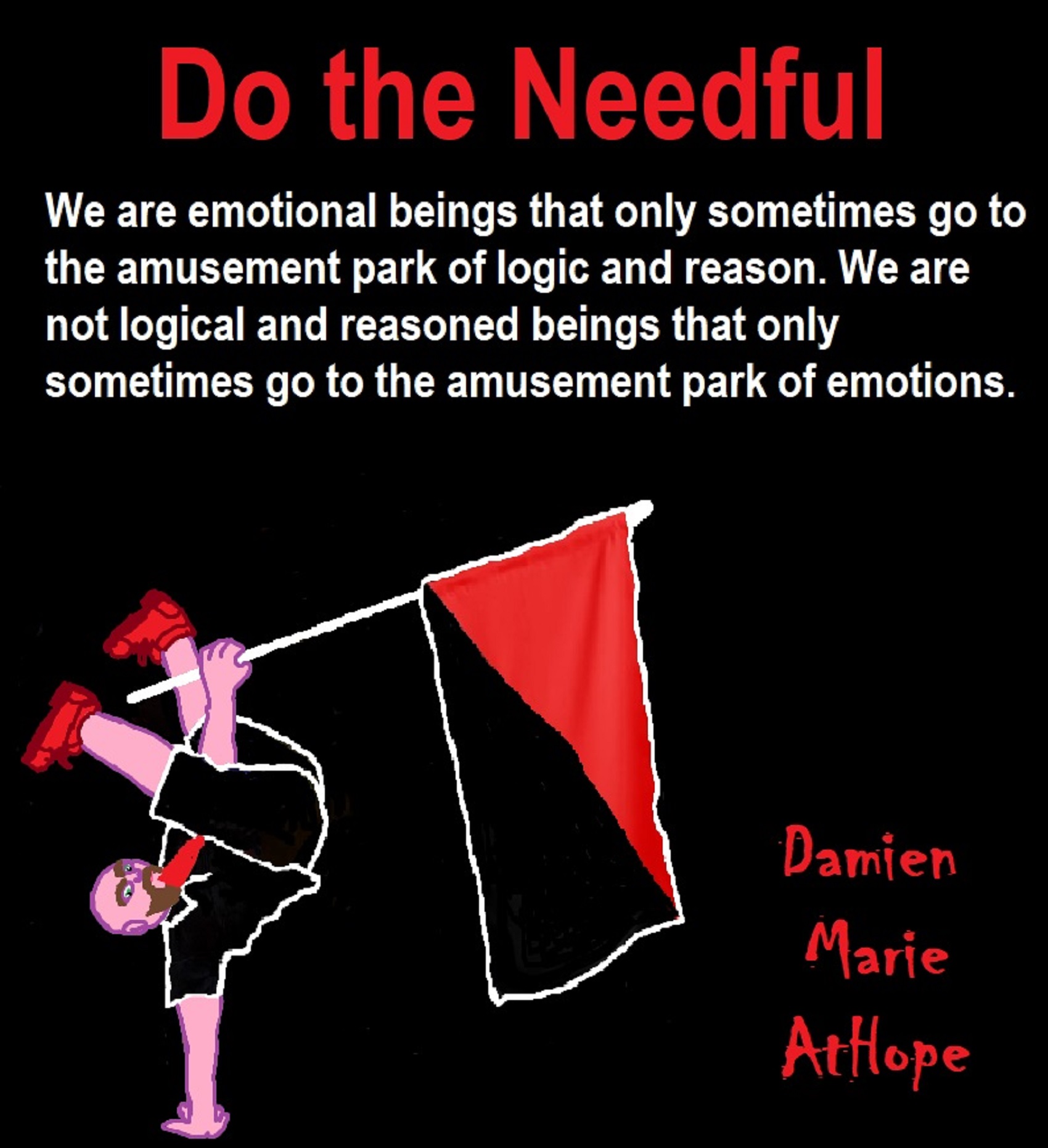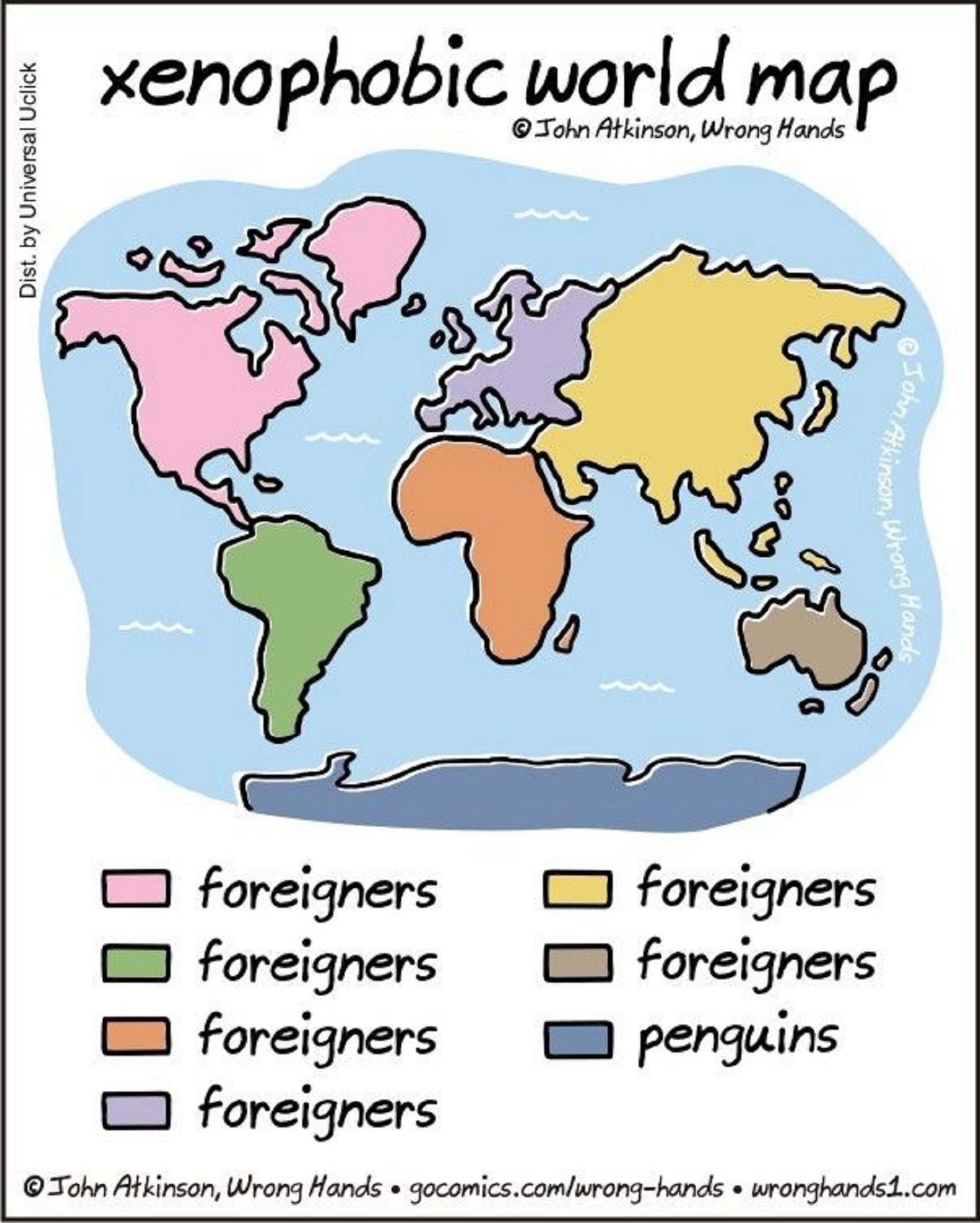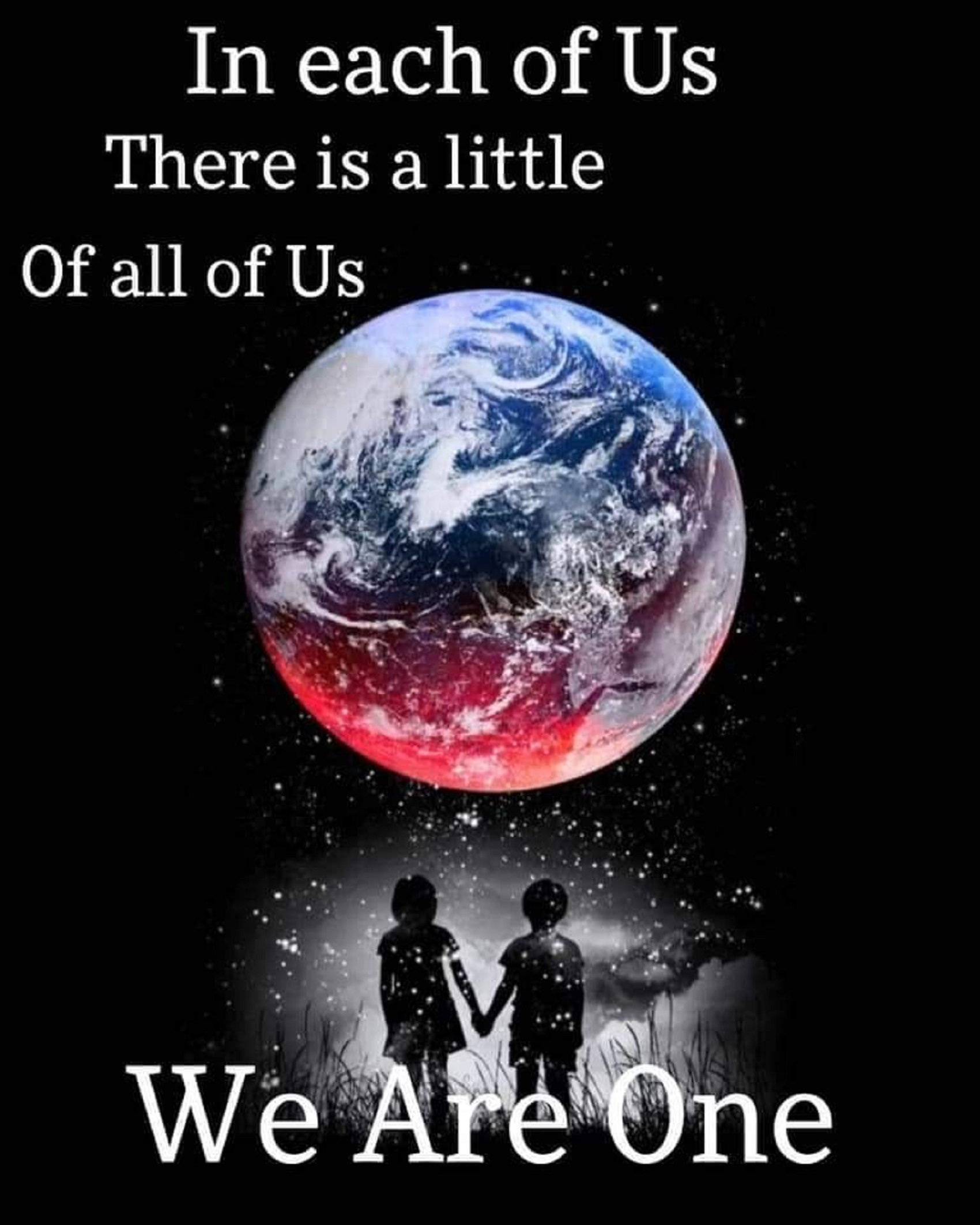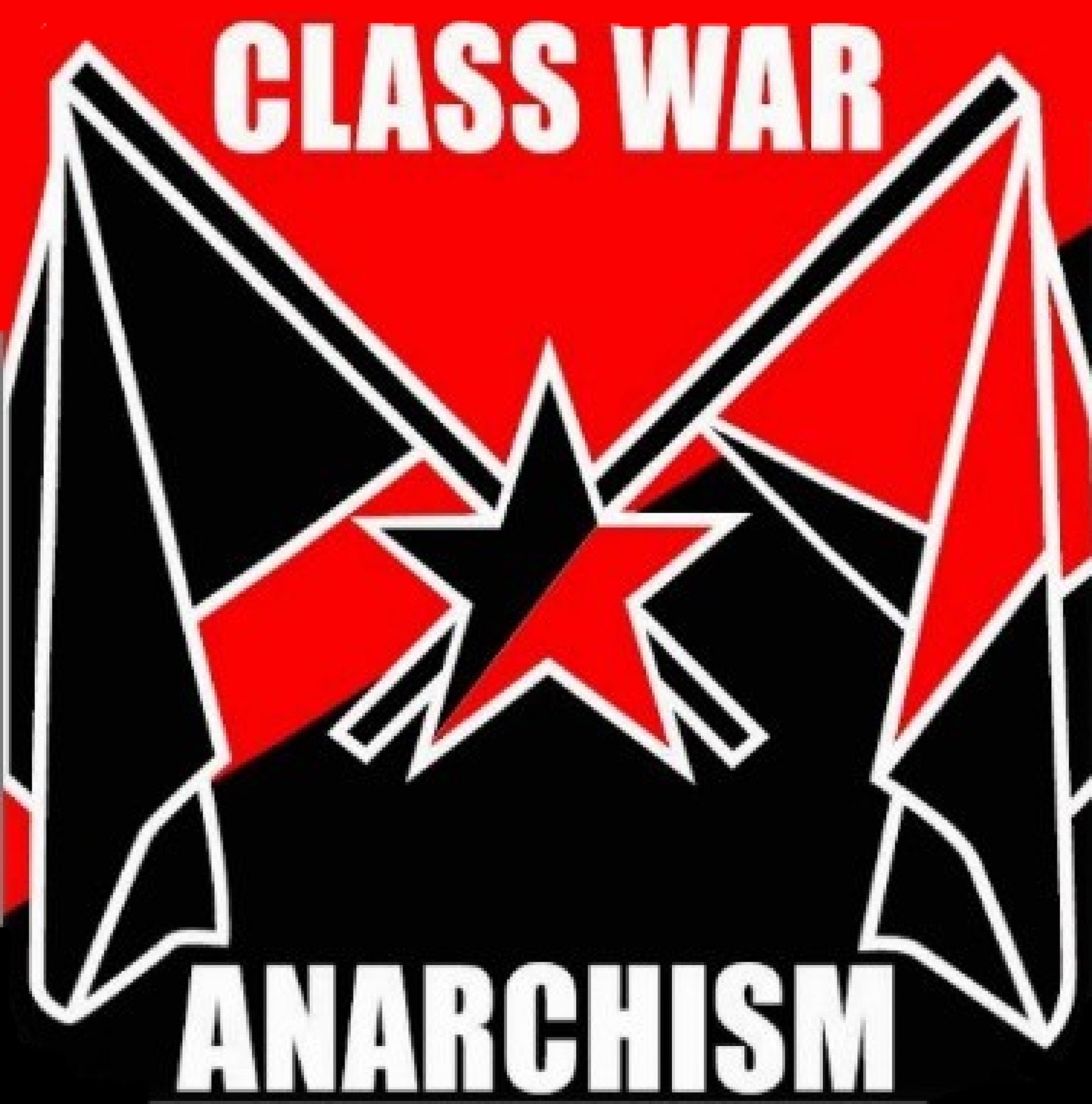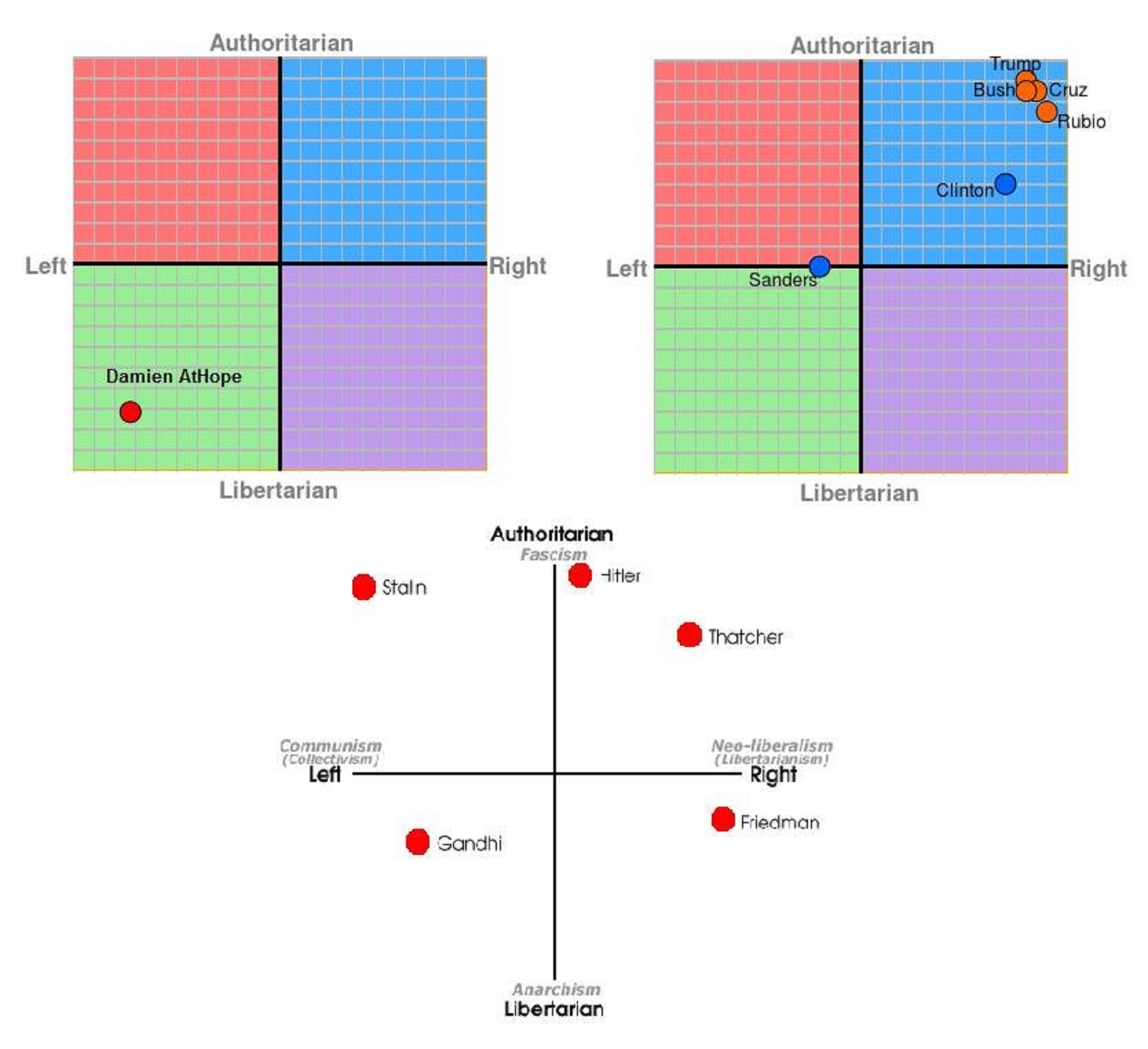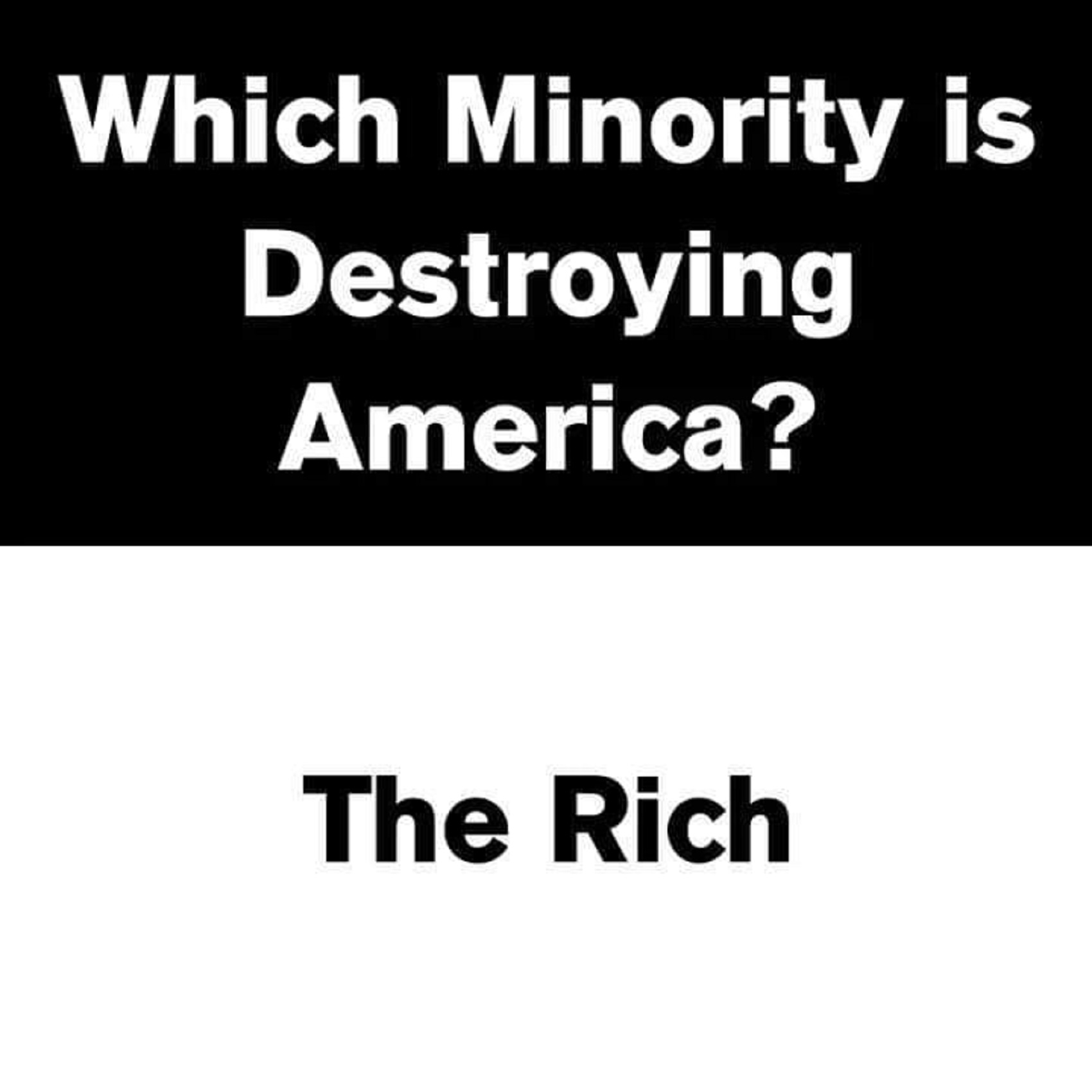
Green Anarchism: https://en.wikipedia.org/wiki/Green_anarchism
Eco-Anarchism: https://www.ecologicalcitizen.net/article.php?t=what-is-eco-anarchism
Anarcho-Naturism:https://en.wikipedia.org/wiki/Anarcho-naturism
Green Anarchism, Eco-Anarchism, and Anarcho-Naturism?
Green Anarchism, Eco-Anarchism, and Anarcho-Naturism: (VIDEO)
Less Imperialism Worship in Prehistory/History, PLEASE
Green Anarchism
“Green anarchism is an anarchist school of thought that puts a particular emphasis on environmental issues. A green anarchist theory is normally one that extends anarchism beyond a critique of human interactions and includes a critique of the interactions between humans and non-humans as well. This often culminates in an anarchist revolutionary praxis that is not merely dedicated to human liberation, but also to some form of nonhuman liberation and that aims to bring about an environmentally sustainable anarchist society. Important early influences were Henry David Thoreau, Leo Tolstoy, and Élisée Reclus. In the late 19th century, green anarchism emerged within individualist anarchist circles in Cuba, France, Portugal, and Spain.” ref
“Important contemporary currents include anarcho-naturism as the fusion of anarchism and naturist philosophies; anarcho-primitivism which offers a critique of technology and argues that anarchism is best suited to uncivilized ways of life; eco-anarchism which combines older trends of primitivism as well as bioregional democracy, eco-feminism, intentional community, pacifism and secession that distinguish it from the more general green anarchism; green syndicalism, a green anarchist political stance made up of anarcho-syndicalist views; social ecology which argues that the hierarchical domination of nature by human stems from the hierarchical domination of human by human.” ref
Early green anarchism
Henry David Thoreau
“Anarchism started to have an ecological view mainly in the writings of American anarchist and transcendentalist Henry David Thoreau. In his book Walden he advocates simple living and self-sufficiency among natural surroundings in resistance to the advancement of industrial civilization. The work is part personal declaration of independence, social experiment, voyage of spiritual discovery, satire, and manual for self-reliance. First published in 1854, it details Thoreau’s experiences over the course of two years, two months, and two days in a cabin he built near Walden Pond, amidst woodland owned by his friend and mentor Ralph Waldo Emerson, near Concord, Massachusetts. The book compresses the time into a single calendar year and uses passages of four seasons to symbolize human development. By immersing himself in nature, Thoreau hoped to gain a more objective understanding of society through personal introspection. Simple living and self-sufficiency were Thoreau’s other goals, and the whole project was inspired by transcendentalist philosophy, a central theme of the American Romantic Period. As Thoreau made clear in his book, his cabin was not in wilderness but at the edge of town, about two miles (3.2 km) from his family home.” ref
“As such “Many have seen in Thoreau one of the precursors of ecologism and anarcho-primitivism represented today in John Zerzan. For George Woodcock this attitude can be also motivated by certain idea of resistance to progress and of rejection of the growing materialism which is the nature of American society in the mid 19th century.” John Zerzan himself included the text “Excursions” (1863) by Thoreau in his edited compilation of writings called Against civilization: Readings and reflections from 1999.” ref
Élisée Reclus
“Élisée Reclus (15 March 1830 – 4 July 1905), also known as Jacques Élisée Reclus, was a renowned French geographer, writer and anarchist. He produced his 19-volume masterwork La Nouvelle Géographie universelle, la terre et les hommes (“Universal Geography”), over a period of nearly 20 years (1875–1894). In 1892, he was awarded the prestigious Gold Medal of the Paris Geographical Society for this work, despite his having been banished from France because of his political activism.” ref
“According to Kirkpatrick Sale:
His geographical work, thoroughly researched and unflinchingly scientific, laid out a picture of human-nature interaction that we today would call bioregionalism. It showed, with more detail than anyone but a dedicated geographer could possibly absorb, how the ecology of a place determined the kinds of lives and livelihoods its denizens would have and thus how people could properly live in self-regarding and self-determined bioregions without the interference of large and centralized governments that always try to homogenize diverse geographical areas.” ref
“For the authors of An Anarchist FAQ, Reclus “argued that a “secret harmony exists between the earth and the people whom it nourishes, and when imprudent societies let themselves violate this harmony, they always end up regretting it.” Similarly, no contemporary ecologist would disagree with his comments that the “truly civilized man [and women] understands that his [or her] nature is bound up with the interest of all and with that of nature. He [or she] repairs the damage caused by his predecessors and works to improve his domain.” ref
“Reclus advocated nature conservation and opposed meat-eating and cruelty to animals. He was a vegetarian. As a result, his ideas are seen by some historians as anticipating the modern social ecology and animal rights movements. Shortly before his death, Reclus completed L’Homme et la terre (1905). In it, he added to his previous greater works by considering humanity’s development relative to its geographical environment. Reclus was also an early proponent of naturism.” ref
“In the late 19th century, anarcho-naturism appeared as the union of anarchist and naturist philosophies. It had importance mainly within individualist anarchist circles in Cuba, France, Portugal, and Spain.” ref
“Anarcho-naturism advocated vegetarianism, free love, nudism, and an ecological world view within anarchist groups and outside them. Anarcho-naturism promoted an ecological worldview, small ecovillages, and most prominently nudism as a way to avoid the artificiality of the industrial mass society of modernity. Naturist individualist anarchists saw the individual in his biological, physical, and psychological aspects and tried to eliminate social determinations. Important promoters of this were Henri Zisly and Emile Gravelle who collaborated in La Nouvelle Humanité followed by Le Naturien, Le Sauvage, L’Ordre Naturel and La Vie Naturelle.” ref
Cuba
“The historian Kirwin R. Schaffer in his study of Cuban anarchism reports anarcho-naturism as “A third strand within the island’s anarchist movement” alongside anarcho-communism and anarcho-syndicalism. Naturism was a global alternative health and lifestyle movement. Naturists focused on redefining one’s life to live simply, eat cheap but nutritious vegetarian diets, and raise one’s own food if possible. The countryside was posited as a romantic alternative to urban living, and some naturists even promoted what they saw as the healthful benefits of nudism. Globally, the naturist movement counted anarchists, liberals, and socialists as its followers. However, in Cuba a particular “anarchist” dimension evolved led by people like Adrián del Valle, who spearheaded the Cuban effort to shift naturism’s focus away from only individual health to naturism having a “social emancipatory” function.” ref
“Schaffer reports the influence that anarcho-naturism had outside naturists circles. So “For instance, nothing inherently prevented an anarcho-syndicalist in the Havana restaurant workers’ union from supporting the alternative health care programs of the anarcho-naturists and seeing those alternative practices as “revolutionary.” “Anarcho-naturists promoted a rural ideal, simple living, and being in harmony with Nature as ways to save the laborers from the increasingly industrialized character of Cuba. Besides promoting an early twentieth-century “back-to-the-land” movement, they used these romantic images of Nature to illustrate how far removed a capitalist industrialized Cuba had departed from an anarchist view of natural harmony.” The main propagandizer in Cuba of anarcho-naturism was the Catalonia born “Adrián del Valle (aka Palmiro de Lidia) … Over the following decades, Del Valle became a constant presence in not only the anarchist press that proliferated in Cuba but also mainstream literary publications … From 1912 to 1913 he edited the freethinking journal El Audaz. Then he began his largest publishing job by helping to found and edit the monthly alternative health magazine that followed the anarcho-naturist line Pro-Vida.” ref
France
“Richard D. Sonn comments on the influence of naturist views in the wider French anarchist movement:
In her memoir of her anarchist years that was serialized in Le Matin in 1913, Rirette Maîtrejean made much of the strange food regimens of some of the compagnons. … She described the “tragic bandits” of the Bonnot gang as refusing to eat meat or drink wine, preferring plain water. Her humorous comments reflected the practices of the “naturist” wing of individualist anarchists who favored a simpler, more “natural” lifestyle centered on a vegetarian diet. In the 1920s, this wing was expressed by the journal Le Néo-Naturien, Revue des Idées Philosophiques et Naturiennes. Contributors condemned the fashion of smoking cigarettes, especially by young women; a long article of 1927 actually connected cigarette smoking with cancer! Others distinguished between vegetarians, who foreswore the eating of meat, from the stricter “vegetalians,” who ate nothing but vegetables. An anarchist named G. Butaud, who made this distinction, opened a restaurant called the Foyer Végétalien in the nineteenth arrondissement in 1923. Other issues of the journal included vegetarian recipes. In 1925, when the young anarchist and future detective novelist Léo Malet arrived in Paris from Montpellier, he initially lodged with anarchists who operated another vegetarian restaurant that served only vegetables, with neither fish nor eggs. Nutritional concerns coincided with other means of encouraging health bodies, such as nudism and gymnastics. For a while in the 1920s, after they were released from jail for antiwar and birth-control activities, Jeanne and Eugène Humbert retreated to the relative safety of the “integral living” movement that promoted nude sunbathing and physical fitness, which were seen as integral aspects of health in the Greek sense of gymnos, meaning nude. This back-to-nature, primitivist current was not a monopoly of the left; the same interests were echoed by right-wing Germans in the interwar era. In France, however, these proclivities were mostly associated with anarchists, insofar as they suggested an ideal of self-control and the rejection of social taboos and prejudices.” ref
Henri Zisly
“Henri Zisly (2 November 1872–1945) was a French individualist anarchist and naturist.[a] He participated alongside Henri Beylie and Émile Gravelle in many journals such as La Nouvelle Humanité and La Vie Naturelle, which promoted anarchist-naturism. In 1902, he was one of the main initiators, alongside Georges Butaud and Sophie Zaïkowska, of the cooperative Colonie de Vaux established in Essômes-sur-Marne, in Aisne.” ref
“Zisly’s political activity, “primarily aimed at supporting a return to ‘natural life’ through writing and practical involvement, stimulated lively confrontations within and outside the anarchist environment. Zisly vividly criticized progress and civilization, which he regarded as ‘absurd, ignoble, and filthy.’ He openly opposed industrialization, arguing that machines were inherently authoritarian, defended nudism, advocated a non-dogmatic and non-religious adherence to the ‘laws of nature,’ recommended a lifestyle based on limited needs and self-sufficiency, and disagreed with vegetarianism, which he considered ‘anti-scientific.” ref
Spain
“Anarcho-naturism was quite important at the end of the 1920s in the Spanish anarchist movement[24] In France, later important propagandists of anarcho-naturism include Henri Zisly[33] and Émile Gravelle whose ideas were important in individualist anarchist circles in Spain, where Federico Urales (pseudonym of Joan Montseny) promoted the ideas of Gravelle and Zisly in La Revista Blanca (1898–1905):” ref
“The linking role played by the Sol y Vida group was very important. The goal of this group was to take trips and enjoy the open air. The Naturist athenaeum, Ecléctico, in Barcelona, was the base from which the activities of the group were launched. First Etica and then Iniciales, which began in 1929, were the publications of the group, which lasted until the Spanish Civil War. We must be aware that the naturist ideas expressed in them matched the desires that the libertarian youth had of breaking up with the conventions of the bourgeoisie of the time. That is what a young worker explained in a letter to Iniciales. He writes it under the odd pseudonym of silvestre del campo (wild man in the country). “I find great pleasure in being naked in the woods, bathed in light and air, two natural elements we cannot do without. By shunning the humble garment of an exploited person, (garments which, in my opinion, are the result of all the laws devised to make our lives bitter), we feel there no others left but just the natural laws. Clothes mean slavery for some and tyranny for others. Only the naked man who rebels against all norms, stands for anarchism, devoid of the prejudices of outfit imposed by our money-oriented society.” ref
“The “relation between Anarchism and Naturism gives way to the Naturist Federation, in July 1928, and to the lV Spanish Naturist Congress, in September 1929, both supported by the Libertarian Movement. However, in the short term, the Naturist and Libertarian movements grew apart in their conceptions of everyday life. The Naturist movement felt closer to the Libertarian individualism of some French theoreticians such as Henri Ner (real name of Han Ryner) than to the revolutionary goals proposed by some Anarchist organizations such as the FAI, (Federación Anarquista Ibérica)”. This ecological tendency in Spanish anarchism was strong enough as to call the attention of the CNT–FAI in Spain.” ref
“Daniel Guérin in Anarchism: From Theory to Practice reports:
Spanish anarcho-syndicalism had long been concerned to safeguard the autonomy of what it called “affinity groups.” There were many adepts of naturism and vegetarianism among its members, especially among the poor peasants of the south. Both these ways of living were considered suitable for the transformation of the human being in preparation for a libertarian society. At the Saragossa congress the members did not forget to consider the fate of groups of naturists and nudists, “unsuited to industrialization.” As these groups would be unable to supply all their own needs, the congress anticipated that their delegates to the meetings of the confederation of communes would be able to negotiate special economic agreements with the other agricultural and industrial communes. On the eve of a vast, bloody, social transformation, the CNT did not think it foolish to try to meet the infinitely varied aspirations of individual human beings.” ref
Isaac Puente
“Isaac Puente was an influential Spanish anarchist during the 1920s and 1930s and an important propagandist of anarcho-naturism, was a militant of both the CNT anarcho-syndicalist trade union and Iberian Anarchist Federation. He published the book El Comunismo Libertario y otras proclamas insurreccionales y naturistas (en:Libertarian Communism and other insurrectionary and naturist proclamations) in 1933, which sold around 100,000 copies, and wrote the final document for the Extraordinary Confederal Congress of Zaragoza of 1936 which established the main political line for the CNT for that year. Puente was a doctor who approached his medical practice from a naturist point of view. He saw naturism as an integral solution for the working classes, alongside Neo-Malthusianism, and believed it concerned the living being while anarchism addressed the social being. He believed capitalist societies endangered the well-being of humans from both a socioeconomic and sanitary viewpoint, and promoted anarcho-communism alongside naturism as a solution.” ref
Other Countries
“Naturism also met anarchism in the United Kingdom. “In many of the alternative communities established in Britain in the early 1900s nudism, anarchism, vegetarianism, and free love were accepted as part of a politically radical way of life. In the 1920s the inhabitants of the anarchist community at Whiteway, near Stroud in Gloucestershire, shocked the conservative residents of the area with their shameless nudity.” In Italy, during the IX Congress of the Italian Anarchist Federation in Carrara in 1965, a group decided to split off from this organization and created the Gruppi di Iniziativa Anarchica. In the seventies, it was mostly composed of “veteran individualist anarchists with an orientation of pacifism, naturism, etc, …”. American anarcho-syndicalist Sam Dolgoff shows some of the criticism that some people on the other anarchist currents at the time had for anarcho-naturist tendencies. “Speaking of life at the Stelton Colony of New York in the 1930s, noted with disdain that it, “like other colonies, was infested by vegetarians, naturists, nudists, and other cultists, who sidetracked true anarchist goals.” One resident “always went barefoot, ate raw food, mostly nuts and raisins, and refused to use a tractor, being opposed to machinery, and he didn’t want to abuse horses, so he dug the earth himself.” Such self-proclaimed anarchists were in reality “ox-cart anarchists,” Dolgoff said, “who opposed organization and wanted to return to a simpler life.” In an interview with Paul Avrich before his death, Dolgoff also grumbled, “I am sick and tired of these half-assed artists and poets who object to organization and want only to play with their belly buttons.”.” ref
Leo Tolstoy and Tolstoyanism
“Russian Christian anarchist and anarcho-pacifist Leo Tolstoy is also recognized as an early influence in green anarchism.[3] The novelist was struck by the description of Christian, Buddhist, and Hindu ascetic renunciation as being the path to holiness. After reading passages such as the following, which abound in Schopenhauer’s ethical chapters, the Russian nobleman chose poverty and formal denial of the will:” ref
“But this very necessity of involuntary suffering (by poor people) for eternal salvation is also expressed by that utterance of the Savior (Matthew 19:24): “It is easier for a camel to go through the eye of a needle, than for a rich man to enter into the kingdom of God.” Therefore those who were greatly in earnest about their eternal salvation, chose voluntary poverty when fate had denied this to them and they had been born in wealth. Thus Buddha Sakyamuni was born a prince, but voluntarily took to the mendicant’s staff; and Francis of Assisi, the founder of the mendicant orders who, as a youngster at a ball, where the daughters of all the notabilities were sitting together, was asked: “Now Francis, will you not soon make your choice from these beauties?” and who replied: “I have made a far more beautiful choice!” “Whom?” “La povertà (poverty)”: whereupon he abandoned every thing shortly afterwards and wandered through the land as a mendicant.” ref
“Despite his misgivings about anarchist violence, Tolstoy took risks to circulate the prohibited publications of anarchist thinkers in Russia, and corrected the proofs of Kropotkin’s “Words of a Rebel”, illegally published in St Petersburg in 1906. Tolstoy was enthused by the economic thinking of Henry George, incorporating it approvingly into later works such as Resurrection, the book that played a major factor in his excommunication. Tolstoyans identify themselves as Christians, but do not generally belong to an institutional Church. They attempt to live an ascetic and simple life, preferring to be vegetarian, non-smoking, teetotal, and chaste. Tolstoyans are considered Christian pacifists and advocate nonresistance in all circumstances. They do not support or participate in the government which they consider immoral, violent, and corrupt. Tolstoy rejected the state (as it only exists on the basis of physical force) and all institutions that are derived from it—the police, law courts and army.” ref
“Tolstoy influenced Mohandas Karamchand Gandhi who set up a cooperative colony called Tolstoy Farm near Johannesburg, South Africa, having been inspired by Tolstoy’s ideas. The colony comprising 1,100 acres (450 ha) was funded by the Gandhian Herman Kallenbach and placed at the disposal of the satyagrahis from 1910. He also inspired similar communal experiments in the United States where the residents were also influenced by the views of Henry George and Edward Bellamy as well as in Russia, England, and the Netherlands.” ref
Mid-20th century
“Several anarchists from the mid-20th century like Herbert Read, Ethel Mannin, Leopold Kohr, and Paul Goodman held proto-environmental views linked to their anarchism. Mannin’s 1944 book Bread and Roses: A Utopian Survey and Blue-Print has been described by anarchist historian Robert Graham as setting forth “an ecological vision in opposition to the prevailing and destructive industrial organization of society”.” ref
Leopold Kohr
“Leopold Kohr (5 October 1909 – 26 February 1994) was an economist, philosopher, and political scientist best known for his opposition to the “cult of bigness” in social organization and as one of those who initiated the small is beautiful movement. For almost twenty years he was Professor of Economics and Public Administration at the University of Puerto Rico. He described himself as a philosophical anarchist. In 1937, Kohr became a freelance correspondent during the Spanish Civil War, where he was impressed by the limited, self-contained governments of the separatist states of Catalonia and Aragon, as well as the small Spanish anarchist city-states of Alcoy and Caspe. In his first published essay “Disunion Now: A Plea for a Society based upon Small Autonomous Units”, published in Commonweal in 1941, Kohr wrote about a Europe at war: “We have ridiculed the many little states, now we are terrorized by their few successors.” He called for the breakup of Europe into hundreds of city-states. Kohr developed his ideas in a series of books, including The Breakdown of Nations (1957), Development without Aid (1973), and The Overdeveloped Nations (1977).” ref
“From Leopold Kohr’s most popular work The Breakdown of Nations:
[T]here seems to be only one cause behind all forms of social misery: bigness. Oversimplified as this may seem, we shall find the idea more easily acceptable if we consider that bigness, or oversize, is really much more than just a social problem. It appears to be the one and only problem permeating all creation. Whenever something is wrong, something is too big. […] And if the body of a people becomes diseased with the fever of aggression, brutality, collectivism, or massive idiocy, it is not because it has fallen victim to bad leadership or mental derangement. It is because human beings, so charming as individuals or in small aggregations, have been welded into overconcentrated social units.” ref
“Later in his academic and writing career he protested the “cult of bigness” and economic growth and promoted the concept of human scale and small community life. He argued that massive external aid to poorer nations stifled local initiatives and participation. His vision called for a dissolution of centralized political and economic structures in favor of local control. Kohr was an important inspiration to the Green, bioregional, Fourth World, decentralist, and anarchist movements, Kohr contributed often to John Papworth‘s Journal for the Fourth World and Resurgence. One of Kohr’s students was economist E. F. Schumacher, another prominent influence on these movements, whose best-selling book Small Is Beautiful took its title from one of Kohr’s core principles. Similarly, his ideas inspired Kirkpatrick Sale‘s books Human Scale (1980) and Dwellers in the Land: The Bioregional Vision (1985). Sale arranged the first American publication of The Breakdown of Nations in 1978 and wrote the foreword.” ref
Murray Bookchin
“Murray Bookchin (14 January 1921 – 30 July 2006) was an American libertarian socialist author, orator, and philosopher. In 1958, Murray Bookchin defined himself as an anarchist,[60] seeing parallels between anarchism and ecology. His first book, Our Synthetic Environment, was published under the pseudonym Lewis Herber in 1962, a few months before Rachel Carson‘s Silent Spring. The book described a broad range of environmental ills but received little attention because of its political radicalism. His groundbreaking essay “Ecology and Revolutionary Thought” introduced ecology as a concept in radical politics. In 1968 he founded another group that published the influential Anarchos magazine, which published that and other innovative essays on post-scarcity and on ecological technologies such as solar and wind energy, and on decentralization and miniaturization. Lecturing throughout the United States, he helped popularize the concept of ecology to the counterculture.” ref
“Post-Scarcity Anarchism is a collection of essays written by Murray Bookchin and first published in 1971 by Ramparts Press. It outlines the possible form anarchism might take under conditions of post-scarcity. It is one of Bookchin’s major works, and its radical thesis provoked controversy for being utopian and messianic in its faith in the liberatory potential of technology. Bookchin argues that post-industrial societies are also post-scarcity societies, and can thus imagine “the fulfillment of the social and cultural potentialities latent in a technology of abundance”. The self-administration of society is now made possible by technological advancement and, when technology is used in an ecologically sensitive manner, the revolutionary potential of society will be much changed.” ref
“In 1982, his book The Ecology of Freedom had a profound impact on the emerging ecology movement, both in the United States and abroad. He was a principal figure in the Burlington Greens in 1986-90, an ecology group that ran candidates for city council on a program to create neighborhood democracy. In From Urbanization to Cities (originally published in 1987 as The Rise of Urbanization and the Decline of Citizenship), Bookchin traced the democratic traditions that influenced his political philosophy and defined the implementation of the libertarian municipalism concept. A few years later The Politics of Social Ecology, written by his partner of 20 years, Janet Biehl, briefly summarized these ideas.” ref
Jacques Ellul
“Jacques Ellul (6 January 1912 – 19 May 1994) was a French philosopher, law professor, sociologist, lay theologian, and Christian anarchist. He wrote several books about Christianity, the technological society, propaganda, and the interaction between religion and politics. Professor of History and the Sociology of Institutions on the Faculty of Law and Economic Sciences at the University of Bordeaux, he authored 58 books and more than a thousand articles over his lifetime in all, the dominant theme of which has been the threat to human freedom and religion created by modern technique. The Ellulian concept of technique is briefly defined within the “Notes to Reader” section of The Technological Society (1964). What many consider to be Ellul’s most important work, The Technological Society (1964) was originally titled: La Technique: L’enjeu du siècle (literally, “The Stake of the Century”). In it, Ellul set forth seven characteristics of modern technology that make efficiency a necessity: rationality, artificiality, automatism of technical choice, self-augmentation, monism, universalism, and autonomy.” ref
“For Ellul the rationality of technique enforces logical and mechanical organization through division of labor, the setting of production standards, etc. And it creates an artificial system which “eliminates or subordinates the natural world.” Today, he argues, the technological society is generally held sacred (cf. Saint Steve Jobs). Since he defines technique as “the totality of methods rationally arrived at, and having absolute efficiency (for a given stage of development) in every field of human activity”, it is clear that his sociological analysis focuses not on the society of machines as such, but on the society of “efficient techniques”.” ref
Contemporary developments
Communalism and social ecology
“Social ecology is closely related to the work and ideas of Murray Bookchin and influenced by anarchist Peter Kropotkin. Social ecologists assert that the present ecological crisis has its roots in human social problems, and that the domination of human-over-nature stems from the domination of human-over-human.” ref
“Bookchin later developed a political philosophy to complement social ecology which he called “Communalism” (spelled with a capital “C” to differentiate it from other forms of communalism). While originally conceived as a form of Social anarchism, he later developed Communalism into a separate ideology which incorporates what he saw as the most beneficial elements of Anarchism, Marxism, syndicalism, and radical ecology.” ref
“Politically, Communalists advocate a network of directly democratic citizens’ assemblies in individual communities/cities organized in a confederal fashion. This method used to achieve this is called Libertarian Municipalism which involves the establishment of face-to-face democratic institutions which are to grow and expand confederally with the goal of eventually replacing the nation-state.” ref
“Janet Biehl (born 1953) is a writer associated with social ecology, the body of ideas developed and publicized by Murray Bookchin. In 1986, she attended the Institute for Social Ecology and there, began a collaborative relationship with Bookchin, working intensively with him over the next two decades in the explication of social ecology from their shared home in Burlington, Vermont.” ref
“From 1987 to 2000, she and Bookchin co-wrote and co-published the theoretical newsletter Green Perspectives, later renamed Left Green Perspectives. She is the editor and compiler of The Murray Bookchin Reader (1997); the author of The Politics of Social Ecology: Libertarian Municipalism (1998) and Rethinking Ecofeminist Politics (1991); and co-author (with Peter Staudenmaier) of Ecofascism: Lessons from the German Experience (1995).” ref
Green Anarchist
“The magazine Green Anarchist was for a while the principal voice in the United Kingdom advocating green anarchism, an explicit fusion of libertarian socialist and ecological thinking. Founded after the 1984 Stop the City protests, the magazine was launched in the summer of that year by an editorial collective consisting of Alan Albon, Richard Hunt, and Marcus Christo. Early issues featured a range of broadly anarchist and ecological ideas, bringing together groups and individuals as varied as Class War, veteran anarchist writer Colin Ward, anarcho-punk band Crass as well as the Peace Convoy, anti-nuclear campaigners, animal rights activists, and so on. However, the diversity that many saw as the publication’s greatest strength quickly led to irreconcilable arguments between the essentially pacifist approach of Albon and Christo, and the advocacy of violent confrontation with the state favored by Hunt.” ref
“During the 1990s, Green Anarchist came under the helm of an editorial collective that included Paul Rogers, Steve Booth, and others, during which period the publication became increasingly aligned with primitivism, as well as an anti-civilization philosophy advocated by writers such as John Zerzan and Fredy Perlman. Starting in 1995, Hampshire Police began a series of at least 56 raids, code-named ‘Operation Washington’, that eventually resulted in the August to November 1997 Portsmouth trial of Green Anarchist editors Booth, Saxon Wood, Noel Molland, and Paul Rogers, as well as Animal Liberation Front (ALF) Press Officer Robin Webb and Animal Liberation Front Supporters Group (ALFSG) newsletter editor Simon Russell. The defendants organized the GANDALF Defence campaign. Three of the editors of Green Anarchist, Noel Molland, Saxon Wood, and Booth were jailed for ‘conspiracy to incite’. However, all three were shortly afterwards released on appeal.” ref
Fredy Perlman
Fredy Perlman (August 20, 1934 – July 26, 1985) was a Czech-born, naturalized American author, publisher, and militant. His most popular work, the book Against His-Story, Against Leviathan!, details the rise of state domination with a retelling of history through the Hobbesian metaphor of the Leviathan. The book remains a major source of inspiration for anti-civilization perspectives in contemporary anarchism, most notably on the thought of philosopher John Zerzan.” ref
Anarcho-Primitivism
“Anarcho-primitivism is an anarchist critique of the origins and progress of civilization. According to anarcho-primitivism, the shift from hunter-gatherer to agricultural subsistence gave rise to social stratification, coercion, and alienation. Anarcho-primitivists advocate a return to non-“civilized” ways of life through deindustrialisation, abolition of the division of labor or specialization, and abandonment of large-scale organization technologies. There are other non-anarchist forms of primitivism, and not all primitivists point to the same phenomenon as the source of modern, civilized problems. Anarcho-primitivists are often distinguished by their focus on the praxis of achieving a feral state of being through “rewilding“.” ref
John Zerzan
“John Zerzan is an American anarchist and primitivist philosopher and author. His works criticize agricultural civilization as inherently oppressive, and advocate drawing upon the ways of life of hunter-gatherers as an inspiration for what a free society should look like. Some subjects of his criticism include domestication, language, symbolic thought (such as mathematics and art), and the concept of time.” ref
“His five major books are Elements of Refusal (1988), Future Primitive and Other Essays (1994), Running on Emptiness (2002), Against Civilization: Readings and Reflections (2005), and Twilight of the Machines (2008). Zerzan was one of the editors of Green Anarchy, a controversial journal of anarcho-primitivist and insurrectionary anarchist thought. He is also the host of Anarchy Radio in Eugene on the University of Oregon‘s radio station KWVA. He has also served as a contributing editor at Anarchy Magazine and has been published in magazines such as AdBusters. He does extensive speaking tours around the world, and is married to an independent consultant to museums and other nonprofit organizations. In 1974, Black and Red Press published Unions Against Revolution by Spanish ultra-left theorist Grandizo Munis that included an essay by Zerzan which previously appeared in the journal Telos. Over the next 20 years, Zerzan became intimately involved with the Fifth Estate, Anarchy: A Journal of Desire Armed, Demolition Derby, and other anarchist periodicals. He began to question civilization in the early 80’s, after having sought to confront issues around the neutrality of technology and division of labor, at the time when Fredy Perlman was making similar conclusions.” ref
Green Anarchy
“Green Anarchy was a magazine published by a collective located in Eugene, Oregon. The magazine’s focus was primitivism, post-left anarchy, radical environmentalism, African American struggles, anarchist resistance, indigenous resistance, earth and animal liberation, anti-capitalism, and supporting political prisoners. It had a circulation of 8,000, partly in prisons, the prison subscribers given free copies of each issue as stated in the magazine. Green Anarchy was started in 2000 and in 2009 the Green Anarchy website shut down, leaving a final, brief message about the cessation of the magazine’s publication. The subtitle of the magazine is “An Anti-Civilization Journal of Theory and Action”. Author John Zerzan was one of the publication’s editors.” ref
Species Traitor
“Species Traitor is a sporadically published journal of insurrectionary anarcho-primitivism. It is printed as a project of Black and Green Network and edited by anarcho-primitivist writer, Kevin Tucker. ST was initially labeled as a project of the Coalition Against Civilization (CAC) and the Black and Green Network (BAG). The CAC was started towards the end of 1999 in the aftermath of the massive street protests in Eugene (Reclaim the Streets) and in Seattle (WTO) of that year. That aftermath gave a new voice and standing for green anarchist and anarcho-primitivist writers and viewpoints within both the anarchist milieu and the culture at large. The first issue came out in the winter of 2000-2001 (currently out of print) and contained a mix of reprints and some original articles from Derrick Jensen and John Zerzan among others. Issue two came in the following year in the wake of Sept. 11 and took a major step from the first issue in becoming something of its own rather than another mouthpiece of green anarchist rhetoric. The articles took a more in-depth direction opening a more analytical and critical draw between anarchy and anthropology, attacks on Reason, and the Progress/linear views of human history and Future that stand at the base of the ideology of civilization.” ref
Veganarchism
“Veganarchism, or vegan anarchism, is the political philosophy of veganism (more specifically animal liberation and earth liberation) and anarchism, creating a combined praxis that is designed to be a means for social revolution. This encompasses viewing the state as unnecessary and harmful to animals, both human and non-human, whilst practising a vegan lifestyle. It is either perceived as a combined theory, or that both philosophies are essentially the same. It is further described as an anti-speciesist perspective on green anarchism, or an anarchist perspective on animal liberation.” ref
“Veganarchists typically view oppressive dynamics within society to be interconnected, from statism, racism, and sexism to human supremacy and redefine veganism as a radical philosophy that sees the state as harmful to animals. Those who believe in veganarchy can be either against reform for animals or for it, although do not limit goals to changes within the law.” ref
Layla AbdelRahim
“Layla AbdelRahim is a Canadian anthropologist and author. Her work critiques civilization, technologies, and, what she calls a “predatory anthropology”. In Children’s Literature, Domestication, and Social Foundation: Narratives of Civilization and Wilderness (2015), she attributes the Holocene extinction and climate change to the human choice of hunting as a cultural choice for subsistence. This anthropological revolution in human self-construction as predator, she argues, generated the need for developing the technologies that would ensure the propagation of a predatory culture and violence. “The first of these technologies is … the technology of absence. …” ref
“This entails physical and emotional absence, but also includes a metaphysical dimension, since technological development is literally linked to death. Namely, the rise of hunting, i.e. killing of others for food, during the Upper Palaeolithic period in the Middle East led some human groups to develop hunting technologies”. She cites palaeoanthropologist Clive Gamble who connects this development in hunting technologies to colonization[87] and the work of anthropologist Richard Lee (1988) who links the appearance of human language to the rise in hunting activities during that period. AbdelRahim concludes that hunting “thus led to domestication, and both of these cultures of subsistence kill intentionally and on a systematic basis”. Civilization with its cultural, political, and social institutions that classify living beings for the purpose of exploitation, she says, is the material manifestation of this cultural choice and anthropology.” ref
“Wild Children – Domesticated Dreams: Civilization and the Birth of Education (2013) argues that civilized child rearing cultures are based on the principles of animal domestication. The institutions of education are responsible for the generation of the epistemology of predation and for the propagation of its ideology through scientific texts, pedagogical methods, and fictional narratives.” ref
Total Liberation
“Total liberationism is a form of green anarchism that combines an opposition to all forms of human oppression with a commitment to animal and earth liberation. Whilst more conventional approaches to anarchist politics typically maintain a tacit assumption of anthropocentrism, proponents of total liberation espouse a holistic revolutionary strategy aimed at identifying the intersections between all forms of domination and social hierarchy, and building alliances between individual political movements in order to integrate them into a single movement aimed at abolishing a range of social structures such as the state, capitalism, patriarchy, racism, heterosexism, cissexism, disablism, ageism, speciesism, and ecological domination.” ref
“As David Pellow summarises:
The concept of total liberation stems from a determination to understand and combat all forms of inequality and oppression. I propose that it comprises four pillars: (1) an ethic of justice and anti-oppression inclusive of humans, nonhuman animals, and ecosystems; (2) anarchism; (3) anti-capitalism; and (4) an embrace of direct action tactics.” ref
Derrick Jensen
“Derrick Jensen is an American author and environmental activist (and critic of mainstream environmentalism) living in Crescent City, California. Jensen’s work is sometimes characterized as anarcho-primitivist, although he has categorically rejected that label, describing primitivist as a “racist way to describe indigenous peoples.” He prefers to be called “indigenist” or an “ally to the indigenous,” because “indigenous peoples have had the only sustainable human social organizations, and … we need to recognize that we [colonizers] are all living on stolen land.” ref
“A Language Older Than Words uses the lens of domestic violence to look at the larger violence of western culture. The Culture of Make Believe begins by exploring racism and misogyny and moves to examine how this culture’s economic system leads inevitably to hatred and atrocity. Strangely Like War is about deforestation. Walking on Water is about education (It begins: “As is true for most people I know, I’ve always loved learning. As is also true for most people I know, I always hated school. Why is that?”).” ref
“Welcome to the Machine is about surveillance, and more broadly about science and what he perceives to be a Western obsession with control. Resistance Against Empire consists of interviews with J. W. Smith (on poverty), Kevin Bales (on slavery), Anuradha Mittal (on hunger), Juliet Schor (‘globalization’ and environmental degradation), Ramsey Clark (on US ‘defense’), Stephen Schwartz (editor of The Nonproliferation Review, on nukes), Alfred McCoy (politics and heroin), Christian Parenti (the US prison system), Katherine Albrecht (on RFID), and Robert McChesney (on (freedom of) the media) conducted between 1999 and 2004.” ref
“Endgame is about what he describes as the inherent unsustainability of civilization. In this book he asks: “Do you believe that this culture will undergo a voluntary transformation to a sane and sustainable way of living?” Nearly everyone he talks to says no. His next question is: “How would this understanding — that this culture will not voluntarily stop destroying the natural world, eliminating indigenous cultures, exploiting the poor, and killing those who resist — shift our strategy and tactics? The answer? Nobody knows, because we never talk about it: we’re too busy pretending the culture will undergo a magical transformation.” Endgame, he says, is “about that shift in strategy, and in tactics.” Jensen co-wrote the book Deep Green Resistance: Strategy to Save the Planet with Lierre Keith and Aric McBay.” ref
CrimethInc
“CrimethInc. is a decentralized anarchist collective of autonomous cells. CrimethInc. emerged in the mid-1990s, initially as the hardcore zine Inside Front, and began operating as a collective in 1996. It has since published widely read articles and zines for the anarchist movement and distributed posters and books of its own publication. Individuals adopting the CrimethInc. nom de guerre have included convicted ELF arsonists, as well as hacktivists who successfully attacked the websites of DARE, Republican National Committee, and sites related to U.S. President George W. Bush‘s 2004 re-election campaign. The creation of propaganda has been described as the collectives’ core function. Among their best-known publications are the books Days of War, Nights of Love, Expect Resistance, Evasion, Recipes for Disaster: An Anarchist Cookbook and the pamphlet Fighting For Our Lives (of which, to date, they claim to have printed 600,000 copies), the hardcore punk/political zine Inside Front, and the music of hardcore punk bands. As well as the traditional anarchist opposition to the state and capitalism, agents have, at times, advocated a straight edge lifestyle, the total supersession of gender roles, violent insurrection against the state, and the refusal of work.” ref
Direct action
“Some green anarchists engage in direct action (not to be confused with ecoterrorism). Organizing themselves through groups like Earth First!, Root Force, or more drastically the Earth Liberation Front ELF, Earth Liberation Army (ELA), and Animal Liberation Front (ALF). They may take direct action against what they see as systems of oppression, such as the logging industry, the meat and dairy industries, animal testing laboratories, genetic engineering facilities, and, more rarely, government institutions.” ref
“Such actions are usually, though not always, non-violent, with groups such as The Olga Cell attempting assassinations of nuclear scientists, and other related groups sending letterbombs to nano tech and nuclear tech-related targets. Though not necessarily Green anarchists, activists have used the names Animal Rights Militia, Justice Department, and Revolutionary Cells among others, to claim responsibility for openly violent attacks.” ref
Convictions
“Rod Coronado is an eco-anarchist and is an unofficial spokesperson for the Animal Liberation Front and Earth Liberation Front. On 28 February 1992, Coronado carried out an arson attack on research facilities at Michigan State University (MSU) and released mink from a nearby research farm on campus, an action claimed by the ALF, and for which Coronado was subsequently convicted.” ref
“In 1997, the editors of Green Anarchist magazine and two British supporters of the Animal Liberation Front were tried in connection with conspiracy to incite violence, in what came to be known as the GANDALF trial.” ref
“Green anarchist Tre Arrow was sought by the FBI in connection with an ELF arson on 15 April 2001 at Ross Island Sand and Gravel in Portland, torching three trucks amounting of $200,000 in damage. Another arson occurred a month later at Ray Schoppert Logging Company in Estacada, Oregon, on 1 June 2001 against logging trucks and a front loader, resulting in $50,000 damage. Arrow was indicted by a federal grand jury in Oregon and charged with four felonies for this crime on 18 October 2002. On 13 March 2004, after fleeing to British Columbia, he was arrested in Victoria for stealing bolt cutters and was also charged with being in Canada illegally. He was then sentenced on 12 August 2008 to 78 months in federal prison for his part in the arson and conspiracy ELF attacks in 2001.” ref
“In January 2006, Eric McDavid, a green anarchist, was convicted of conspiring to use fire or explosives to damage corporate and government property. On 8 March 2006, he formally declared a hunger strike due to the jail refusing to provide him with vegan food. He has been given vegan food off and on since. In September 2007, he was convicted on all counts after the two activists he conspired with pleaded guilty and testified against him. An FBI confidential source named “Anna” was revealed as a fourth participant, in what McDavid’s defense argued was entrapment. In May 2008, he was sentenced to nearly 20 years in prison.” ref
“On 3 March 2006, a federal jury in Trenton, New Jersey convicted six members of SHAC, including green-anarchist Joshua Harper, for “terrorism and Internet stalking”, according to the New York Times, finding them guilty of using their website to “incite attacks” on those who did business with Huntingdon Life Sciences HLS. In September 2006, the SHAC 7 received jail sentences of 3 to 6 years.” ref
Other prisoners
- “Marco Camenisch, a Swiss green anarchist accused of arson against electricity pylon.
- Nicole Vosper, a green anarchist who pleaded guilty to charges against HLS.
- Marius Mason (born Marie Jeanette Mason), who is serving 21 years and 10 months (#04672-061, FMC Carswell, Federal Medical Center, P.O. Box 27137, Fort Worth, TX 76127, USA) for his involvement in an ELF arson against a University building carrying out Genetically Modified crop tests. Marius also pleaded guilty to conspiring to carry out ELF actions and admitted involvement in 12 other ELF actions. (vegan).” ref
Green Syndicalism
“Green syndicalism is a synthesis of anarcho-syndicalism and environmentalism, arguing that protection of the environment depends on decentralization, regionalism, direct action, autonomy, pluralism, and federation. It largely draws inspiration from the green bans in Australia, the efforts of workers at Lucas Aerospace to convert their factories away from armaments production, and Judi Bari‘s efforts in the IWW to organize timber workers and environmentalists in Northern California. Green syndicalism has been advocated for at various times by Confédération Nationale du Travail, the Confederación General de Trabajadores, and the Central Organisation of the Workers of Sweden.” ref
Green Anarchism: Towards the Abolition of Hierarchy
Analysis, Aug 29th
Freedom presents an essay intended as an introduction to ‘green anarchism’ and the ways in which it can challenge hierarchies.
“In the last few decades new forms of activism have begun to emerge that concerned not merely the fate of human society, but of the non-human world – including non-human animals and the environment – as well. In their most radical forms, these struggles culminated in what has been termed by some as ‘eco’ or ‘green’ anarchism. Green anarchism can be taken to consist in any political doctrine that takes some of the key components of anarchist thought – whatever these are deemed to be – and applies them towards critiquing the interaction of humans with the non-human world. This definition is a good start, but is perhaps like many definitions of anarchism unsatisfactorily vague. This essay will propose a more specific definition of green anarchism, which will later be explained as the political doctrine that strives for the abolition of hierarchy in general.” ref
“In order for this to make sense, it will first be necessary to say some important things about social anarchism, and in particular its emphasis upon opposing social hierarchy, and from here this perspective will be applied to explain what is meant by green anarchism. I will then tie in some of the most exciting topics of green anarchist thinking – namely animal rights and social ecology – and for this reason, I hope that this essay will provide a solid introduction to those that are new to the topic. I will then conclude with an adventurous assertion: green anarchism, as it is here understood, represents the most developed and the most coherent expression of anarchist thinking. I hope that the reader will be enticed (or outraged) enough by this claim to accompany me on an understanding of why I think it is fair.” ref
Social Anarchism
The green anarchist perspective can be described as emerging from a more general anarchist outlook, which will be described here as ‘social anarchism’.
Social anarchism: the view that all social hierarchy should be abolished.
“What is meant by ‘society’ will be taken to refer quite simply to the human world, whilst what is meant by ‘hierarchy’ is a system of domination that involves the subordination of the interests of one individual or group of individuals by another. Accordingly, we can see that social anarchism strives to eliminate hierarchy from the human world entirely, or in other words that it desires for human relations to be ordered amongst genuine equals, meaning that no one human should have the right to treat another – formally or informally – as their property.” ref
“Social anarchism has much in common with more orthodox strains of radical thought, such as classical anarchism, which tends primarily towards opposing the State, as well as Marxism, which maintains instead an economic focus on class and capitalism. Whilst social anarchism shares these aims in common, where it diverges from these ideologies is in its refusal to recognize the State or capitalism as being at the foundation of all that is wrong with today’s world. Rather, as according to a perspective that is broader and more radical, it regards the State and capitalism as being at the surface of a complex structure of domination that casts its roots much deeper: hierarchy.” ref
“With this point of view in mind, we can explain why, as anarchism developed throughout its history, it began to focus its efforts upon opposing all forms of human domination, which include – but are not limited to – the State and capitalism. Here are some other examples of social hierarchies: racism, patriarchy, homophobia, transphobia, ageism, ableism (etc.). Social anarchism strives to abolish all of these, and places a particular emphasis upon the intersection between them. It is argued that one form of domination cannot be understood – let alone opposed – without recognizing the common roots that it shares with all others, meaning that particular instances of domination cannot be separated from the broader hierarchical system that they all arise from. As such, we could say that social anarchism goes beyond recognizing the opposition to different forms of hierarchy as distinct struggles that are merely compatible, and recognizes them instead as different aspects of the very same struggle, namely the struggle for social anarchy.
Green Anarchism
“Having looked at relevant components of social anarchism, we will now be in a position to turn to the focus of this essay, which is ‘green anarchism’. Whilst social anarchism limits its scope to critiquing power structures that are confined to our own species, green anarchism applies precisely the same perspective towards also critiquing the way that humans interact with the non-human world.” ref
Green anarchism: the view that all hierarchy should be abolished.
“The definitions of green and social anarchism that have been provided are indeed very similar, but the crucial difference between is that the word ‘social’ has been removed from the definition of green anarchism. As such, we can see that social anarchism is more specific, because it focuses upon dismantling all hierarchical human relations, whilst green anarchism is more general, because it strives to remove all hierarchy in general, not merely from how we treat members of our own species, but from the way in which we treat non-humans as well. It should be clarified that this is not proposing that we interfere with hierarchies that exist outside of the sphere of human activity (assuming that non-human hierarchies even exist, which is a contentious point that will not be covered here). Rather, green anarchism proposes that all hierarchies that are a consequence of human activity – whether they are contained within our own society or not – must be dismantled.” ref
“This view is often translated into the struggle for ‘total liberation,’ which can be seen to strive not merely for the fulfillment of one or more particular liberation struggles – for example for racial equality, or for gender equality – but for the united fulfillment of all liberation struggles in unison. According to this position, when we get to the bottom of what is worth opposing about any one form of hierarchy, we recognize that the very same structure is reproduced in all others. As such, it is argued that the most consistent struggle for liberation must be total, and not merely oppose those forms of hierarchy that appeal the most to our convenience, but strive instead for the liberation of all forms of life from hierarchical domination. Having said this, we can now add two more examples of hierarchy to the list that was mentioned in the last section: speciesism, and environmental domination. These will be explained separately in the following two sections.” ref
Animal Rights
The idea of animal rights proposes that the kind of moral consideration that is often granted to members of our own species should be extended to non-human animals as well. This thinking goes hand in hand with green anarchism, because it can be seen to argue – upon recognizing that the hierarchies that pervade our own society should be abolished – that the hierarchies that involve the human subordination of other species of animals should be abolished for much the same reasons.” ref
“Central to this approach is the notion of ‘speciesism’, which refers to a prejudice in favor of the interests of members of one’s own species, and against the interests of members of other species. This type of hierarchy is not based upon the recognition of any actual capacities held by members of other species, but instead on the mere fact that they are not members of our own group. Importantly, the logical structure of speciesism is argued to be the same as all other forms of social hierarchy. For example, it is integral to the attempted justification of racism, which locates what someone’s race happens to be as a basis for dominating them, and just as well to sexism, which depends instead on one’s sex. As such, proponents of animal rights argue that speciesist logic is just as irrational as that of any other form of domination: just because someone else is different to me, does not mean that they do not count morally, or that they can be dominated as if they were a resource for my own ends.” ref
“If we remove the veil of speciesism, and recognize the capacities that non-human animals often genuinely do possess, then what are we left with? Despite the sometimes vast differences between humans and non-human animals, one property that we seem to hold in common is that which is argued to be crucial for moral consideration: ‘sentience’. Sentience is understood as the capacity to be conscious of the world, or in other words to have experiences from one’s own point of view, which – perhaps most importantly for animal rights – translates into the capacity to feel pain and pleasure. It follows that when a sentient non-human animal such as a pig, donkey, or fish is dominated by a hierarchical structure, that they suffer harm in much the same way that a human being does. As such, it is argued that what species one happens to be a member of is ultimately irrelevant, and that it is whether or not one is sentient – be they human or not – that is crucial for moral consideration, meaning that anarchist struggles should be broadened to include animal liberation as well.” ref
Social Ecology
‘Murray Bookchin first proposed the notion of social ecology, which can be relayed quite simply as arguing that the idea that we as humans must dominate the natural world stems from the idea that we as humans must dominate each other. As such, social ecology asserts that social issues and ecological issues are inseparable, because social hierarchy is ultimately responsible for our hierarchical attitude towards the non-human world. This manifests itself in an understanding of the natural world as human property, which reduces it to a mere pool of resources that is evaluated exclusively according to its instrumental use for human desires. However, even if this attitude might be said to serve our short-term interests, its long-term consequences have culminated in an ecological crisis – involving issues such as global warming, resource scarcity, pollution, mass extinction, deforestation, and soil degradation – that has come to threaten the very possibility of our species continuing to survive.” ref
“Beyond merely analyzing these issues, social ecology finds a truly revolutionary translation: if our ecological problems find their roots in social problems, then the solutions to these ecological problems too must find their roots in radical social change. The ambition of this social change would be to dismantle the hierarchical structures that pervade our own society, and replace them instead with genuinely egalitarian ones. These would find their form in decentralized, community-based, directly democratic means of organization – the atoms of a green anarchist society – that would cater for the widest range of human need, and locate a thorough ecological concern as its basic tenet. It would only be then, once we have found balance within our own society, that we might be able to find a sustainable balance with the natural world as well.” ref
“However, social ecology should not be mistaken for an anti-technology or anti-civilization critique that strives to find balance with nature by returning to some kind of pre-industrial tribal society. ‘Primitivism’ can be described as seeking social transformation along these lines, and can certainly come infused with interesting anarchist currents, but this is not the focus of social ecology, nor is it the focus of this essay. On the contrary, social ecology seeks to synthesize what might be regarded as some of the most desirable aspects of more primitive societies, such as their decentralized and ecological means of existing, with some of the most desirable aspects of modern society, such as its alleged focus on reason, science, and technology.” ref
Towards the Abolition of Hierarchy
“At this point, we will be in a position to venture a hypothesis, namely that green anarchism, rather than being some misanthropic parody designed for radicals with dreadlocks, represents instead an expression of anarchism in its most highly developed and most coherent form. It is not merely humans that are the victims of State, capitalist, and – more generally – hierarchical destruction: the common victims of this complex of domination are ultimately all forms of life on Earth. Peter Kropotkin once said: “Equality in all things, the synonym of equity, this is anarchism in very deed.” It seems that Kropotkin, perhaps the single most celebrated hero of anarchism, recognized the essence of anarchism: equality in all things. What he perhaps did not recognize, as might instead be a deed reserved for the anarchists of today’s world, is what it means to follow this essence to its logical conclusion. If we are going to take the idea of equality seriously, should we not ask whether, rather than being confined by the boundary of our own species, our struggle should emphatically transcend it?” ref
“In order to overcome one form of domination, we must ultimately overcome them all: we must overcome hierarchy in general. Moreover, in order to do this, we need to do more than merely understanding hierarchy, and must dedicate ourselves to building a broad and coherent movement – an ecology of resistance – that is capable of opposing it on all fronts. This may well be the most interesting time that we could ever have hoped to be alive: we will create the most exciting – and the most revolutionary – epoch that there ever has been, or we will remain confined by our prejudices until all hope of survival has rotted into dust.” ref
Eco-Anarchism
Eco-anarchism, the New Left, and Romanticism
ABSTRACT
“This chapter explores the ideas that were prevalent in the early stages of the contemporary green movement, their links with the counter-culture of the 1970s and the New Left of the 1960s,1 and will refer to a number of writings from that period. In particular, it considers the way in which the concept of humanity’s alienation from nature led to a search for an alternative tradition to the Enlightenment and the modernist agenda associated with the development of the scientific method.” ref
“This was a period of fertile thinking around the link between science and nature, industrialization, and economic growth, with major figures associated with a collectivist and anti-state approach grouped under the heading of ‘eco-anarchism’. The combination of a concern with technological choices and psychological analysis saw the alienation of humanity from the rest of nature as the internal consequence of industrialization.” ref
Ecology and Anarchy
Abstract
“Anarchist ideas have long inspired the radical arm of the green movement. Launched alongside the raft of new social movements of the 1960s and 1970s, the green movement has proved one of the most successful and most enduring. Despite public perceptions to the contrary, the green movement, like most movements, is a broad church with a diverse political congregation. As the radical wing of the green movement, radical ecology soon distinguished itself from its reformist arm.” ref
‘Like many social movements of the time, radical ecologists were also inspired by some of the insights of the New Left, and of postmodernism and poststructuralism. They took these insights further, however, charging that the will to power degrades both people and nature. Many condemned not only the androcentric and technocentric values of a modernist industrialism, but also its overarching anthropocentrism.” ref
“All agreed that domination went beyond class and manifested in a diverse range of repressive practices. This now included the violation of nature. In some form or other, most radical ecologists embraced anarchism’s identification of hierarchy as central to the operation of domination. Anarchists too recognized that radical ecology’s new insights offered them an opportunity to update their own chronicles of domination.” ref
Ecoanarchism: A critical defence
Abstract
“This article challenges the increasing perception within green political theory that the statist critique of ecoanarchism has proven decisive. Through a critical analysis of ecoanarchism’s two dominant strands—bioregionalism and social ecology—the opening sections identify and explore the alleged deficiencies which are viewed by ecoanarchism’s detractors as indicative of the need for state-like institutions.
“In particular, criticisms which focus on potential difficulties with securing collective action amongst, distributive justice between, and a commitment to democracy within, ecoanarchist polities, are identified as being central to the statist critique. The final sections of the article, however, question the purchase of each of these criticisms.
“It is argued that claims regarding the necessity of centralized institutions with coercive powers tend to be overstated, while many of the criticisms leveled at ecoanarchist political structures may also be directed at the state system itself.” ref
Beyond the human: extending ecological anarchism
Abstract
“Human-centred hierarchies have been identified as one of the fundamental drivers of ecological overshoot, biological extinctions, and ecosystem collapse. As a political philosophy that rejects hierarchy, authority, and domination, anarchism represents a promising basis for a more environmental culture. Yet historically, anarchism has had an ambiguous relationship with the natural world.” ref
“Whilst claiming to be ‘ecological’, social ecologists, anarcho-primitivists, and deep ecologists have not addressed the need for non-hierarchical relationships with the non-human world. Influenced by eco-feminism, a more promising eco-anarchism is emerging that identifies non-humans as fellow anarchists and activists, intelligently collaborating in the eco-anarchist defense of the Earth. In order to fully remove the corrupting influence of hierarchy, eco-anarchism needs to properly situate non-humans within heterarchical relationships of kinship, care, and respect. Strategies for implementing these relationships are suggested.” ref
Ecoanarchism: A critical defence
(2009). Ecoanarchism: A critical defence. Journal of Political Ideologies: Vol. 14, No. 1, pp. 47-67.
Anarcho-Naturism
Anarcho-Naturism?
“Anarcho-naturism, also referred to as anarchist naturism and naturist anarchism, appeared in the late 19th century as the union of anarchist and naturist philosophies. In many of the alternative communities established in Britain in the early 1900s, “nudism, anarchism, vegetarianism and free love were accepted as part of a politically radical way of life”.” ref
“In the 1920s, the inhabitants of the anarchist community at Whiteway, near Stroud in Gloucestershire, “shocked the conservative residents of the area with their shameless nudity”. Mainly, it had importance within individualist anarchist circles in Spain, France, Portugal, and Cuba.” ref
“Anarcho-naturism advocates vegetarianism, free love, nudism, hiking, and an ecological world view within anarchist groups and outside them. Anarcho-naturism also promotes an ecological worldview, small ecovillages, and most prominently nudism as a way to avoid the artificiality of the industrial mass society of modernity. Naturist in Anarcho-naturism also promotes an ecological worldview, small ecovillages, and most prominently nudism as a way to avoid the artificiality of the industrial mass society of modernity. Naturist individualist anarchists see the individual in their biological, physical, and psychological aspects and try to eliminate social determinations.” ref
Revolutionary Nudism?
“Nudism may be considered “a kind of sport, in which individuals get naked in groups to take a bath of air and light, as one bathes in the sea” (Dr. Toulouse), that is, from a purely therapeutic point of view; it may be considered, as the gymnomystics do (gymnos means nude in Greek), as a return to an Edenic state, restoring humans to a primitive and “natural” state of innocence (the thesis of the Adamites of yesteryear).” ref
“These two points of view give way to a third, ours: that nudism is, individually and collectively, among the most potent means of emancipation. It seems to us to be something else entirely other than a hygienic fitness exercise or a “naturist” renewal. For us, nudism is a revolutionary demand.” * * * Revolutionary in a triple sense: affirmation, protest, liberation.” ref
I am a nudist and have lived at two nudist resorts for at least a year at each one. One was a naturism nature-reserve, almost hippie, compound-type nudist club/resort, and a high-class resort more adult-themed where swinging or free sex was somewhat common but not directly promoted.
Ecofeminism
“Ecofeminist thinkers draw on the concept of gender to analyze the relationships between humans and the natural world. The term was coined by the French writer Françoise d’Eaubonne in her book Le Féminisme ou la Mort (1974). Ecofeminist theory asserts a feminist perspective of Green politics that calls for an egalitarian, collaborative society in which there is no one dominant group. Today, there are several branches of ecofeminism, with varying approaches and analyses, including liberal ecofeminism, spiritual/cultural ecofeminism, and social/socialist ecofeminism (or materialist ecofeminism). Interpretations of ecofeminism and how it might be applied to social thought include ecofeminist art, social justice and political philosophy, religion, contemporary feminism, and poetry.” ref
“Ecofeminist analysis explores the connections between women and nature in culture, economy, religion, politics, literature, and iconography, and addresses the parallels between the oppression of nature and the oppression of women. These parallels include but are not limited to seeing women and nature as property, seeing men as the curators of culture and women as the curators of nature, and how men dominate women and humans dominate nature. Ecofeminism emphasizes that both women and nature must be respected.” ref
“Though the scope of ecofeminist analysis is broad and dynamic, American author and ecofeminist Charlene Spretnak has offered one way of categorizing ecofeminist work: 1) through the study of political theory as well as history; 2) through the belief and study of nature-based religions; 3) through environmentalism.” ref
“While diverse ecofeminist perspectives have emerged from women activists and thinkers all over the world, academic studies of ecofeminism have been dominated by the North American universities. Thus, in the 1993 essay entitled “Ecofeminism: Toward Global Justice and Planetary Health” authors Greta Gaard and Lori Gruen outline what they call the “ecofeminist framework”. The essay provides a wealth of data and statistics in addition to outlining the theoretical aspects of the ecofeminist critique. The framework described is intended to establish ways of viewing and understanding our current global situations so that we can better understand how we arrived at this point and what may be done to ameliorate the ills.” ref
“Building on the work of North American scholars Rosemary Ruether and Carolyn Merchant, Gaard and Gruen argue that there are four sides to this framework:
- The mechanistic materialist model of the universe that resulted from the scientific revolution and the subsequent reduction of all things into mere resources to be optimized, dead inert matter to be used.
- The rise of patriarchal religions and their establishment of gender hierarchies along with their denial of immanent divinity.
- Self and other dualisms and the inherent power and domination ethic it entails.
- Capitalism and its claimed intrinsic need for the exploitation, destruction, and instrumentalization of animals, earth, and people for the sole purpose of creating wealth.” ref
“They hold that these four factors have brought us to what ecofeminists see as a “separation between nature and culture” that is for them the root source of our planetary ills.” ref
“Ecofeminism developed out of anarcha-feminist concerns with abolishing all forms of domination, while focusing on the oppressive nature of humanity’s relationship to the natural world. According to Françoise d’Eaubonne in her book Le Féminisme ou la Mort (1974), ecofeminism relates the oppression and domination of all marginalized groups (women, people of color, children, the poor) to the oppression and domination of nature (animals, land, water, air, etc.). In the book, the author argues that oppression, domination, exploitation, and colonization from the Western patriarchal society has directly caused irreversible environmental damage. Françoise d’Eaubonne was an activist and organizer, and her writing encouraged the eradication of all social injustice, not just injustice against women and the environment.” ref
“This tradition includes a number of influential texts including: Women and Nature (Susan Griffin 1978), The Death of Nature (Carolyn Merchant 1980), and Gyn/Ecology (Mary Daly 1978). These texts helped to propel the association between domination by man on women and the domination of culture on nature. From these texts feminist activism of the 1980s linked ideas of ecology and the environment. Movements such as the National Toxics Campaign, Mothers of East Los Angeles (MELA), and Native Americans for a Clean Environment (NACE) were led by women devoted to issues of human health and environmental justice. Writings in this circle discussed ecofeminism drawing from Green Party politics, peace movements, and direct action movements.” ref
“Ecofeminist theory asserts that capitalism reflects only paternalistic and patriarchal values. This notion implies that the effects of capitalism have not benefited women and has led to a harmful split between nature and culture. In the 1970s, early ecofeminists discussed that the split can only be healed by the feminine instinct for nurture and holistic knowledge of nature’s processes.” ref
“Since then, several ecofeminist scholars have made the distinction that it is not because women are female or “feminine” that they relate to nature, but because of their similar states of oppression by the same male-dominant forces. The marginalization is evident in the gendered language used to describe nature, such as “Mother Earth” or “Mother Nature”, and the animalized language used to describe women. Some discourses link women specifically to the environment because of their traditional social role as a nurturer and caregiver. Ecofeminists following in this line of thought believe that these connections are illustrated through the coherence of socially-labeled values associated with ‘femininity’ such as nurturing, which are present both among women and in nature.” ref
“Alternatively, ecofeminist and activist Vandana Shiva wrote that women have a special connection to the environment through their daily interactions and that this connection has been underestimated. According to Shiva, women in subsistence economies who produce “wealth in partnership with nature, have been experts in their own right of holistic and ecological knowledge of nature’s processes”. She makes the point that “these alternative modes of knowing, which are oriented to the social benefits and sustenance needs are not recognized by the capitalist reductionist paradigm, because it fails to perceive the interconnectedness of nature, or the connection of women’s lives, work, and knowledge with the creation of wealth (23)”. Shiva blames this failure on the Western patriarchal perceptions of development and progress. According to Shiva, patriarchy has labeled women, nature, and other groups not growing the economy as “unproductive”. Similarly, Australian ecofeminist Ariel Salleh deepens this materialist ecofeminist approach in dialogue with green politics, ecosocialism, genetic engineering, and climate policy.” ref
Modern Science and Ecofeminism
“In Ecofeminism (1993) authors Vandana Shiva and Maria Mies ponder modern science and its acceptance as a universal and value-free system. They view the dominant stream of modern science not as objective science but as a projection of Western men’s values. The privilege of determining what is considered scientific knowledge and its usage has been controlled by men, and for the most part of history restricted to men. Many examples exist, including the medicalization of childbirth and the industrialization of plant reproduction.” ref
“A common claim within ecofeminist literature is that patriarchal structures justify their dominance through binary opposition, these include but are not limited to: heaven/earth, mind/body, male/female, human/animal, spirit/matter, culture/nature, and white/non-white. Oppression, according to them, is reinforced by assuming truth in these binaries, which factuality they challenge, and instilling them as ‘marvelous to behold’ through what they consider to be religious and scientific constructs.” ref
Anarcho-Primitivism
“Anarcho-primitivism is a political ideology that advocates a return to non-“civilized” ways of life through deindustrialization, abolition of the division of labor or specialization, and abandonment of large-scale organization technologies. Anarcho-primitivists critique the origins and progress of the Industrial Revolution and industrial society. According to anarcho-primitivism, the shift from hunter-gatherer to agricultural subsistence during the Neolithic Revolution gave rise to coercion, social alienation, and social stratification.” ref
“Many classical anarchists reject the critique of civilization while some such as Wolfi Landstreicher endorse the critique without considering themselves anarcho-primitivists. Anarcho-primitivists are distinguished by the focus on the praxis of achieving a feral state of being through “rewilding“.” ref
“In the United States, anarchism started to have an ecological view mainly in the writings of Henry David Thoreau. In his book Walden, he advocates simple living and self-sufficiency among natural surroundings in resistance to the advancement of industrial civilization. “Many have seen in Thoreau one of the precursors of ecologism and anarcho-primitivism represented today by John Zerzan. For George Woodcock, this attitude can also be motivated by the idea of resistance to progress and the rejection of the increasing materialism that characterized North American society in the mid-19th century.” Zerzan himself included the text “Excursions” (1863) by Thoreau in his edited compilation of anti-civilization writings called Against Civilization: Readings and Reflections from 1999.” ref
“In the late 19th century, anarchist naturism appeared as the union of anarchist and naturist philosophies. It mainly was important within individualist anarchist circles in Spain, France, and Portugal. Important influences in it were Henry David Thoreau, Leo Tolstoy, and Elisee Reclus. Anarcho-naturism advocated vegetarianism, free love, nudism, and an ecological world view within anarchist groups and outside them.” ref
“Anarcho-naturism promoted an ecological worldview, small ecovillages, and most prominently nudism as a way to avoid the artificiality of the industrial mass society of modernity. Naturist individualist anarchists saw the individual in his biological, physical, and psychological aspects and avoided and tried to eliminate social determinations. Their ideas were important in individualist anarchist circles in France but also in Spain where Federico Urales (pseudonym of Joan Montseny), promotes the ideas of Gravelle and Zisly in La Revista Blanca (1898–1905).” ref
“This tendency was strong enough as to call the attention of the CNT–FAI in Spain. Daniel Guérin, in Anarchism: From Theory to Practice, reports how “Spanish anarcho-syndicalism had long been concerned to safeguard the autonomy of what it called “affinity groups“. There were many adepts of naturism and vegetarianism among its members, especially among the poor peasants of the south. Both these ways of living were considered suitable for the transformation of the human being in preparation for a stateless society. At the Zaragoza congress, the members did not forget to consider the fate of groups of naturists and nudists, “unsuited to industrialization”. As these groups would be unable to supply all their own needs, the Congress anticipated that their delegates to the meetings of the Confederation of communes would be able to negotiate special economic agreements with the other agricultural and industrial communes. On the eve of a vast, bloody, social transformation, the CNT did not think it foolish to try to meet the infinitely varied aspirations of individual human beings.” ref
“Anarchists contribute to an anti-authoritarian push, which challenges all abstract power on a fundamental level, striving for egalitarian relationships and promoting communities based upon mutual aid. Primitivists, however, extend ideas of non-domination to all life, not just human life, going beyond the traditional anarchist’s analysis. Using the work of anthropologists, primitivists look at the origins of civilization so as to understand what they are up against and how current society formed in order to inform a change in direction. Inspired by the Luddites, primitivists rekindle an anti-technological orientation. Insurrectionalists do not believe in waiting for critiques to be fine-tuned, instead spontaneously attacking civilization’s current institutions.” ref
“Primitivists may owe much to the Situationists and their critique of the ideas in The Society of the Spectacle and alienation from a commodity-based society. Deep ecology informs the primitivist perspective with an understanding that the well-being of all life is linked to the awareness of the inherent worth and intrinsic value of the non-human world, independent of its economic value. Primitivists see deep ecology’s appreciation for the richness and diversity of life as contributing to the realization that present human interference with the non-human world is coercive and excessive.” ref
“Bioregionalists bring the perspective of living within one’s bioregion, and being intimately connected to the land, water, climate, plants, animals, and general patterns of their bioregion.” ref
“Some primitivists have been influenced by the various indigenous cultures. Primitivists attempt to learn and incorporate sustainable techniques for survival and healthier ways of interacting with life. Some are also inspired by the feral subculture, where people abandon domestication and have re-integrate themselves with the wild.” ref
“Some theorists posit that the fact that anarcho-primitivism has existed as a political ideology consistently for so long points to a dissatisfaction with civilization and a desire to return to nature felt across cultures and generations. They argue that the width of the divide between civilization and nature, or the perception thereof, is a factor that feeds the desire to destroy civilization, and by extension, supports the continued relevance of anarcho-primitivist thought.” ref
“Some anarcho-primitivists state that prior to the advent of agriculture humans lived in small, nomadic bands which were socially, politically, and economically egalitarian. Being without hierarchy, these bands are sometimes viewed as embodying a form of anarchism.” ref
“Primitivists hold that following the emergence of agriculture the growing masses of humanity became evermore beholden to technology (“technoaddiction”) and abstract power structures arising from the division of labor and hierarchy. Primitivists disagree over what degree of horticulture might be present in an anarchist society, with some arguing that permaculture could have a role but others advocating a strictly hunter-gatherer subsistence.” ref
“Primitivism has drawn heavily upon cultural anthropology and archaeology. From the 1960s forward, societies once viewed as “barbaric” were reevaluated by academics, some of whom now hold that early humans lived in relative peace and prosperity in what has been called the “original affluent society“. Frank Hole, an early-agriculture specialist, and Kent Flannery, a specialist in Mesoamerican civilization, have noted that, “No group on earth has more leisure time than hunters and gatherers, who spend it primarily on games, conversation and relaxing.” Jared Diamond, in the article “The Worst Mistake in the History of the Human Race”, said hunter-gatherers practice the most successful and longest-lasting life style in human history, in contrast with agriculture, which he described as a “mess” and that it is “unclear whether we can solve it”. Based on evidence that life expectancy has decreased with the adoption of agriculture, the anthropologist Mark Nathan Cohen has called for the need to revise the traditional idea that civilization represents progress in human well-being.” ref
“Scholars such as Karl Polanyi and Marshall Sahlins characterized primitive societies as gift economies with “goods valued for their utility or beauty rather than cost; commodities exchanged more on the basis of need than of exchange value; distribution to the society at large without regard to labor that members have invested; labor performed without the idea of a wage in return or individual benefit, indeed largely without the notion of ‘work’ at all.” ref
“Anarcho-primitivists view civilization as the logic, institution, and physical apparatus of domestication, control, and domination. They focus primarily on the question of origins. Civilization is seen as the underlying problem or root of oppression, and they believe that civilization should therefore be dismantled or destroyed.” ref
“Anarcho-primitivists describe the rise of civilization as the shift over the past 10,000 years from an existence deeply connected to the web of life, to one psychologically separated from and attempting to control the rest of life. They state that prior to civilization, there generally existed ample leisure time, considerable gender equality and social equality, a non-destructive and uncontrolling approach to the natural world, the absence of organized violence, no mediating or formal institutions, and strong health and robustness. Anarcho-primitivists state that civilization inaugurated mass warfare, the subjugation of women, population growth, busy work, concepts of property, entrenched hierarchies, as well as encouraging the spread of diseases. They claim that civilization begins with and relies on an enforced renunciation of instinctual freedom and that it is impossible to reform away such a renunciation. Based on several anthropological references, they further state that hunter-gatherer societies are less susceptible to war, violence, and disease.” ref
“However, some—such as Lawrence Keely—contest this, citing that many tribe-based people are more prone to violence than developed states. Anarcho-primitivists, such as John Zerzan, define domestication as “the will to dominate animals and plants”, claiming that domestication is “civilization’s defining basis”.” ref
“They also describe it as the process by which previously nomadic human populations shifted towards a sedentary or settled existence through agriculture and animal husbandry. They claim that this kind of domestication demands a totalitarian relationship with both the land and the plants and animals being domesticated. They say that whereas, in a state of wildness, all life shares and competes for resources, domestication destroys this balance. Domesticated landscape (e.g. pastoral lands/agricultural fields and, to a lesser degree, horticulture and gardening) ends the open sharing of resources; where “this was everyone’s”, it is now “mine”. Anarcho-primitivists state that this notion of ownership laid the foundation for social hierarchy as property and power emerged. It also involved the destruction, enslavement, or assimilation of other groups of early people who did not make such a transition.” ref
“To primitivists, domestication enslaves both the domesticated species as well as the domesticators. Advances in the fields of psychology, anthropology, and sociology allow humans to quantify and objectify themselves, until they too become commodities.” ref
Rewilding and Reconnection
“For most primitivist anarchists, rewilding and reconnecting with the earth is a life project. They state that it should not be limited to intellectual comprehension or the practice of primitive skills, but, instead, that it is a deep understanding of the pervasive ways in which we are domesticated, fractured, and dislocated from ourselves, each other, and the world. Rewilding is understood as having a physical component which involves reclaiming skills and developing methods for a sustainable co-existence, including how to feed, shelter, and heal ourselves with the plants, animals, and materials occurring naturally in our bioregions. It is also said to include the dismantling of the physical manifestations, apparatus, and infrastructure of civilization.” ref
“Rewilding is also described as having an emotional component, which involves healing ourselves and each other from what are perceived as 10,000-year-old wounds, learning how to live together in non-hierarchical and non-oppressive communities, and de-constructing the domesticating mindset in our social patterns. To the primitivist, “rewilding includes prioritizing direct experience and passion over mediation and alienation, re-thinking every dynamic and aspect of reality, connecting with our feral fury to defend our lives and to fight for a liberated existence, developing more trust in our intuition and being more connected to our instincts, and regaining the balance that has been virtually destroyed after thousands of years of patriarchal control and domestication. Rewilding is the process of becoming uncivilized.” ref
Consumerism and Mass Society
“Brian Sheppard asserts that anarcho-primitivism is not a form of anarchism at all. In Anarchism vs. Primitivism he says: “In recent decades, groups of quasi-religious mystics have begun equating the primitivism they advocate (rejection of science, rationality, and technology often lumped together under a blanket term “technology”) with anarchism. In reality, the two have nothing to do with each other.” ref
“Andrew Flood agrees with this assertion and points out that primitivism clashes with what he identifies as the fundamental goal of anarchism: “the creation of a free mass society”.” ref
“Primitivists do not believe that a “mass society” can be free. They believe industry and agriculture inevitably lead to hierarchy and alienation. They argue that the division of labor techno-industrial societies require to function forces people into reliance on factories and the labor of other specialists to produce their food, clothing, shelter, and other necessities and that this dependence forces them to remain a part of this society, whether they like it or not.” ref
Critique of Mechanical Time and Symbolic Culture
“Some anarcho-primitivists view the shift towards an increasingly symbolic culture as highly problematic in the sense that it separates us from direct interaction. Often the response to this, by those who assume that it means that primitivists prefer to completely eliminate all forms of symbolic culture, is something to the effect of, “So, you just want to grunt?” However, typically the critique regards the problems inherent within a form of communication and comprehension that relies primarily on symbolic thought at the expense (and even exclusion) of other sensual and unmediated means of comprehension. The emphasis on the symbolic is a departure from direct experience into mediated experience in the form of language, art, number, time, etc.” ref
“Anarcho-primitivists state that symbolic culture filters our entire perception through formal and informal symbols and separates us from direct and unmediated contact with reality. It goes beyond just giving things names, and extends to having an indirect relationship with a distorted image of the world that has passed through the lens of representation. It is debatable whether humans are “hard-wired” for symbolic thought, or if it developed as a cultural change or adaptation, but, according to anarcho-primitivists, the symbolic mode of expression and understanding is limited and deceptive, and over-dependence upon it leads to objectification, alienation, and perceptual tunnel vision. Many anarcho-primitivists promote and practice getting back in touch with and rekindling dormant and/or underutilized methods of interaction and cognition, such as touch and smell, as well as experimenting with and developing unique and personal modes of comprehension and expression.” ref
“Regarding those primitivists who have extended their critique of symbolic culture to language itself, Georgetown University professor Mark Lance describes this particular theory of primitivism as “literally insane, for proper communication is necessary to create within the box a means to destroy the box”.” ref
Criticism and Counter-Criticism
“Notable critics of anarcho-primitivism include post-left anarchists Wolfi Landstreicher and Jason McQuinn, Ted Kaczynski (the “Unabomber”), and especially libertarian socialist Murray Bookchin, as seen in his polemical work entitled Social Anarchism or Lifestyle Anarchism.” ref
Wording and Semantics
“Activist writer Derrick Jensen wrote in Walking on Water that he is often classified as a “Luddite” and “an anarcho-primitivist. Both of these labels fit well enough, I suppose.” Others, too, have designated his work with the latter term; however, more recently, Jensen began to categorically reject the “primitivist” label, describing it as a “racist way to describe indigenous peoples”. He prefers to be called “indigenist” or an “ally to the indigenous”.” ref
Hypocrisy
“A common criticism is of hypocrisy, i.e. that people rejecting civilization typically maintain a civilized lifestyle themselves, often while still using the very industrial technology that they oppose in order to spread their message. Jensen counters that this criticism merely resorts to an ad hominem argument, attacking individuals but not the actual validity of their beliefs. He further responds that working to entirely avoid such hypocrisy is ineffective, self-serving, and a convenient misdirection of activist energies. Primitivist John Zerzan admits that living with this hypocrisy is a necessary evil for continuing to contribute to the larger intellectual conversation. Jason Godesky holds that the charge of hypocrisy is a generalization, affirming that “not all primitivists are against technology in and of itself; only some. Many primitivists hold a view that technology is ambiguous (…) So, the charge of hypocrisy only holds up if we extend the beliefs of some primitivists to all primitivists, or to primitivism itself.” ref
Glorification of Indigenous Societies
“Wolfi Landstreicher and Jason McQuinn, post-leftists, have both criticized the romanticized exaggerations of indigenous societies and the pseudoscientific (and even mystical) appeal to nature they perceive in anarcho-primitivist ideology and deep ecology. Zerzan has countered that the anarcho-primitivist view is not idealizing the indigenous, but rather “has been the mainstream view presented in anthropology and archaeology textbooks for the past few decades. It sounds utopian, but it’s now the generally accepted paradigm”.” ref
“Ted Kaczynski has also argued that certain anarcho-primitivists have exaggerated the short working week of primitive society, arguing that they only examine the process of food extraction and not the processing of food, creation of fire, and childcare, which adds up to over 40 hours a week.” ref
Criticism from Social Anarchists
“Besides Murray Bookchin, many class struggle oriented and social anarchists criticize primitivism as offering “no way forwards in the struggle for a free society” and that “often its adherents end up undermining that struggle by attacking the very things, like mass organization, that are a requirement to win it”. Other social anarchists have also argued that abandoning technology will have dangerous consequences, pointing out that around 50% of the population of the United Kingdom requires glasses and would be left severely impaired. Radioactive waste would need to be monitored for tens of thousands of years with high-tech equipment to prevent it leaking into ecosystems, that the millions of people who need regular treatment for illnesses would die and that the removal of books, recorded music, medical equipment, central heating, and sanitation would result in a rapid dropping of the quality of life. Furthermore, social anarchists contend that without advanced agriculture the Earth’s surface would not be able to support billions of people, meaning that building a primitivist society would require the death of billions.” ref
Mutualism (economic theory)
“Mutualism is an anarchist school of thought and economic theory that advocates a socialist society based on free markets and usufructs, i.e. occupation and use property norms. One implementation of this system involves the establishment of a mutual-credit bank that would lend to producers at a minimal interest rate, just high enough to cover administration. Mutualism is based on a version of the labor theory of value which it uses as its basis for determining economic value. According to mutualist theory, when a worker sells the product of their labor, they ought to receive money, goods, or services in exchange that are equal in economic value, embodying “the amount of labor necessary to produce an article of exactly similar and equal utility”.” ref
“While mutualism was popularized by the writings of anarchist philosopher Pierre-Joseph Proudhon and is mainly associated as an anarchist school of thought and with libertarian socialism, its origins as a type of socialism goes back to the 18th-century labor movement in Britain first, then France, and finally to the working-class Chartist movement. Mutualists are opposed to individuals receiving income through loans, investments, and rent under capitalist social relations.” ref
“Although personally opposed to this type of income, Proudhon expressed that he had never intended “to forbid or suppress, by sovereign decree, ground rent and interest on capital. I think that all these manifestations of human activity should remain free and voluntary for all: I ask for them no modifications, restrictions, or suppressions, other than those which result naturally and of necessity from the universalization of the principle of reciprocity which I propose.” ref
“As long as they ensure the worker’s right to the full product of their labor, mutualists support markets and property in the product of labor, differentiating between the capitalist private property (productive property) and personal property (private property). Mutualists argue for conditional titles to land, whose ownership is legitimate only so long as it remains in use or occupation (which Proudhon called possession), a type of private property with strong abandonment criteria. This contrasts with the capitalist non-proviso labor theory of property, where an owner maintains a property title more or less until one decides to give or sell it.” ref
“As libertarian socialists, mutualists distinguish their market socialism from state socialism and do not advocate state ownership over the means of production. Instead, each person possesses a means of production, either individually or collectively, with trade representing equivalent amounts of labor in the free market. Benjamin Tucker wrote of Proudhon that “though opposed to socializing the ownership of capital, he aimed nevertheless to socialize its effects by making its use beneficial to all instead of a means of impoverishing the many to enrich the few […] by subjecting capital to the natural law of competition, thus bringing the price of its own use down to cost”.” ref
“Although similar to the economic doctrines of the 19th-century American individualist anarchists, mutualism is in favor of large industries. Mutualism has been retrospectively characterized sometimes as being a form of individualist anarchism and as ideologically situated between individualist and collectivist forms of anarchism as well. Proudhon himself described the liberty he pursued as “the synthesis of communism and property”. Some consider mutualism to be part of free-market anarchism, individualist anarchism, and market-oriented left-libertarianism while others regard it to be part of social anarchism.” ref
“As a term, mutualism has seen a variety of related uses. Charles Fourier first used the French term mutualisme in 1822, although the reference was not to an economic system. The first use of the noun mutualist was in the New-Harmony Gazette by an American Owenite in 1826. In the early 1830s, a French labor organization in Lyons called themselves the Mutuellists.” ref
“In What Is Mutualism?, the American mutualist Clarence Lee Swartz defined it this way:
A social system based on equal freedom, reciprocity, and the sovereignty of the individual over himself, his affairs and his products; realized through individual initiative, free contract, cooperation, competition and voluntary association for defense against the invasive and for the protection of life, liberty and property of the non-invasive.” ref
“In a general sense, mutualism can be considered the original anarchy since the mutualist Pierre-Joseph Proudhon was the first person to identify himself as an anarchist. Although mutualism is generally associated with anarchism, it is not necessarily anarchist. According to James J. Martin, William Batchelder Greene did not become a “full-fledged anarchist” until the last decade of his life, but his writings show that by 1850 he had articulated a Christian mutualism, drawing heavily on the writings of Proudhon’s sometimes-antagonist Pierre Leroux.” ref
“The Christian mutualist form or anarchist branch of distributism and the works of distributists such as Dorothy Day and the Catholic Worker Movement can be considered a form of mutualism, or free-market libertarian socialism, due to their opposition to both state capitalism and state socialism.[28] According to A Mutualist FAQ, mutualism was “the original form taken by the labor movement, first in Great Britain and shortly thereafter in France and the rest of Western Europe. Both mutualist practice and theory arose as part of the broad current of working-class radicalism in England, from around the time of the publication of Paine’s Rights of Man and the organization of the first Societies of Correspondence in the 1790s, to the Chartist movement. Mutualism existed for some time as a spontaneous working-class practice before it was formalized in theory.” ref
“Proudhon was involved with the Lyons mutualists and later adopted the name to describe his own teachings. In What Is Mutualism?, Swartz gives his own account of the origin of the term, claiming that “[t]he word ‘mutualism’ seems to have been first used by John Gray, an English writer, in 1832″. When Gray’s 1825 Lecture on Human Happiness was first published in the United States in 1826, the publishers appended the Preamble and Constitution of the Friendly Association for Mutual Interests, Located at Valley Forge.” ref
“1826 also saw the publication of the Constitution of the Friendly Association for Mutual Interests at Kendal, Ohio. Of Proudhon’s philosophy, Geoffrey Ostergaard summarized “he argued that working men should emancipate themselves, not by political but by economic means, through the voluntary organization of their own labor—a concept to which he attached redemptive value. His proposed system of equitable exchange between self-governing producers, organized individually or in association and financed by free credit, was called ‘mutualism’. The units of the radically decentralized and pluralistic social order that he envisaged were to be linked at all levels by applying ‘the federal principle.” ref
“The authors of A Mutualist FAQ quote E. P. Thompson‘s description of the early working-class movement as mutualism. Thompson argued that it was “powerfully shaped by the sensibilities of urban artisans and weavers who combined a ‘sense of lost independence’ with ‘memories of their golden age.’ The weavers, in particular, carried a strong communitarian and egalitarian sensibility, basing their radicalism, ‘whether voiced in Owenite or biblical language,’ on ‘essential rights and elementary notions of human fellowship and conduct.'” Thompson further wrote: “It was as a whole community that they demanded betterment, and utopian notions of redesigning society anew at a stroke—Owenite communities, the universal general strike, the Chartist Land Plan—swept through them like fire on the common. But essentially the dream which arose in many different forms was the same—a community of independent small producers, exchanging their products without the distortions of masters and middlemen.” ref
“Mutualist anti-capitalism has its origins in the Jacobin-influenced radicalism of the 1790s which saw exploitation largely in terms of taxation and feudal landlordism in that “government appears as court parasitism: taxes are a form of robbery, for pensioners and for wars of conquest.” In Constantin François de Chassebœuf, comte de Volney‘s Ruins of Empire, the nation was divided between those who “by useful labors contribute to the support and maintenance of society” and “the parasites who lived off them”, namely “none but priests, courtiers, public accountants, commanders of troops, in short, the civil, military, or religious agents of government.” ref
“This was summarized by the following statement:
People…. What labour do you perform in the society?
Privileged Class. None: we are not made to labour.
People. How then have you acquired your wealth?
Privileged Class. By taking the pains to govern you.
People. To govern us!… We toil, and you enjoy; we produce and you dissipate; wealth flows from us, and you absorb it. Privileged men, class distinct from the people, form a class apart and govern yourselves.” ref
“According to the authors of A Mutualist FAQ, “it would be a mistake to make a sharp distinction between this analysis and the later critique of capitalism. The heritage of the manorial economy and the feudal aristocracy blurred the distinction between the state and the economic ruling class. But such a distinction is largely imaginary in any social system. The main difference is that manorialism was openly founded on conquest, whereas capitalism hid its exploitative character behind a facade of ‘neutral’ laws.” ref
“They further write that “[t]he critique of pre-capitalist authority structures had many features that could be expanded by analogy to the critique of capitalism. The mutualist analysis of capitalism as a system of state-enforced privilege is a direct extension of the Jacobin/radical critique of the landed aristocracy. The credit and patent monopolies were attacked on much the same principles as the radicals of the 1790s attacked seigneural rents. There was a great continuity of themes from the 1790s through Owenist and Chartist times. One such theme was the importance of widespread, egalitarian property ownership by the laboring classes, and the inequity of concentrating property ownership in the hands of a few non-producers.” ref
“According to them, this prefigured distributism. Other notable people mentioned as influences on mutualism include John Ball and Wat Tyler as part of the Peasants’ Revolt, William Cobbett, the English Dissenter, and radical offshoots of Methodism such as the Primitive Methodists and the New Connexion as well as the more secular versions of republicanism and economic populism going back to the Diggers and the Levellers, the Fifth Monarchists, William Godwin, Robert Owen, Thomas Paine, Thomas Spence, and the Quakers.” ref
“By 1846, Proudhon was speaking of “mutuality” (mutualité) in his writings and he used the term “mutualism” (mutuellisme) at least as early as 1848 in his Programme Révolutionnaire. In 1850, Greene used the term mutualism to describe a mutual credit system similar to that of Proudhon. In 1850, the American newspaper The Spirit of the Age, edited by William Henry Channing, published proposals for a mutualist township by Joshua King Ingalls and Albert Brisbane, together with works by Proudhon, Greene, Leroux, and others.” ref
“Proudhon ran for the French Constituent Assembly in April 1848, but was not elected, although his name appeared on the ballots in Paris, Lyon, Besançon, and Lille. He was successful in the complementary elections of June 4 and served as a deputy during the debates over the National Workshops, created by the 25 February 1848 decree passed by Republican Louis Blanc. The workshops were to give work to the unemployed. Proudhon was never enthusiastic about such workshops, perceiving them to be essentially charitable institutions that did not resolve the problems of the economic system. He was against their elimination unless an alternative could be found for the workers who relied on the workshops for subsistence.” ref
“Proudhon was surprised by the French Revolution of 1848. He participated in the February uprising and the composition of what he termed “the first republican proclamation” of the new republic. However, he had misgivings about the new provisional government headed by Jacques-Charles Dupont de l’Eure (1767–1855), who since the French Revolution in 1789 had been a longstanding politician, although often in the opposition. Proudhon published his own perspective for reform which was completed in 1849, titled Solution du problème social (Solution of the Social Problem), in which he laid out a program of mutual financial cooperation among workers. He believed this would transfer control of economic relations from capitalists and financiers to workers. The central part of his plan was the establishment of a bank to provide credit at a very low rate of interest and the issuing of exchange notes that would circulate instead of money based on gold.” ref
19th-century United States
“Mutualism was especially prominent in the United States and advocated by American individualist anarchists.[35] While individualist anarchists in Europe are pluralists who advocate anarchism without adjectives and synthesis anarchism, ranging from anarcho-communist to mutualist economic types, most individualist anarchists in the United States advocate mutualism as a libertarian socialist form of market socialism, or a free-market socialist form of classical economics.” ref
“Mutualism has been associated with two types of currency reform. Labor notes were first discussed in Owenite circles and received their first practical test in 1827 in the Time Store of former New Harmony member and individualist anarchist Josiah Warren. Mutual banking aimed at the monetization of all forms of wealth and the extension of free credit. It is most closely associated with William Batchelder Greene, but Greene drew from the work of Proudhon, Edward Kellogg, and William Beck as well as from the land bank tradition. Within individualist anarchist circles, mutualism came to mean non-communist anarchism or non-communist socialism.” ref
“Historian Wendy McElroy reports that American individualist anarchism received an important influence of three European thinkers. One of the most important of these influences was the French political philosopher Pierre-Joseph Proudhon, whose words “Liberty is not the Daughter But the Mother of Order” appeared as a motto on Liberty‘s masthead. Liberty was an influential American individualist anarchist publication of Benjamin Tucker. For American anarchist historian Eunice Minette Schuster, “[i]t is apparent […] that Proudhonian Anarchism was to be found in the United States at least as early as 1848 and that it was not conscious of its affinity to the Individualist Anarchism of Josiah Warren and Stephen Pearl Andrews. […] William B. Greene presented this Proudhonian Mutualism in its purest and most systematic form”.” ref
“After 1850, Greene became active in labor reform. He was elected vice-president of the New England Labor Reform League, the majority of the members holding to Proudhon’s scheme of mutual banking; and in 1869 president of the Massachusetts Labor Union. He then publishes Socialistic, Communistic, Mutualistic, and Financial Fragments (1875). He saw mutualism as the synthesis of “liberty and order”. His “associationism […] is checked by individualism. […] ‘Mind your own business,’ ‘Judge not that ye be not judged.’ Over matters which are purely personal, as for example, moral conduct, the individual is sovereign as well as over that which he himself produces. For this reason, he demands ‘mutuality’ in marriage—the equal right of a woman to her own personal freedom and property”.” ref
“In Individual Liberty, Tucker later connected his economic views with those of Proudhon, Warren, and Karl Marx, taking sides with the first two while also arguing against American anti-socialists who declared socialism as imported, writing:
The economic principles of Modern Socialism are a logical deduction from the principle laid down by Adam Smith in the early chapters of his “Wealth of Nations,” – namely, that labor is the true measure of price. […] Half a century or more after Smith enunciated the principle above stated, Socialism picked it up where he had dropped it, and in following it to its logical conclusions, made it the basis of a new economic philosophy. […] This seems to have been done independently by three different men, of three different nationalities, in three different languages: Josiah Warren, an American; Pierre J. Proudhon, a Frenchman; Karl Marx, a German Jew. […] That the work of this interesting trio should have been done so nearly simultaneously would seem to indicate that Socialism was in the air, and that the time was ripe and the conditions favorable for the appearance of this new school of thought. So far as priority of time is concerned, the credit seems to belong to Warren, the American, – a fact which should be noted by the stump orators who are so fond of declaiming against Socialism as an imported article.” ref
19th-century Spain
“Mutualist ideas found fertile ground in the 19th century in Spain. In Spain, Ramón de la Sagra established the anarchist journal El Porvenir in A Coruña in 1845 which was inspired by Proudhon’s ideas. The Catalan politician Francesc Pi i Margall became the principal translator of Proudhon’s works into Spanish and later briefly became president of Spain in 1873 while being the leader of the Democratic Republican Federal Party. According to George Woodcock, “[t]hese translations were to have a profound and lasting effect on the development of Spanish anarchism after 1870, but before that time Proudhonian ideas, as interpreted by Pi, already provided much of the inspiration for the federalist movement which sprang up in the early 1860’s [sic]”.” ref
“According to the Encyclopædia Britannica, “[d]uring the Spanish revolution of 1873, Pi y Margall attempted to establish a decentralized, or cantonalist, political system on Proudhonian lines”. Pi i Margall was a dedicated theorist in his own right, especially through book-length works such as La reacción y la revolución (Reaction and Revolution from 1855), Las nacionalidades (Nationalities from 1877) and La Federación (The Federation from 1880). For prominent anarcho-syndicalist Rudolf Rocker, “[t]he first movement of the Spanish workers was strongly influenced by the ideas of Pi y Margall, leader of the Spanish Federalists and disciple of Proudhon. Pi y Margall was one of the outstanding theorists of his time and had a powerful influence on the development of libertarian ideas in Spain. His political ideas had much in common with those of Richard Price, Joseph Priestly [sic], Thomas Paine, Jefferson, and other representatives of the Anglo-American liberalism of the first period. He wanted to limit the power of the state to a minimum and gradually replace it by a Socialist economic order”.” ref
First International and Paris Commune
“According to historian of the First International G. M. Stekloff, in April 1856 “arrived from Paris a deputation of Proudhonist workers whose aim it was to bring about the foundation of a Universal League of Workers. The object of the League was the social emancipation of the working class, which, it was held, could only be achieved by a union of the workers of all lands against international capital. Since the deputation was one of Proudhonists, of course this emancipation was to be secured, not by political methods, but purely by economic means, through the foundation of productive and distributive co-operatives”.” ref
“Stekloff continues by saying that “[i]t was in the 1863 elections that for the first time workers’ candidates were run in opposition to bourgeois republicans, but they secured very few votes. […] [A] group of working-class Proudhonists (among whom were Murat and Tolain, who were subsequently to participate in the founding of the (First) International issued the famous Manifesto of the Sixty, which, though extremely moderate in tone, marked a turning point in the history of the French movement. For years and years the bourgeois liberals had been insisting that the revolution of 1789 had abolished class distinctions. The Manifesto of the Sixty loudly proclaimed that classes still existed. These classes were the bourgeoisie and the proletariat. The latter had its specific class interests, which none but workers could be trusted to defend. The inference drawn by the Manifesto was that there must be independent working-class candidates”.” ref
“For Stekloff, “the Proudhonists, who were at that date the leaders of the French section of the International. They looked upon the International Workingmen’s Association as a sort of academy or synagogue, where Talmudists or similar experts could “investigate” the workers’ problem; wherein the spirit of Proudhon they could excogitate means for an accurate solution of the problem, without being disturbed by the stresses of a political campaign. Thus Fribourg, voicing the opinions of the Parisian group of the Proudhonists (Tolain and Co.) assured his readers that “the International was the greatest attempt ever made in modern times to aid the proletariat towards the conquest, by peaceful, constitutional, and moral methods, of the place which rightly belongs to the workers in the sunshine of civilisation”. According to Stekoff, the Belgian Federation “threw in its lot with the anarchist International at its Brussels Congress, held in December, 1872. […] [T]hose taking part in the socialist movement of the Belgian intelligentsia were inspired by Proudhonist ideas which naturally led them to oppose the Marxist outlook”.” ref
“Mutualism also had a considerable influence in the Paris Commune. George Woodcock manifests that “a notable contribution to the activities of the Commune and particularly to the organization of public services was made by members of various anarchist factions, including the mutualists Courbet, Longuet, and Vermorel, the libertarian collectivists Varlin, Malon, and Lefrangais, and the bakuninists Elie and Elisée Reclus and Louise Michel”.” ref
21st century
“19th-century mutualists considered themselves libertarian socialists[53] and are still considered libertarian socialists to this day. While oriented towards cooperation, mutualists favor free-market solutions, believing that most inequalities are the result of preferential conditions created by government intervention. Mutualism is something of a middle way between classical economics and socialism of the collectivist variety, with some characteristics of both. As for capital goods (man-made and non-land, means of production), mutualist opinion differs on whether these should be common property and commonly managed public assets or private property in the form of worker cooperatives, for as long as they ensure the worker’s right to the full product of their labor, mutualists support markets and property in the product of labor, differentiating between capitalist private property (productive property) and personal property (private property).” ref
“Contemporary mutualist Kevin Carson considers mutualism to be free-market socialism. Proudhon supported labor-owned cooperative firms and associations, for “we need not hesitate, for we have no choice. […] [I]t is necessary to form an association among workers […] because without that, they would remain related as subordinates and superiors, and there would ensue two […] castes of masters and wage-workers, which is repugnant to a free and democratic society” and so “it becomes necessary for the workers to form themselves into democratic societies, with equal conditions for all members, on pain of a relapse into feudalism“.” ref
“In the preface to his Studies in Mutualist Political Economy, Carson describes this work as “an attempt to revive individualist anarchist political economy, to incorporate the useful developments of the last hundred years, and to make it relevant to the problems of the twenty-first century”. Carson holds that capitalism has been founded on “an act of robbery as massive as feudalism” and argues that capitalism could not exist in the absence of a state. He says that “[i]t is state intervention that distinguishes capitalism from the free market”.” ref
“Carson does not define capitalism in the idealized sense, but he says that when he talks about capitalism he is referring to what he calls actually existing capitalism. Carson believes the term laissez-faire capitalism is an oxymoron because capitalism, he argues, is “organization of society, incorporating elements of tax, usury, landlordism, and tariff, which thus denies the Free Market while pretending to exemplify it”. Carsons says he has no quarrel with anarcho-capitalists who use the term laissez-faire capitalism and distinguish it from actually existing capitalism.” ref
“Although Carson says he has deliberately chosen to resurrect an old definition of the term. many anarchists, including mutualists, continue to use the term and do not consider it an old definition of the term. Carson argues that the centralization of wealth into a class hierarchy is due to state intervention to protect the ruling class by using a money monopoly, granting patents and subsidies to corporations, imposing discriminatory taxation, and intervening militarily to gain access to international markets. Carson’s thesis is that an authentic and free market economy would not be capitalism as the separation of labor from ownership and the subordination of labor to capital would be impossible, bringing a classless society where people could easily choose between working as a freelancer, working for a living wage, taking part of a cooperative, or being an entrepreneur. As did Benjamin Tucker before him, Carson notes that a mutualist free-market system would involve significantly different property rights than capitalism is based on, particularly in terms of land and intellectual property.” ref
“Following Proudhon, mutualists are libertarian socialists who consider themselves to part of the market socialist tradition and the socialist movement. However, some contemporary mutualists outside the classical anarchist tradition such as those involved in the market-oriented left-libertarianism within the Alliance of the Libertarian Left and the Voluntary Cooperation Movement abandoned the labor theory of value and prefer to avoid the term socialist due to its association with state socialism throughout the 20th century. Nonetheless, those contemporary mutualists are part of the libertarian left and “still retain some cultural attitudes, for the most part, that set them off from the libertarian right. Most of them view mutualism as an alternative to capitalism, and believe that capitalism as it exists is a statist system with exploitative features”.” ref
“According to American revisionist historian and author known for espousing Holocaust denial in his works James J. Martin, the individualist anarchists in the United States were socialists, whose support for the labor theory of value made their libertarian socialist form of mutualism a free-market socialist alternative to both capitalism and Marxism.” ref
Theory
“The primary aspects of mutualism are free association, free banking, reciprocity in the form of mutual aid, workplace democracy, workers’ self-management, gradualism, and dual power. Mutualism is often described by its proponents as advocating an anti-capitalist free market. Mutualists argue that most of the economic problems associated with capitalism each amount to a violation of the cost principle, or as Josiah Warren interchangeably said, the cost the limit of price. It was inspired by the labor theory of value which was popularized—although not invented—by Adam Smith in 1776 (Proudhon mentioned Smith as an inspiration). The labor theory of value holds that the actual price of a thing (or the true cost) is the amount of labor that was undertaken to produce it. In Warren’s terms of his cost the limit of price theory, cost should be the limit of price, with cost referring to the amount of labor required to produce a good or service. Anyone who sells goods should charge no more than the cost to himself of acquiring these goods.” ref
Contract and Federation
“Mutualism holds that producers should exchange their goods at cost-value using systems of contract. While Proudhon’s early definitions of cost-value were based on fixed assumptions about the value of labor-hours, he later redefined cost-value to include other factors such as the intensity of labor, the nature of the work involved and so on. He also expanded his notions of contract into expanded notions of federation.” ref
“Proudhon argued:
I have shown the contractor, at the birth of industry, negotiating on equal terms with his comrades, who have since become his workmen. It is plain, in fact, that this original equality was bound to disappear through the advantageous position of the master and the dependent position of the wage-workers. In vain does the law assure the right of each to enterprise. […] When an establishment has had leisure to develop itself, enlarge its foundations, ballast itself with capital, and assure itself a body of patrons, what can a workman do against a power so superior?” ref
Dual power and Gradualism
“Dual power is the process of building alternative institutions to the ones that already exist in modern society. Originally theorized by Proudhon, it has become adopted by many anti-state movements such as agorism and autonomism.” ref
“Proudhon described it as follows:
Beneath the governmental machinery, in the shadow of political institutions, out of the sight of statemen and priests, society is producing its own organism, slowly and silently; and constructing a new order, the expression of its vitality and autonomy.” ref
“As it was also theorized by Proudhon, dual power should not be confused with the dual power popularized by Vladimir Lenin. In Proudhon’s meaning, it refers to a more specific scenario where a revolutionary entity intentionally maintains the structure of the previous political institutions until the power of the previous institution is weakened enough such that the revolutionary entity can overtake it entirely. Dual power as implemented by mutualists is the development of the alternative institution itself.” ref
Free association
“Mutualists argue that association is only necessary where there is an organic combination of forces. An operation that requires specialization and many different workers performing their individual tasks to complete a unified product, i.e. a factory. In this situation, workers are inherently dependent on each other as without association they are related as subordinate and superior, master and wage-slave. An operation that can be performed by an individual without the help of specialized workers does not require association. Proudhon argued that peasants do not require societal form and only feigned association for the purposes of solidarity in abolishing rents, buying clubs, and so on. He recognized that their work is inherently sovereign and free. In commenting on the degree of association that is preferable,” ref
“Proudhon wrote:
In cases in which production requires great division of labour, it is necessary to form an association among the workers […] because without that they would remain isolated as subordinates and superiors, and there would ensue two industrial castes of masters and wage workers, which is repugnant in a free and democratic society. But where the product can be obtained by the action of an individual or a family, […] there is no opportunity for association.” ref
“For Proudhon, mutualism involved creating industrial democracy, a system where workplaces would be “handed over to democratically organized workers’ associations. […] We want these associations to be models for agriculture, industry, and trade, the pioneering core of that vast federation of companies and societies woven into the common cloth of the democratic social Republic”. Under mutualism, workers would no longer sell their labor to a capitalist but rather work for themselves in co-operatives. Proudhon urged “workers to form themselves into democratic societies, with equal conditions for all members, on pain of a relapse into feudalism”. This would result in “[c]apitalistic and proprietary exploitation, stopped everywhere, the wage system abolished, equal and just exchange guaranteed”.” ref
“As Robert Graham notes, “Proudhon’s market socialism is indissolubly linked to his notions of industrial democracy and workers’ self-management”. K. Steven Vincent notes in his in-depth analysis of this aspect of Proudhon’s ideas that “Proudhon consistently advanced a program of industrial democracy which would return control and direction of the economy to the workers”. For Proudhon, “strong workers’ associations […] would enable the workers to determine jointly by election how the enterprise was to be directed and operated on a day-to-day basis”.” ref
Mutual credit
“Mutualists support mutual credit and argue that free banking should be taken back by the people to establish systems of free credit. They contend that banks have a monopoly on credit, just as capitalists have a monopoly on the means of production and landlords have a monopoly on land. Banks are essentially creating money by lending out deposits that do not actually belong to them, then charging interest on the difference. Mutualists argue that by establishing a democratically run Mutual savings bank or credit union, it would be possible to issue free credit so that money could be created for the benefit of the participants rather than for the benefit of the bankers. Individualist anarchists noted for their detailed views on mutualist banking include Pierre-Joseph Proudhon, William Batchelder Greene, and Lysander Spooner.” ref
“In a session of the French legislature, Proudhon proposed a government-imposed income tax to fund his mutual banking scheme, with some tax brackets reaching as high as 331⁄3 percent and 50 percent, but it was turned down by the legislature. This income tax Proudhon proposed to fund his bank was to be levied on rents, interest, debts, and salaries. Specifically, Proudhon’s proposed law would have required all capitalists and stockholders to disburse one-sixth of their income to their tenants and debtors and another sixth to the national treasury to fund the bank.” ref
“This scheme was vehemently objected to by others in the legislature, including Frédéric Bastiat. The reason given for the income tax’s rejection was that it would result in economic ruin and that it violated “the right of property”. In his debates with Bastiat, Proudhon did once propose funding a national bank with a voluntary tax of 1%. Proudhon also argued for the abolition of all taxes.” ref
Property
“Pierre-Joseph Proudhon was an anarchist and socialist philosopher who articulated thoughts on the nature of property. He claimed that “property is theft“, “property is liberty” and “property is impossible”. According to Colin Ward, Proudhon did not see a contradiction between these slogans. This was because Proudhon distinguished between what he considered to be two distinct forms of property often bound up in the single label. To the mutualist, this is the distinction between property created by coercion and property created by labor. Property is theft “when it is related to a landowner or capitalist whose ownership is derived from conquest or exploitation and [is] only maintained through the state, property laws, police, and an army”.” ref
“Property is freedom for “the peasant or artisan family [who have] a natural right to a home, land [they may] cultivate, […] to tools of a trade” and the fruits of that cultivation—but not to ownership or control of the lands and lives of others. The former is considered illegitimate property while the latter is legitimate property. Some individualist anarchists and followers of Proudhon’s mutualism such as Benjamin Tucker started calling possession as property or private property, causing confusion within the anarchist movement and among other socialists.” ref
“Proudhon argued that property in the product of labor is essential to liberty while property that strayed from possession (“occupancy and use”) was the basis for tyranny and would lead a society to destroy itself. The conception of entitlement property as a destructive force and illegitimate institution can be seen in this quote by Proudhon, who argued:
Then if we are associated for the sake of liberty, equality, and security, we are not associated for the sake of property; then if property is a natural right, this natural right is not social, but anti-social. Property and society are utterly irreconcilable institutions. It is as impossible to associate two proprietors as to join two magnets by their opposite poles. Either society must perish, or it must destroy property. If property is a natural, absolute, imprescriptible, and inalienable right, why, in all ages, has there been so much speculation as to its origin? – for this is one of its distinguishing characteristics. The origin of a natural right! Good God! who ever inquired into the origin of the rights of liberty, security, or equality?” ref
In What Is Mutualism?, Clarence Lee Swartz wrote:
It is, therefore, one of the purposes of Mutualists, not only to awaken in the people the appreciation of and desire for freedom, but also to arouse in them a determination to abolish the legal restrictions now placed upon non-invasive human activities and to institute, through purely voluntary associations, such measures as will liberate all of us from the exactions of privilege and the power of concentrated capital.” ref
“Swartz also argued that mutualism differs from anarcho-communism and other collectivist philosophies by its support of private property, writing: “One of the tests of any reform movement with regard to personal liberty is this: Will the movement prohibit or abolish private property? If it does, it is an enemy of liberty. For one of the most important criteria of freedom is the right to private property in the products of one’s labor. State Socialists, Communists, Syndicalists, and Communist-Anarchists deny private property.” ref
However, Proudhon warned that a society with private property would lead to statist relations between people, arguing:
The purchaser draws boundaries, fences himself in, and says, ‘This is mine; each one by himself, each one for himself.’ Here, then, is a piece of land upon which, henceforth, no one has right to step, save the proprietor and his friends; which can benefit nobody, save the proprietor and his servants. Let these multiply, and soon the people […] will have nowhere to rest, no place of shelter, no ground to till. They will die of hunger at the proprietor’s door, on the edge of that property which was their birth-right; and the proprietor, watching them die, will exclaim, ‘So perish idlers and vagrants.” ref
“Unlike capitalist private-property supporters, Proudhon stressed equality. He thought that all workers should own property and have access to capital, stressing that in every cooperative “every worker employed in the association [must have] an undivided share in the property of the company”. This distinction Proudhon made between different kinds of property has been articulated by some later anarchist and socialist theorists as one of the first distinctions between private property and personal property, with the latter having direct use-value to the individual possessing it. For Proudhon, as he wrote in the sixth study of his General Idea of the Revolution in the Nineteenth Century, the capitalist’s employee was “subordinated, exploited: his permanent condition is one of obedience”.” ref
Usufruct
“Mutualists believe that land should not be a commodity to be bought and sold, advocating for conditional titles to land-based on occupancy and use norms. Mutualists argue about whether an individual has a legitimate claim to ownership of land if he is not currently using it but has already incorporated his labor into it. All mutualists agree that everything which is produced by human labor and machines can be owned as personal property. Mutualists reject the idea of non-personal property and non-proviso Lockean sticky property. Any property that is obtained through the use of violence, bought with money that was gained through exploitation, or bought with money that was gained violating usufruct property norms is considered illegitimate.” ref
“According to mutualist theory, the main problem with capitalism is that it allows for non-personal property ownership. Under these conditions, a person can buy property that they do not physically use themselves with the only goal of owning said property in order to prevent others from using it, putting them in an economically weak position, vulnerable enough to be controlled and exploited. Mutualists argue that this is historically how certain people were able to become capitalists. According to mutualism, a capitalist is someone who makes money by exercising power rather than laboring.” ref
“Over time, under these conditions there emerged a minority class of individuals who owned all the means of production as non-personal property (the capitalist class) and a large class of individuals with no access to the means of production (the laboring class). The laboring class does not have direct access to the means of production and therefore is forced to sell the only thing they can in order to survive, i.e. their labor power, giving up their freedom to someone who the owns means of production in exchange for a wage. The wage a worker receives is always less than the value of the goods and services he produces. If an employer pays a laborer equal to the value of the goods and services that he produced, then the capitalist would at most break even. In reality, the capitalist pays his worker less and after subtracting overhead, the remaining difference is exploited profit which the capitalist has gained without working. Mutualists point out that the money capitalists use to buy new means of production is the surplus value that they exploited from laborers.” ref
“Mutualists also argue that capitalists maintain ownership of their non-personal properties because they support state violence through the funding of election campaigns. The state protects capitalist non-personal property ownership against direct occupation and use by the public in exchange for money and election support. Capitalists are then able to continue buying labor-power and the means of production as non-personal property and are able to continue extracting more surplus-value from more laborers, continuing the cycle. Mutualist theory states that by establishing usufruct property norms, exclusive non-personal ownership of the means of production by the capitalist class would be eliminated.” ref
“The laboring classes would then have direct access to means of production, enabling them to work and produce freely in worker-owned enterprises while retaining the full value of whatever they sell. Wage labor in the form of wage slavery would be eliminated and it would be impossible to become a capitalist because the widespread labor market would no longer exist and no one would be able to own the means of production in the form of non-personal property, two ingredients which are necessary for the exploitation of labor. This would result in the capitalist class to labor along with the rest of society.” ref
Criticism
Anarchism
“In Europe, a contemporary critic of Proudhon was the early libertarian communist Joseph Déjacque, who was able to serialize his book L’Humanisphère, Utopie anarchique (The Humanisphere: Anarchic Utopia) in his periodical Le Libertaire, Journal du Mouvement Social (Libertarian: Journal of Social Movement), published in 27 issues from 9 June 1858 to 4 February 1861 while living in New York. Unlike and against Proudhon, he argued that “it is not the product of his or her labor that the worker has a right to, but to the satisfaction of his or her needs, whatever may be their nature”. In his critique of Proudhon, Déjacque also coined the word libertarian and argued that Proudhon was merely a liberal, a moderate, suggesting him to become “frankly and completely an anarchist” instead of by giving up all forms of authority and property. Since then, the word libertarian has been used to describe this consistent anarchism which rejected private and public hierarchies along with property in the products of labor as well as the means of production. Libertarianism is frequently used as a synonym for anarchism and libertarian socialism.” ref
“One area of disagreement between anarcho-communists and mutualists stems from Proudhon’s alleged advocacy of labor vouchers to compensate individuals for their labor as well as markets or artificial markets for goods and services. However, the persistent claim that Proudhon proposed a labor currency has been challenged as a misunderstanding or misrepresentation. Like other anarcho-communists, Peter Kropotkin advocated the abolition of labor remuneration and questioned “how can this new form of wages, the labor note, be sanctioned by those who admit that houses, fields, mills are no longer private property, that they belong to the commune or the nation?” According to George Woodcock, Kropotkin believed that a wage system in any form, whether “administered by Banks of the People or by workers’ associations through labor cheques“, is a form of compulsion.” ref
“Collectivist anarchist Mikhail Bakunin was an adamant critic of Proudhonian mutualism as well, stating: “How ridiculous are the ideas of the individualists of the Jean Jacques Rousseau school and of the Proudhonian mutualists who conceive society as the result of the free contract of individuals absolutely independent of one another and entering into mutual relations only because of the convention drawn up among men. As if these men had dropped from the skies, bringing with them speech, will, original thought, and as if they were alien to anything of the earth, that is, anything having social origin”. Bakunin also specifically criticized Proudhon, stating that “[d]espite all his efforts to free himself from the traditions of classical idealism, Proudhon remained an incorrigible idealist all his life, swayed at one moment by the Bible and the next by Roman Law (as I told him two months before he died).” According to Paul McLaughlin, Bakunin held that “‘Proudhon, in spite of all his efforts to shake off the tradition of classical idealism, remained all his life an incorrigible idealist’, ‘unable to surmount idealistic phantoms’ in spite of himself. It is Bakunin’s purpose to rid Proudhon’s libertarian thought of its metaphysicality, that is, to naturalize his anarchism — thereby overcoming its abstract, indeed reactionary, individualism and transforming it into a social anarchism.” ref
Capitalism
“Criticism from pro-capitalist market sectors has been common as well. Some critics object to the use of the term capitalism in reference to historical or actually existing economic arrangements which they term mixed economies. They reserve the term for the abstract ideal or future possibility of a genuinely free market which may closely follow contemporary mutualist Kevin Carson‘s free-market anti-capitalism in its practical details, except for the fact that Carson does not recognize a right of an individual to protect land that he has transformed through labor or purchased to be protected when he is not using it. Like other mutualists, Carson only recognize occupancy and use as the standard for retaining legitimate control over something. As a result of mutualist views on property, Austrian School economist and Objectivist George Reisman charges that mutualism supports exploitation when it does not recognize a right of an individual to protect land that he has mixed his labor with if he happens to not be using it. Reisman sees the seizure of such land as the theft of the product of labor and has argued: “Mutualism claims to oppose the exploitation of labor, i.e. the theft of any part of its product. But when it comes to labor that has been mixed with land, it turns a blind eye out foursquare on the side of the exploiter”.” ref
“The pro-capitalism criticism is due to the different conception of property rights between capitalism and mutualism, with the latter supporting free access to capital, the means of production and natural resources, arguing that permanent private ownership of land and capital entails to monopolization, if there is not the equal liberty of access; and that a society with capitalist private property inevitably lead to statist relations between people. For mutualists, occupancy and use is “the only legitimate standard for establishing ownership of land, regardless of how many times it has changed hands”. According to Carson, “[a]n existing owner may transfer ownership by sale or gift; but the new owner may establish legitimate title to the land only by his own occupancy and use. A change in occupancy will amount to a change in ownership. Absentee landlord rent, and exclusion of homesteaders from vacant land by an absentee landlord, are both considered illegitimate by mutualists. The actual occupant is considered the owner of a tract of land, and any attempt to collect rent by a self-styled landlord is regarded as a violent invasion of the possessor’s absolute right of property”.” ref
Social Anarchism
“Social anarchism is the branch of anarchism that sees individual freedom as interrelated with mutual aid. Social anarchist thought emphasizes community and social equality as complementary to autonomy and personal freedom. It attempts to accomplish this balance through freedom of speech, which is maintained in a decentralized federalism, with freedom of interaction in thought and subsidiarity. Subsidiarity is best defined as “that one should not withdraw from individuals and commit to the community what they can accomplish by their own enterprise and industry” and that “[f]or every social activity ought of its very nature to furnish help to the members of the body social, and never destroy and absorb them”, or the slogan “Do not take tools out of people’s hands”.” ref
“Social anarchism has been the dominant form of anarchism. As a label or term, social anarchism is used in contrast to individualist anarchism to describe the theory that places an emphasis on the communitarian and cooperative aspects in anarchist theory while also opposing authoritarian forms of communitarianism associated with groupthink and collective conformity, favoring a reconciliation between individuality and sociality. Self-determination, worker’s self-management, education, and empowerment are all emphasized in social anarchism, while illegitimate authority is removed through inspection and vigilance. A do-it-yourself mentality is combined with educational efforts within the social realm. Social anarchism advocates the conversion and use of a portion of present-day and future productive private property to be made into social property that can be used as an alternative to capitalist production and exploitative wage labor. Social anarchist thought advocates social property to offer individual empowerment through easier access to tools and a sharing of the commons while retaining respect for personal property.” ref
“Social anarchism is considered an umbrella term that mainly refers to the post-capitalist economic models of anarcho-communism, collectivist anarchism, and sometimes mutualism. It can also include non-state controlled federated guild socialist, dual power industrial democracy and economic democracy, or federated worker cooperatives and workers’ and consumers’ councils replacing much of the present state system whilst retaining basic rights. In addition, it includes the trade union approach of anarcho-syndicalism, the social struggle strategies of platformism and specifism and the environmental philosophy of social ecology. As a term, social anarchism overlaps with libertarianism, libertarian socialism, and left-libertarianism, emerging in the late 19th century as a distinction from individualist anarchism after anarcho-communism replaced collectivist anarchism as the dominant tendency.” ref
“Social anarchism has been described as the collectivist or socialist wing of anarchism as well as representing socialist-aligned forms of anarchism, being contrasted with the liberal-socialist wing represented by individualist anarchism. Nonetheless, several of those collectivist or communist anarchists have supported their theories on radical individualist grounds, seeing collectivism or communism as the best social system for the realization of individual freedom. The very idea of an individualist–socialist divide is also contested as individualist anarchism is largely socialistic and influenced each other. Carl Landauer summarized the difference between individualist and social anarchists by stating that “the communist anarchists also do not acknowledge any right to society to force the individual. They differ from the anarchistic individualists in their belief that men, if freed from coercion, will enter into voluntary associations of a communistic type, while the other wing believes that the free person will prefer a high degree of isolation”.” ref
“Anarchist socialism, anarcho-socialism, and socialist anarchism are terms used to refer to social anarchism, but this is rejected by most anarchists since they generally consider themselves socialists of the libertarian tradition and are seen as unnecessary and confusing when not used as synonymous for libertarian or stateless socialism vis-à-vis authoritarian or state socialism. Anarchism has been historically identified with the socialist and anti-capitalist movement, with the main divide being between anti-market anarchists who support some form of decentralized economic planning and pro-market anarchists who support anti-capitalist market socialism. Those terms are mainly used by anarcho-capitalism theorists and scholars who recognize anarcho-capitalism to differentiate between the two. For similar reasons, anarchists also reject categorizations such as left anarchism and right anarchism (anarcho-capitalism), seeing anarchism as a radical left-wing or far-left ideology.” ref
“While some anarcho-capitalist theorists and scholars divide anarchism into the mutually exclusive individualist anarchism (capitalism) and social anarchism (socialism), anarchist theorists and scholars reject this. Anarchists do not see such a struggle between individualist anarchism and social anarchism which are seen as complementary rather than mutually exclusive, with their differences mainly being based on the means to attain anarchy rather than on their ends. Several anarchists argued that the struggle within anarchism is not between socialists and capitalists, but rather between anarchists and non-anarchists.” ref
“Anti-capitalism is considered a necessary element of anarchism by most anarchists. Arguing against some anarcho-capitalist theorists and scholars who see individualist anarchism as pro-capitalist, anarchists and scholars have put it in the socialist camp, meaning anti-statist and libertarian socialism. In addition, anarcho-communists regard themselves as radical individualists, seeing anarcho-communism as the best social system for the realization of individual freedom. Anarchism is an individualist philosophy that opposes all forms of authoritarian collectivism, but one which does see the individual and the community as complementary rather than mutually exclusive, with anarcho-communism and social anarchism in particular most rejecting the individualist–collectivist dichotomy. Notwithstanding the name, collectivist anarchism is seen as a blend of individualism and collectivism. In the United States, social anarchism may refer to Murray Bookchin‘s circle and its omonymous journal.” ref
“To differentiate it from individualist anarchism, anarchists prefer using social anarchism, a term used to characterize certain strides of anarchism vis-à-vis individualist anarchism, rather than seeing the two categories as mutually exclusive or as socialist vis-à-vis capitalism. The former focuses on the social aspect and tends to be more organizational as well as supporting decentralized economic planning while the latter focuses on the individual aspect and tends to be more anti-organizational as well as supporting free-market forms of socialism or no specific forms of anarchist economics. This led to anarchism without adjectives. The mutualist theory of Pierre-Joseph Proudhon is seen as the middle or third category between social anarchism and individualist anarchism, although it is often considered part of social anarchism and sometimes part of individualist anarchism. Proudhon spoke of social individualism and described the mutualism and the freedom it pursued as the synthesis between communism and property.” ref
“Social anarchism sees “individual freedom as conceptually connected with social equality and emphasize community and mutual aid“. It rejects private property, seeing it as a source of social inequality, positing instead a future society in which private property does not exist and is replaced by reciprocity and egalitarian society. As a term, social anarchism is used to describe tendencies within anarchism that have an emphasis on the communitarian and cooperative aspects of anarchist theory and practice, aiming for the “free association of people living together and cooperating in free communities”. Bookchin identifies social anarchism with the left, by which he refers to the “great tradition of human solidarity and a belief in the potentiality for humanness, […] the internationalism and confederalism, the democratic spirit, antimilitarism, and the rational secularism“.” ref
Historical currents
“Social anarchism emphasizes mutual aid, social ownership, and workers’ self-management. Social anarchism has been the dominant form of classical anarchism and includes the major collectivist, communist, and syndicalist schools of anarchist thought. Mutualism is also sometimes included within this social anarchism tradition, although it is mainly advocated by individualist anarchists.” ref
“The social ownership advocated by social anarchists can come through collective ownership as with Bakuninists and collectivist anarchists; common ownership as with communist anarchists; and cooperative ownership as with mutualist and syndicalist anarchists.” ref
“It has come in both peaceful and insurrectionary as well as anti-organizationalist and platformist tendencies. It operates heavily within labor syndicates, trade unions, and workers’ movements, emphasizing the liberation of workers through class struggle.” ref
Mutualism as Social anarchism
“Mutualism emerged from early 19th-century socialism and is generally considered a market-oriented strand within the libertarian socialist tradition. Originally developed by Pierre-Joseph Proudhon, mutualism typically accepts property rights, but with brief abandonment time periods. In a community in which mutuality property rules were upheld, a landowner would need to make continuous use of the land. If failing to do so, the ownership rights would be extinguished and the land could be homesteaded by someone else. A mutualist property regime is often described as one rooted in possession, occupancy-and-use, or usufruct.” ref
“Already in 1840, with the publication of What Is Property?, Proudhon supported industrial democracy, preaching “emancipation to the proletaires; association to the laborers” and that leaders within the industry “must be chosen from the laborers by the laborers themselves”. In his manifesto for the 1848 French Constituent Assembly election, Proudhon called for “democratically organized workers’ associations” to run large-scale industry.” ref
“Mutualism is also associated with the economic views of 19th-century American individualist anarchists such as Benjamin Tucker and William Batchelder Greene. For American anarchist historian Eunice Minette Schuster, “[i]t is apparent […] that Proudhonian Anarchism was to be found in the United States at least as early as 1848 and that it was not conscious of its affinity to the Individualist Anarchism of Josiah Warren and Stephen Pearl Andrews. […] William B. Greene presented this Proudhonian Mutualism in its purest and most systematic form”. Today, Kevin Carson is a contemporary mutualist and author of Studies in Mutualist Political Economy who describes this work as “an attempt to revive individualist anarchist political economy, to incorporate the useful developments of the last hundred years, and to make it relevant to the problems of the twenty-first century”.” ref
“Murray Bookchin, a prominent social anarchist, has held different views regarding Proudhon and mutualism, ranging from describing Proudhon as an “artisanal socialist” to excluding him from the socialist camp. According to Bookchin, “Proudhon envisions a free society as one in which small craftsmen, peasants, and collectively owned industrial enterprises negotiate and contract with each other to satisfy their material needs. Exploitation is brought to an end. […] Although these views involve a break with capitalism, by no means can they be regarded as communist ideas”. According to the authors of An Anarchist FAQ, “[i]t is significant that the first work to call itself anarchist opposed property along with the state, exploitation along with oppression and supported self-management against hierarchical relationships within production”. Iain McKay reports that Proudhon’s socialism was a form of “‘artisanal socialism’ (as Marx and Engels recongised). Indeed, [Bookchin] notes that Proudhon was its ‘most famous advocate’ and that ‘nearly all so-called ‘utopian’ socialists, even [Robert] Owen — the most labour-orientated — as well as Proudhon — essentially sought the equitable distribution of property'”.” ref
“In the second volume of The Third Revolution, Bookchin argued that “‘Proudhon was no socialist’ simply because he favored ‘private property.’ […] However, he does note the ‘one moral provision [that] distinguished the Proudhonist contract from the capitalist contract’ namely ‘it abjured profit and exploitation'”. The writers of An Anarchist FAQ argue that Bookchin was wrong in excluding Proudhon and mutualism from the socialist and social anarchist camp, concluding that “[g]iven Proudhon’s opposition to wage labor and capitalist property and his support for industrial democracy as an alternative, Bookchin’s position is untenable — he confuses socialism with communism, rejecting as socialist all views which are not communism (a position he shares with right-libertarians)”.” ref
Collectivist anarchism as Social anarchism
“Collectivist anarchism is a revolutionary form of anarchism commonly associated with Mikhail Bakunin and James Guillaume. It is a specific tendency, not to be confused with the broad category sometimes called collectivist or communitarian anarchism.” ref
“The tendency emerged from the most radical wing of mutualism during the late 1860s. Unlike mutualists, collectivist anarchists oppose all private ownership of the means of production, instead advocating that ownership be collectivized, being made the joint property of the commune (municipality). This was to be achieved through violent revolution, first starting with a small cohesive group through acts of armed insurrection, or propaganda by the deed, which would inspire the workers and peasants as a whole to revolt and forcibly collectivize the means of production.
“Collectivization was not to be extended to the distribution of income as workers would be paid according to time worked, rather than receiving goods being distributed “according to need” as in anarcho-communism. This position was criticized by later anarcho-communists as effectively “uphold[ing] the wages system”. While individualist anarchists advocate free-markets and mutualist property rights, seeing state interventions as distorting free competition, collectivist anarchists see such interventions as “merely prop up” for a “system of class exploitation”, giving capitalism “a human face”.” ref
“Anarcho-communist and collectivist ideas were not mutually exclusive. Although the collectivist anarchists advocated compensation for labor, some held out the possibility of a post-revolutionary transition to a communist system of distribution according to need, claiming that this would become more feasible once technology and productivity had evolved to a point where “production outstrips consumption” in a relative sense. Collectivist anarchism arose contemporaneously with Marxism, but it opposed the Marxist dictatorship of the proletariat despite the stated Marxist goal of a collectivist stateless society.” ref
Anarcho-Communism
“Anarcho-communism is a theory of anarchism that advocates the abolition of the state, markets, money, capitalism, and private property. Politically, anarcho-communists advocate replacing the nation-state and representative government with a voluntary confederation of free communes (self-governing municipalities), with the commune replacing the nation as the core unit of social-political administration. Economically, anarcho-communists believe in converting private property into the commons or public goods while retaining respect for personal property. In practice, this means common ownership of the means of production, direct democracy with production organized through a horizontal network of voluntary associations and consumption based on the guiding principle: “From each according to his ability, to each according to his needs“. Some forms of anarcho-communism such as insurrectionary anarchism are strongly influenced by egoism and radical individualism, believing anarcho-communism is the best social system for the realization of individual freedom. Most anarcho-communists view anarcho-communism as a way of reconciling the opposition between the individual and society.” ref
“The ideas associated with anarcho-communism developed out of radical socialist currents after the French Revolution, but it was first formulated as such in the Italian section of the First International. The theoretical work of Peter Kropotkin, who believed that in anarchy workers would spontaneously self-organize to produce goods for all of society, took importance later as it expanded and developed pro-organizationalist and insurrectionary anti-organizationalist sections. In terms of its vision for a post-capitalist economy, it differs from anarcho-syndicalism in seeing the center of political-economic organization as the commune, rather than the workplace, with economic issues being administered primarily on a communal (territorial), rather than unionist (industrial), basis. Although most anarcho-syndicalists agree with the communist method of distribution—”From each according to his ability, to each according to his needs”—they disagree with the commune-based method of organizing production and structuring society, making them communists in one sense, but not the other. To date, the best-known examples of an anarcho-communist society (i.e. established around the ideas as they exist today and achieving worldwide attention and knowledge in the historical canon) are the Free Territory during the Russian Revolution, the Korean People’s Association in Manchuria, and the anarchist territories during the Spanish Revolution.” ref
“During the Russian Revolution, anarchists such as Nestor Makhno worked through the Revolutionary Insurrectionary Army of Ukraine to create and defend anarcho-communism in the Free Territory of Ukraine from 1919 before being conquered by the Bolsheviks in 1921 during the Russian and Ukrainian civil wars. In 1929, anarcho-communism was achieved in Korea by the Korean Anarchist Federation in Manchuria (KAFM) and the Korean Anarcho-Communist Federation (KACF), with help from anarchist general and independence activist Kim Chwa-chin, lasting until 1931, when Imperial Japan assassinated Kim and invaded from the south while the Chinese Nationalists invaded from the north, resulting in the creation of Manchukuo, a puppet state of the Empire of Japan. Through the efforts and influence of the Spanish anarchists during the Spanish Revolution within the Spanish Civil War starting in 1936, anarcho-communism existed in most of Aragon, parts of Andalusia and the Levante and Andalusia as well as in the stronghold of anarchist Catalonia before being crushed by the combined forces of the regime that won the war, Adolf Hitler and Benito Mussolini as well as Spanish Communist Party repression backed by the Soviet Union and economic and armaments blockades from the capitalist countries and the Spanish Republic itself.” ref
Anarcho-syndicalism
“In the late 19th and early 20th century, revolutionary syndicalism emerged as a form of radical trade union activism, sharing a close relationship with social anarchists of both the collectivist and communist tendencies. In the early 1920s, anarcho-syndicalism arose as a distinct school of thought within anarchism.” ref
“With a greater focus on the labor movement than previous forms of anarchism, syndicalism posits radical trade unions as a potential force for revolutionary social change, replacing capitalism and the state with a new society, democratically self-managed by the workers. Like anarcho-communists, anarcho-syndicalists seek to abolish the wage system and private ownership of the means of production, which they believe lead to class divisions. Important principles include workers’ solidarity, direct action (such as general strikes and workplace recuperations) and workers’ self-management of enterprises and the economy as a whole.” ref
“In terms of post-capitalist vision, anarcho-syndicalists most often subscribe to communist or collectivist anarchist economic systems on the issue of distributing goods. The aim is to use a radical trade union movement to achieve either a collectivist or communist (moneyless) mode of distribution; or first the former and then the latter, once a certain degree of technical-productive capacity has enabled production to outstrip consumption, making a moneyless economy more viable. However, anarcho-syndicalists differ from anarcho-communists on wanting federations of (trade-based) workers’ syndicates as the locus of organizing the economy, rather than confederations of (territory-based) free communes. Its advocates propose labor organization as a means to create the foundations of a trade union-centered anarchist society within the current system and bring about social revolution. An early leading anarcho-syndicalist thinker was Rudolf Rocker, whose 1938 pamphlet Anarcho-Syndicalism outlined a view of the movement’s origin, aims, and importance to the future of labor.” ref
“Although more often associated with labor struggles of the early 20th century (particularly in France and Spain), many syndicalist organizations are active today, united across national borders by membership in the International Workers’ Association, including the Central Organisation of the Workers of Sweden in Sweden, the Italian Syndicalist Union in Italy, the National Confederation of Labour and the General Confederation of Labour in Spain, the Workers Solidarity Movement of Ireland and the Industrial Workers of the World in the United States.” ref
Platformism and Specifism
“Platformism is a tendency or organized school of thought within the anarcho-communist movement which stresses the need for tightly organized anarchist organizations that are able to influence working-class and peasant movements to achieve anarcho-communism. It is in many ways identical to specifism (especifismo) and has an antecedent in the work of Mikhail Bakunin, advocating a strategy of “organizational dualism” which entails: (1) building specifically anarchist organizations with a general agreement on ideas and practices; and (2) anarchists working within broader popular organizations and movements that aren’t specifically anarchist, hoping to maintain theoretical consistency as well as pushing popular movements in a more anarchistic direction from within.” ref
“Platformist/specifist groups reject the model of Leninist vanguardism. They instead aim to “make anarchist ideas the leading ideas within the class struggle” while also opposing the anarcho-syndicalist tendency of seeing the class struggle and anarchist struggle as synonymous; holding that non-union political organizations are a necessary part of achieving anarchist ends.” ref
“According to the Organisational Platform for a General Union of Anarchists, the four main principles by which an anarchist-communist organization should operate are the following:
- Ideological unity: a general agreement on anarchist theoretical issues.
- Tactical unity: a general agreement on strategy and tactics for achieving anarchist ends.
- Collective responsibility: a coherence between actions of members and actions of the organization.
- Federalism: the autonomy of individual chapters within the organization.” ref
“In general, these groups aim to win the widest possible influence for anarcho-communist ideas and methods in the working class and peasantry (the popular classes), oriented towards “ordinary” people, rather than to the extreme left milieu. This usually entails a willingness to work in single-issue campaigns, trade unionism, and community groups and to fight for immediate reforms while linking this to a project of building popular consciousness and organization. They, therefore, reject approaches that they believe will prevent this, such as insurrectionist anarchism, as well as “views that dismiss activity in the unions” or that dismiss anti-imperialist movements.” ref
“The name platformist derives from the 1926 Organisational Platform of the General Union of Anarchists (Draft). It was published by the Group of Russian Anarchists Abroad in their journal Dielo Truda (Workers’ Cause). This group, consisting of exiled Russian anarchist veterans of the October Revolution of 1917 (notably Nestor Makhno who played a leading role in the anarchist revolution in the Ukraine of 1918–1921), based the Platform on their experiences of the revolution and the eventual victory of the Bolsheviks over the anarchists and other groups. The Platform attempted to address and explain the anarchist movement’s failures during the Russian Revolution outside of the Ukraine.” ref
“The document drew both praise and criticism from anarchists worldwide and sparked a major debate within the anarchist movement. Today, platformism is an important current in international anarchism. Around thirty platformist and specifist organizations are linked together in the Anarkismo.net project, including groups from Africa, Latin America, North America, and Europe. Further theoretical developments of platformism/specifism include the Manifesto of Libertarian Communism (1953) by Georges Fontenis and Social Anarchism and Organisation (2008) by FARJ (Anarchist Federation of Rio de Janeiro).” ref
Contemporary currents
“More recent political tendencies which emerged from social anarchism are the post-capitalist economic models of inclusive democracy and participatory economics (both of which could be regarded as updated forms of the collectivist anarchism of Bakunin) as well as the environmental philosophy of social ecology and its associated politics of post-scarcity anarchism and Communalism.” ref
Inclusive Democracy
“Inclusive Democracy is a political theory and political project that aim for direct democracy, economic democracy in a stateless, moneyless, and marketless economy, self-management (democracy in the social realm), and ecological democracy. The theoretical project of Inclusive Democracy (ID; as distinguished from the political project that is part of the democratic and autonomy traditions) emerged from the work of political philosopher, former academic and activist Takis Fotopoulos in Towards An Inclusive Democracy and was further developed by him and other writers in the journal Democracy & Nature and its successor The International Journal of Inclusive Democracy, an electronic journal freely available and published by the International Network for Inclusive Democracy.” ref
“According to Arran Gare, Towards an Inclusive Democracy “offers a powerful new interpretation of the history and destructive dynamics of the market and provides an inspiring new vision of the future in place of both neo-liberalism and existing forms of socialism”. As David Freeman points out, although Fotopoulos’ approach “is not openly anarchism, yet anarchism seems the formal category within which he works, given his commitment to direct democracy, municipalism and abolition of state, money and market economy”.” ref
Participism
“Participism is a 21st-century form of libertarian socialism which comprises two related economic and political systems called participatory economics or parecon and participatory politics or parpolity.” ref
“Parecon is an economic system proposed primarily by activist and political theorist Michael Albert and radical economist Robin Hahnel, among others. It uses participatory decision-making as an economic mechanism to guide the production, consumption, and allocation of resources in a given society. Proposed as an alternative to contemporary capitalist market economies and also an alternative to centrally planned socialism or coordinatorism, it is described as “an anarchistic economic vision” and it could be considered a form of socialism as under parecon, the means of production are owned by the workers.” ref
‘The underlying values that Parecon seeks to implement are equity, solidarity, diversity, workers’ self-management, and efficiency (efficiency here means accomplishing goals without wasting valued assets). It proposes to attain these ends mainly through the following principles and institutions: workers’ and consumers’ councils utilizing self-managerial methods for decision making, balanced job complexes, remuneration according to effort and sacrifice, and participatory planning. Under parecon, the current monetary system would be replaced with a system of non-transferable credit which would cease to exist upon purchase of a commodity.” ref
“Parpolity is a theoretical political system proposed by Stephen R. Shalom. It was developed as a political vision to accompany Parecon. The values on which parpolity is based are freedom, self-management, justice, solidarity, and tolerance. According to Shalom, the goal is to create a political system that will allow people to participate as much as possible in a face-to-face manner. Participism as a whole is critical of aspects of modern representative democracies and capitalism arguing that the level of political control by the people is not sufficient. To address this problem, parpolity suggests a system of nested councils which would include every adult member of a given society. With five levels of nested councils it is thought, could represent the population of the United States.” ref
“Under participism, the state as such would dissolve into a mere coordinating body made up of delegates, who would be recallable at any time by the nested council below them.” ref
Social ecology and Communalism
“Social ecology is closely related to the work and ideas of Murray Bookchin and influenced by anarchist Peter Kropotkin. Social ecologists assert that the present ecological crisis has its roots in human social problems and that the domination of human-over-nature stems from the domination of human-over-human.” ref
“Bookchin later developed a political philosophy to complement social ecology that he called communalism. While originally conceived as a form of social anarchism, he later developed communalism into a separate ideology that incorporates what he saw as the most beneficial elements of anarchism, Marxism, syndicalism, and radical ecology.” ref
“Politically, communalists advocate a network of directly democratic citizens’ assemblies in individual communities/cities organized in a confederal fashion. This method used to achieve this is called libertarian municipalism which involves the establishment of face-to-face democratic institutions that are to grow and expand confederally with the goal of eventually replacing the nation-state. Unlike anarchists, communalists are not opposed to taking part in parliamentary politics—especially municipal elections—as long as candidates are libertarian socialist and anti-statist in outlook.” ref
“Economically, communalism favors the abolition of markets and money and the transition to an economy similar to libertarian communism and according to the principle “From each according to his ability, to each according to needs”.” ref
Anarcha-Feminism
“Anarcha-feminism, also referred to as anarchist feminism or feminist anarchism, combines anarchism with feminism. Anarcha-feminism generally posits that patriarchy and traditional gender roles as manifestations of involuntary coercive hierarchy should be replaced by decentralized free association. Anarcha-feminists believe that the struggle against patriarchy is an essential part of class conflict and the anarchist struggle against the state and capitalism. In essence, the philosophy sees anarchist struggle as a necessary component of feminist struggle and vice versa. L. Susan Brown claims that “as anarchism is a political philosophy that opposes all relationships of power, it is inherently feminist”.” ref
“Anarcha-feminism is an anti-authoritarian, anti-capitalist, anti-oppressive philosophy, with the goal of creating an “equal ground” between the genders. Anarcha-feminism suggests the social freedom and liberty of women without needed dependence upon other groups or parties.” ref
“Mikhail Bakunin opposed patriarchy and the way the law “[subjected women] to the absolute domination of the man”. He argued that “[e]qual rights must belong to men and women” so that women could “become independent and be free to forge their own way of life”. Bakunin foresaw the end of “the authoritarian juridicial family” and “the full sexual freedom of women”. On the other hand, Pierre-Joseph Proudhon viewed the family as the most basic unit of society and of his morality and believed that women had the responsibility of fulfilling a traditional role within the family.” ref
“Since the 1860s, anarchism’s radical critique of capitalism and the state has been combined with a critique of patriarchy. Anarcha-feminists thus start from the precept that modern society is dominated by men. Authoritarian traits and values—domination, exploitation, aggression, and competition—are integral to hierarchical civilizations and are seen as “masculine”. In contrast, non-authoritarian traits and values—cooperation, sharing, compassion, and sensitivity—are regarded as “feminine” and devalued. Anarcha-feminists have thus espoused the creation of a non-authoritarian, anarchist society. They refer to the creation of a society based on cooperation, sharing, and mutual aid as the “feminization of society”.” ref
“Anarcha-feminism began with late 19th and early 20th century authors and theorists such as anarchist feminists Emma Goldman, Voltairine de Cleyre, and Lucy Parsons. In the Spanish Civil War, an anarcha-feminist group, Mujeres Libres (“Free Women”), linked to the Federación Anarquista Ibérica, organized to defend both anarchist and feminist ideas. According to author Robert Kern, the Spanish anarchist Federica Montseny held that the “emancipation of women would lead to a quicker realization of the social revolution” and that “the revolution against sexism would have to come from intellectual and militant ‘future-women’. According to this Nietzschean concept … women could realize through art and literature the need to revise their own roles”. In China, the anarcha-feminist He Zhen argued that without women’s liberation society could not be liberated.” ref
Opposition to traditional concepts of family
“An important aspect of anarcha-feminism is its opposition to traditional concepts of family, education, and gender roles. The institution of marriage is one of the most widely opposed. De Cleyre argued that marriage stifled individual growth and Goldman argued that it “is primarily an economic arrangement … [woman] pays for it with her name, her privacy, her self-respect, her very life”. Anarcha-feminists have also argued for non-hierarchical family and educational structures and had a prominent role in the creation of the Modern School in New York City, based on the ideas of Francesc Ferrer i Guàrdia.” ref
Virginia Bolten and La Voz de la Mujer
“In Argentina, Virginia Bolten is responsible for the publication of a newspaper called La Voz de la Mujer (English: The Woman’s Voice), which was published nine times in Rosario between 8 January 1896 and 1 January 1897 and was briefly revived in 1901. A similar paper with the same name was reportedly published later in Montevideo, which suggests that Bolten may also have founded and edited it after her deportation.” ref
“La Voz de la Mujer described itself as “dedicated to the advancement of Communist Anarchism”. Its central theme was the multiple natures of women’s oppression. An editorial asserted: “We believe that in present-day society, nothing and nobody has a more wretched situation than unfortunate women.” They said that women were doubly oppressed by both bourgeois society and men. Its beliefs can be seen from its attack on marriage and upon male power over women. Its contributors, like anarchist feminists elsewhere, developed a concept of oppression that focused on gender. They saw marriage as a bourgeois institution which restricted women’s freedom, including their sexual freedom. Marriages entered into without love, fidelity maintained through fear rather than desire and oppression of women by men they hated were all seen as symptomatic of the coercion implied by the marriage contract. It was this alienation of the individual’s will that the anarchist feminists deplored and sought to remedy, initially through free love and then more thoroughly through social revolution.” ref
Individualist anarchism and the free love movement
“An important topic within individualist anarchism is free love. Free love advocates sometimes traced their roots back to Josiah Warren and to experimental communities, which viewed sexual freedom as a clear, direct expression of an individual’s self-ownership. Free love particularly stressed women’s rights since most sexual laws discriminated against women, such as marriage laws and anti-birth control measures.” ref
“The most important American free love journal was Lucifer the Lightbearer (1883–1907), edited by Moses Harman and Lois Waisbrooker. Ezra and Angela Heywood‘s The Word was also published from 1872–1890 and in 1892–1893. M. E. Lazarus was also an important American individualist anarchist who promoted free love. In Europe, the main propagandist of free love within individualist anarchism was Émile Armand. He proposed the concept of “la camaraderie amoureuse” to speak of free love as the possibility of voluntary sexual encounter between consenting adults. He was also a consistent proponent of polyamory. In France, there was also feminist activity inside French individualist anarchism as promoted by individualist feminists Marie Küge, Anna Mahé, Rirette Maîtrejean and Sophia Zaïkovska.” ref
“Brazilian individualist anarchist Maria Lacerda de Moura lectured on topics such as education, women’s rights, free love, and antimilitarism. Her writings and essays landed her attention not only in Brazil, but also in Argentina and Uruguay. In February 1923, she launched Renascença, a periodical linked with the anarchist, progressive, and freethinking circles of the period. Her thought was mainly influenced by individualist anarchists such as Han Ryner and Émile Armand.” ref
Voltairine de Cleyre
“Voltairine de Cleyre was an American anarchist writer and feminist. She was a prolific writer and speaker, opposing the state, marriage, and the domination of religion in sexuality and women’s lives. She began her activist career in the freethought movement. Although initially drawn to individualist anarchism, she evolved through mutualism to an anarchism without adjectives. De Cleyre was a colleague of Emma Goldman, with whom she respectfully disagreed with on many issues. Many of her essays were in the Collected Works of Voltairine de Cleyre, published posthumously by Mother Earth in 1914.” ref
“In her 1895 lecture entitled Sex Slavery, de Cleyre condemns ideals of beauty that encourage women to distort their bodies and child socialization practices that create unnatural gender roles. The title of the essay refers not to traffic in women for purposes of prostitution, although that is also mentioned, but rather to marriage laws that allow men to rape their wives without consequences. Such laws make “every married woman what she is, a bonded slave, who takes her master’s name, her master’s bread, her master’s commands, and serves her master’s passions”.” ref
Emma Goldman
“Although hostile to first-wave feminism and its suffragist goals, Emma Goldman advocated passionately for the rights of women and is today heralded as a founder of anarcha-feminism. In 1897, she wrote: “I demand the independence of woman, her right to support herself; to live for herself; to love whomever she pleases, or as many as she pleases. I demand freedom for both sexes, freedom of action, freedom in love, and freedom in motherhood.” In 1906, Goldman wrote a piece entitled “The Tragedy of Woman’s Emancipation” in which she argued that traditional suffragists and first-wave feminists were achieving only a superficial good for women by pursuing the vote and a movement from the home sphere. She also writes that in the ideal world women would be free to pursue their own destinies, yet “emancipation of woman, as interpreted and practically applied today, has failed to reach that great end”.” ref
“She pointed to the “so-called independence” of the modern woman whose true nature—her love and mother instincts—were rebuked and stifled by the suffragist and early feminist movements. Goldman’s arguments in this text are arguably much more in line with the ideals of modern third-wave feminism than with the feminism of her time, especially given her emphasis on allowing women to pursue marriage and motherhood if they so desired. In Goldman’s eyes, the early twentieth-century idea of the emancipated woman had a “tragic effect upon the inner life of woman” by restricting her from fully fulfilling her nature and having a well-rounded life with a companion in marriage.” ref
“A nurse by training, Goldman was an early advocate for educating women about birth control. Like many contemporary feminists, she saw abortion as a tragic consequence of social conditions and birth control as a positive alternative. Goldman was also an advocate of free love and a strong critic of marriage. She saw early feminists as confined in their scope and bounded by social forces of Puritanism and capitalism. She wrote: “We are in need of unhampered growth out of old traditions and habits. The movement for women’s emancipation has so far made but the first step in that direction.” When Margaret Sanger, an advocate of access to birth control, coined the term “birth control” and disseminated information about various methods in the June 1914 issue of her magazine The Woman Rebel, she received aggressive support from Goldman.” ref
“Sanger was arrested in August under the Comstock laws, which prohibited the dissemination of “obscene, lewd, or lascivious articles”, including information relating to birth control. Although they later split from Sanger over charges of insufficient support, Goldman and Reitman distributed copies of Sanger’s pamphlet Family Limitation (along with a similar essay of Reitman’s). In 1915, Goldman conducted a nationwide speaking tour in part to raise awareness about contraception options. Although the nation’s attitude toward the topic seemed to be liberalizing, Goldman was arrested in February 1916 and charged with violation of the Comstock Law. Refusing to pay a $100 fine, she spent two weeks in a prison workhouse, which she saw as an “opportunity” to reconnect with those rejected by society.” ref
“Goldman was also an outspoken critic of homophobia and prejudice against homosexuals. Her belief that social liberation should extend to gay men and lesbians was virtually unheard of at the time, even among anarchists. As Magnus Hirschfeld wrote, “she was the first and only woman, indeed the first and only American, to take up the defense of homosexual love before the general public”. In numerous speeches and letters, she defended the right of gay men and lesbians to love as they pleased and condemned the fear and stigma associated with homosexuality. As Goldman wrote in a letter to Hirschfeld: “It is a tragedy, I feel, that people of a different sexual type are caught in a world which shows so little understanding for homosexuals and is so crassly indifferent to the various gradations and variations of gender and their great significance in life.” ref
Milly Witkop
“Milly Witkop was a Ukrainian-born Jewish anarcho-syndicalist, feminist writer, and activist. She was the common-law wife of Rudolf Rocker. In November 1918, Witkop and Rocker moved to Berlin; Rocker had been invited by Free Association of German Trade Unions (FVdG) chairman Fritz Kater to join him in building up what would become the Free Workers’ Union of Germany (FAUD), an anarcho-syndicalist trade union. Both Rocker and Witkop became members of the FAUD. After its founding in early 1919, a discussion about the role of girls and women in the union started. The male-dominated organization had at first ignored gender issues, but soon women started founding their own unions, which were organized parallel to the regular unions, but still formed part of the FAUD. Witkop was one of the leading founders of the Women’s Union in Berlin in 1920. On 15 October 1921, the women’s unions held a national congress in Düsseldorf and the Syndicalist Women’s Union (SFB) was founded on a national level. Shortly thereafter, Witkop drafted Was will der Syndikalistische Frauenbund? (What Does the Syndicalist Women’s Union Want?) as a platform for the SFB. From 1921, the Frauenbund was published as a supplement to the FAUD organ Der Syndikalist, Witkop was one of its primary writers.” ref
“Witkop reasoned that proletarian women were exploited not only by capitalism like male workers, but also by their male counterparts. She contended therefore that women must actively fight for their rights, much like workers must fight capitalism for theirs. She also insisted on the necessity of women taking part in class struggle and that housewives could use boycotts to support this struggle. From this, she concluded the necessity of an autonomous women’s organization in the FAUD. Witkop also held that domestic work should be deemed equally valuable to wage labor.” ref
Mujeres Libres
“Mujeres Libres (English: Free Women) was an anarchist women’s organization in Spain that aimed to empower working-class women. It was founded in 1936 by Lucía Sánchez Saornil, Mercedes Comaposada and Amparo Poch y Gascón and had approximately 30,000 members. The organization was based on the idea of a “double struggle” for women’s liberation and social revolution and argued that the two objectives were equally important and should be pursued in parallel. In order to gain mutual support, they created networks of women anarchists. Flying day-care centers were set up in efforts to involve more women in union activities.” ref
“The organization also produced propaganda through radio, traveling libraries, and propaganda tours in order to promote their cause. Organizers and activists traveled through rural parts of Spain to set up rural collectives and support for women. To prepare women for leadership roles in the anarchist movement, they organized schools, women-only social groups, and a women-only newspaper to help women gain self-esteem and confidence in their abilities and network with one another to develop their political consciousness. Many of the female workers in Spain were illiterate and the Mujeres Libres sought to educate them through literacy programs, technically oriented classes, and social studies classes. Schools were also created for train nurses to help injured in emergency medical clinics. Medical classes also provided women with information on sexual health and pre and post-natal care. The Mujeres Libres also created a woman-run magazine to keep all of its members informed. The first monthly issue of Mujeres Libres was published on May 20, 1936 (ack 100). However, the magazine only had 14 issues and the last issue was still being printed when the Spanish Civil War battlefront reached Barcelona, and no copies survived. The magazine addressed working-class women and focused on “awakening the female conscience toward libertarian ideas”.” ref
Lucía Sánchez Saornil
“Lucía Sánchez Saornil was a Spanish anarchist, feminist and poet, who is best known as one of the founders of Mujeres Libres. She served in the Confederación Nacional del Trabajo (CNT) and Solidaridad Internacional Antifascista (SIA). By 1919, she had been published in a variety of journals, including Los Quijotes, Tableros, Plural, Manantial, and La Gaceta Literaria. Working under a male pen name at a time when homosexuality was criminalized and subject to censorship and punishment, she was able to explore lesbian themes.” ref
“Writing in anarchist publications such as Earth and Freedom, the White Magazine, and Workers’ Solidarity, Lucía outlined her perspective as a feminist. Although quiet on the subject of birth control, she attacked the essentialism of gender roles in Spanish society. In this way, Lucía established herself as one of the most radical of voices among anarchist women, rejecting the ideal of female domesticity which remained largely unquestioned. In a series of articles for Workers’ Solidarity, she boldly refuted Gregorio Marañón‘s identification of motherhood as the nucleus of female identity.” ref
Italian migrant women
“In the late 19th and early 20th centuries, Paterson, New Jersey, was a major center of the anarchist movement. Most of the anarchists in the area were Italian migrants who worked in the mills and women played an important role in the movement.” ref
Northern Italian migrants Maria Roda, Ernestina Cravello, and Ninfa Baronio founded Paterson’s Gruppo Emancipazione della Donna (Women’s Emancipation Group) in 1897. The group gave lectures, wrote for the anarchist press, and published pamphlets. They also formed the Club Femminile de Musica e di Canto (Women’s Music and Song Club) and the Teatro Sociale (Social Theater). The Teatro performed plays which challenged Catholic sexual morality and called for the emancipation of women. Their plays stood in marked contrast to other radical works in which women were depicted as victims in need of rescuing by male revolutionaries. They often traveled to perform their plays, and connected with other Italian anarchist women in Hoboken, Brooklyn, Manhattan, and New London, Connecticut. The Paterson group met regularly for about seven years and inspired other women to form similar groups. Their Southern Italian contemporaries included Elvira Catello in East Harlem, who ran a popular theater group and a radical bookstore; Maria Raffuzzi in Manhattan, who co-founded Il Gruppo di Propaganda Femminile (Women’s Propaganda Group) in 1901; and Maria Barbieri, an anarchist orator who helped organize the silk workers in Paterson.” ref
“Anarchist Italian women such as Maria Roda flouted convention and Catholic teaching by rejecting traditional marriage in favor of “free unions”. In practice, these unions often turned out to be lifelong and monogamous, with the division of labor falling along traditional lines. The anarchist writer Ersilia Cavedagni believed that “the woman is and will always be the educator of the family, that which has and will always have the most direct and the most important influence on the children”.” ref
Contemporary developments
“In the pamphlet Anarchism: The Feminist Connection (1975), Peggy Kornegger uses three major principles to define anarchism:
- “Belief in the abolition of authority, hierarchy, government.”
- “Belief in both individuality and collectivity.”
- “Belief in both spontaneity and organization.” ref
“She uses the example of an anarchist tradition in Spain leading to spontaneous appropriation of factories and land during the Spanish Civil War to highlight the possibility of collective revolutionary change, and the failure of the 1968 French strike to highlight the problems of inadequate preparation and left-wing authoritarianism. Kornegger links the necessity of a specifically feminist anarchist revolution not only to the subjection of women by male anarchists, but also to the necessity of replacing hierarchical “subject/object” relationships with “subject-to-subject” relationships.” ref
“In a critique of Jo Freeman’s essay “The Tyranny of Structurelessness“, Cathy Levine stated that feminists often practiced anarchist organizing ethics in the 1970s, as “all across the country independent groups of women began functioning without the structure, leaders and other factotums of the male Left, creating independently and simultaneously, organizations similar to those of anarchists of many decades and locales”. This was as a counter to dominant Marxist forms of organizing that were hierarchical and authoritarian.” ref
West Germany
“A prominent example for this gives the founding of the Frauenzentrum Westberlin [de] in 1973: “We simply skipped the step of a theoretical platform, which was a must in other groups. Even before this meeting there was a consensus, so that we didn’t need a lot of discussion, because all of us had the same experience with left-wing groups behind us.”
Cristina Perincioli states that it was the women of the Undogmatische Linke [de], “the Sponti [from spontaneous] women who (re-)founded the feminist movement. For that reason it is worth taking a closer look at anarchist theory and tradition”, further explaining:
In the 1970s, the ’68er movement split into many factions of a Leninist, revisionist or Maoist bent, each following their various dogmas. The membership numbers of the non-dogmatic left, in contrast, remained tiny, less than 1 percent of the overall Left. We had no dogmas, no pioneering thinkers and no leaders. How were we supposed to find out what would make political sense now? Which objectives were worth pursuing? How should we proceed? Among the dogmatists, all these questions were handled by a small leadership circle or even dictated by the GDR (German Democratic Republic) or China. We non-dogmatics sought inspiration elsewhere. For instance, we read the works of Frantz Fanon, the publications of the Black Panther Party for Self-Defense the memoirs of the Russian-American anarchist Emma Goldman, and maintained contacts with French and Italian autonomous groups.” ref
“In the 1970s, the West German women’s centers, the cradle of all those feminist projects, were so inventive and productive because “[e]very group at the Berlin women’s center was autonomous and could choose whatever field they wished to work in. The plenary never tried to regiment the groups. Any group or individual could propose actions or new groups, and they were welcome to realize their ideas as long as they could find enough people to help them. There was thus no thematic let alone political “line” that determined whether an enterprise was right and permissible. Not having to follow a line also had the advantage of flexibility”. The Berlin women’s center’s info of 1973 stated: “We constantly and collectively developed the women’s center’s self-understanding. We, therefore, do not have a self-understanding on paper, but are learning together.” ref
“Autonomous feminists of the women’s centers viewed the West German state with deep distrust. To apply for state funds was unthinkable (apart for a women’s shelter). In the 1970s the search for terrorists would affect any young person active in whatever groups. Over years women’s centers were searched by Police as well as cars and homes of many feminists. The West Berlin women’s center went on a week-long hunger strike in 1973 in support of the women strike in prison and rallied repeatedly at the women’s jail in Lehrter Straße. From this jail, Inge Viett escaped in 1973 and 1976.” ref
Militant women
“In the West Berlin anarchist newspaper Agit 883, a Women’s Liberation Front proclaimed in 1969 combatively that “it will raise silently out of the darkness, strike and disappear again and criticized the women who “brag about jumping onto a party express without realizing that the old jalopy has to be electrified first before it can drive. They’ve chosen security over the struggle”.” ref
“Many women joined the Red Army Faction and the anarchist militant 2 June Movement. Neither of these terrorist groups showed feminist concerns. However, in the 1980s the women’s group Rote Zora split from the Revolutionäre Zellen, legitimized militance with feminist theory, and attacked among others Siemens, Nixdorf, and research institutes of bio and genetic engineering. A dispute between three German militants in Der Spiegel in 1997 summarizes the gender perspective.” ref
“More contemporary movements include the YPJ, an all-woman Kurdish militant organization. The YPJ is active in Syria based on the ideology of Democratic confederalism a variant of libertarian socialism and Jineology (lit: “Women study” in Kurdish), a radical feminist ideology.” ref
LGBTQ rights
“The Fine Art of Labeling: The Convergence of Anarchism, Feminism, and Bisexuality”, by Lucy Friedland and Liz Highleyman, is a piece in Bi Any Other Name: Bisexual People Speak Out (1991), an anthology edited by Loraine Hutchins and Lani Ka’ahumanu which is one of the seminal books[65][66] in the history of the modern bisexual rights movement.” ref
“Queer anarchism is an anarchist school of thought that advocates anarchism and social revolution as a means of queer liberation and abolition of hierarchies such as homophobia, lesbophobia, transmisogyny, biphobia, transphobia, heteronormativity, patriarchy, and the gender binary. People who campaigned for LGBT rights both outside and inside the anarchist and LGBT movements include John Henry Mackay, Adolf Brand, and Daniel Guérin. Individualist anarchist Adolf Brand published Der Eigene from 1896 to 1932 in Berlin, the first sustained journal dedicated to gay issues.” ref
“Anarcha-feminist collectives such as the Spanish squat Eskalera Karakola and the Bolivian Mujeres Creando give high importance to lesbian and bisexual female issues. The Fag Army is a left-wing queer anarchist group in Sweden, which launched its first action on August 18, 2014 when it pied the Minister for Health and Social Affairs, Christian Democrat leader Göran Hägglund.” ref
Ecological feminism or Ecofeminism
“Sometimes it is argued that Ecofeminism developed out of anarcha-feminist concerns with abolishing all forms of domination. However, the focus of ecofeminism is broader in that it is ecocentric not anthropocentric, concerned equally with human domination and exploitation of the natural world. Both anarcha-feminism and ecofeminism stress the importance of political action.” ref
“In the 1970s, the impacts of post-World War II technological development led many women to organize against issues from the toxic pollution of neighborhoods to nuclear weapons testing on indigenous lands. This grassroots activism emerging across every continent was both intersectional and cross-cultural in its struggle to protect the conditions for reproduction of Life on Earth. Known as ecofeminism, the political relevance of this movement continues to expand. Classic statements in its literature include Carolyn Merchant, USA, The Death of Nature; Maria Mies, Germany, Patriarchy and Accumulation on a World Scale; Vandana Shiva, India, Staying Alive: Women Ecology and Development; Ariel Salleh, Australia, Ecofeminism as Politics: nature, Marx, and the postmodern. Ecofeminism involves a profound critique of Eurocentric epistemology, science, economics, and culture. It is increasingly prominent as a feminist response to the contemporary breakdown of the planetary ecosystem.” ref
Chiara Bottici’s transindividualism
“Chiara Bottici has proposed a philosophical form of anarcha-feminism rooted in an ontology of the transindividual. Bottici critiques theorizations of bodies as discrete, individual objects, contending that such formulations risk perpetuation of a heteronormative framework and prove readily complicit with essentialist, patriarchal discourses. As an alternative, she advocates understanding bodies as transindividual processes “constituted by mechanism [sic] of affects and associations that occur at the inter-, intra-, and the supra-individual level”.” ref
Anarchx-feminism
“The writer Marquis Bey distinguishes anarcha-feminism from anarchx-feminism, writing that the latter places rhetorical focus on femmes rather than women, in order to include “those who express themselves femininely yet do not have ‘women’s’ or ‘female’ bodies”. Bey writes that anarchx-feminists “mobilize for abolishing the hierarchical distinction between femmes and cis men” in both public and private life.” ref
Activism and protests
“Anarcha feminists have been active in protesting and activism throughout modern history. Activists such as Emma Goldman were actively campaigned for equal rights through the early 1900s.” ref
In media
“In the past decades, two films have been produced about anarcha-feminism. Libertarias is a historical drama made in 1996 about the Spanish anarcha-feminist organization Mujeres Libres. In 2010, the Argentinian film Ni dios, ni patrón, ni marido was released which is centered on the story of anarcha-feminist Virginia Bolten and her publishing of the newspaper La Voz de la Mujer (English: The Woman’s Voice). Contemporary anarcha-feminist writers/theorists include Kornegger, L. Susan Brown, and the eco-feminist Starhawk.” ref
God-talk has always just been the master talking out of your mouth.
Child-centered humanity-haven: Alpha Children’s Shelter and the gift of Lumbuye Ismail
H I S T O R Y O F C H I N A relates to the History of Europe?
Revolutionary Communication: Humanity with Oneself, Friends, and Enemies
7,000 years of Class Conflict, Class War Struggle Ain’t Nothing New!
I love when people of Statism-worship persuasion, love saying, things are so bad
and we need to lower the struggle, I think what the delusion are you talking
about, it has always been class war, crazy fucker, you know, for about 7,000 years
ago of oppressions forced on us at the end.


While hallucinogens are associated with shamanism, it is alcohol that is associated with paganism.
The Atheist-Humanist-Leftist Revolutionaries Shows in the prehistory series:
Show two: Pre-animism 300,000 years old and animism 100,000 years old: related to “Anarchism and Socialism”
Show tree: Totemism 50,000 years old: related to “Anarchism and Socialism”
Show four: Shamanism 30,000 years old: related to “Anarchism and Socialism”
Show five: Paganism 12,000 years old: related to “Anarchism and Socialism”
Show six: Emergence of hierarchy, sexism, slavery, and the new male god dominance: Paganism 7,000-5,000 years old: related to “Anarchism and Socialism” (Capitalism) (World War 0) Elite and their slaves!
Prehistory: related to “Anarchism and Socialism” the division of labor, power, rights, and recourses: VIDEO
Pre-animism 300,000 years old and animism 100,000 years old: related to “Anarchism and Socialism”: VIDEO
Totemism 50,000 years old: related to “Anarchism and Socialism”: VIDEO
Shamanism 30,000 years old: related to “Anarchism and Socialism”: VIDEO
Paganism 12,000 years old: related to “Anarchism and Socialism” (Pre-Capitalism): VIDEO
Paganism 7,000-5,000 years old: related to “Anarchism and Socialism” (Capitalism) (World War 0) Elite and their slaves: VIEDO
Paganism 5,000 years old: progressed organized religion and the state: related to “Anarchism and Socialism” (Kings and the Rise of the State): VIEDO
Paganism 4,000 years old: related to “Anarchism and Socialism” (First Moralistic gods, then the Origin time of Monotheism): VIEDO
I do not hate simply because I challenge and expose myths or lies any more than others being thought of as loving simply because of the protection and hiding from challenge their favored myths or lies.
The truth is best championed in the sunlight of challenge.
An archaeologist once said to me “Damien religion and culture are very different”
My response, So are you saying that was always that way, such as would you say Native Americans’ cultures are separate from their religions? And do you think it always was the way you believe?
I had said that religion was a cultural product. That is still how I see it and there are other archaeologists that think close to me as well. Gods too are the myths of cultures that did not understand science or the world around them, seeing magic/supernatural everywhere.
I personally think there is a goddess and not enough evidence to support a male god at Çatalhöyük but if there was both a male and female god and goddess then I know the kind of gods they were like Proto-Indo-European mythology.
This series idea was addressed in, Anarchist Teaching as Free Public Education or Free Education in the Public: VIDEO
Our 12 video series: Organized Oppression: Mesopotamian State Force and the Politics of power (9,000-4,000 years ago), is adapted from: The Complete and Concise History of the Sumerians and Early Bronze Age Mesopotamia (7000-2000 BC): https://www.youtube.com/watch?v=szFjxmY7jQA by “History with Cy“
Show #1: Mesopotamian State Force and the Politics of Power (Samarra, Halaf, Ubaid)
Show #2: Mesopotamian State Force and the Politics of Power
Show #3: Mesopotamian State Force and the Politics of Power (Uruk and the First Cities)
Show #4: Mesopotamian State Force and the Politics of Power (First Kings)
Show #5: Mesopotamian State Force and the Politics of Power (Early Dynastic Period)
Show #6: Mesopotamian State Force and the Politics of Power
Show #7: Mesopotamian State Force and the Politics of Power (Sargon and Akkadian Rule)
Show #9: Mesopotamian State Force and the Politics of Power (Gudea of Lagash and Utu-hegal)
Show #12: Mesopotamian State Force and the Politics of Power (Aftermath and Legacy of Sumer)

The “Atheist-Humanist-Leftist Revolutionaries”
Cory Johnston ☭ Ⓐ Atheist Leftist @Skepticallefty & I (Damien Marie AtHope) @AthopeMarie (my YouTube & related blog) are working jointly in atheist, antitheist, antireligionist, antifascist, anarchist, socialist, and humanist endeavors in our videos together, generally, every other Saturday.
Why Does Power Bring Responsibility?
Think, how often is it the powerless that start wars, oppress others, or commit genocide? So, I guess the question is to us all, to ask, how can power not carry responsibility in a humanity concept? I know I see the deep ethical responsibility that if there is power their must be a humanistic responsibility of ethical and empathic stewardship of that power. Will I be brave enough to be kind? Will I possess enough courage to be compassionate? Will my valor reach its height of empathy? I as everyone, earns our justified respect by our actions, that are good, ethical, just, protecting, and kind. Do I have enough self-respect to put my love for humanity’s flushing, over being brought down by some of its bad actors? May we all be the ones doing good actions in the world, to help human flourishing.
I create the world I want to live in, striving for flourishing. Which is not a place but a positive potential involvement and promotion; a life of humanist goal precision. To master oneself, also means mastering positive prosocial behaviors needed for human flourishing. I may have lost a god myth as an atheist, but I am happy to tell you, my friend, it is exactly because of that, leaving the mental terrorizer, god belief, that I truly regained my connected ethical as well as kind humanity.
Cory and I will talk about prehistory and theism, addressing the relevance to atheism, anarchism, and socialism.
At the same time as the rise of the male god, 7,000 years ago, there was also the very time there was the rise of violence, war, and clans to kingdoms, then empires, then states. It is all connected back to 7,000 years ago, and it moved across the world.
Cory Johnston: https://damienmarieathope.com/2021/04/cory-johnston-mind-of-a-skeptical-leftist/?v=32aec8db952d
The Mind of a Skeptical Leftist (YouTube)
Cory Johnston: Mind of a Skeptical Leftist @Skepticallefty
The Mind of a Skeptical Leftist By Cory Johnston: “Promoting critical thinking, social justice, and left-wing politics by covering current events and talking to a variety of people. Cory Johnston has been thoughtfully talking to people and attempting to promote critical thinking, social justice, and left-wing politics.” http://anchor.fm/skepticalleft
Cory needs our support. We rise by helping each other.
Cory Johnston ☭ Ⓐ @Skepticallefty Evidence-based atheist leftist (he/him) Producer, host, and co-host of 4 podcasts @skeptarchy @skpoliticspod and @AthopeMarie
Damien Marie AtHope (“At Hope”) Axiological Atheist, Anti-theist, Anti-religionist, Secular Humanist. Rationalist, Writer, Artist, Poet, Philosopher, Advocate, Activist, Psychology, and Armchair Archaeology/Anthropology/Historian.
Damien is interested in: Freedom, Liberty, Justice, Equality, Ethics, Humanism, Science, Atheism, Antiteism, Antireligionism, Ignosticism, Left-Libertarianism, Anarchism, Socialism, Mutualism, Axiology, Metaphysics, LGBTQI, Philosophy, Advocacy, Activism, Mental Health, Psychology, Archaeology, Social Work, Sexual Rights, Marriage Rights, Woman’s Rights, Gender Rights, Child Rights, Secular Rights, Race Equality, Ageism/Disability Equality, Etc. And a far-leftist, “Anarcho-Humanist.”
I am not a good fit in the atheist movement that is mostly pro-capitalist, I am anti-capitalist. Mostly pro-skeptic, I am a rationalist not valuing skepticism. Mostly pro-agnostic, I am anti-agnostic. Mostly limited to anti-Abrahamic religions, I am an anti-religionist.
To me, the “male god” seems to have either emerged or become prominent around 7,000 years ago, whereas the now favored monotheism “male god” is more like 4,000 years ago or so. To me, the “female goddess” seems to have either emerged or become prominent around 11,000-10,000 years ago or so, losing the majority of its once prominence around 2,000 years ago due largely to the now favored monotheism “male god” that grow in prominence after 4,000 years ago or so.
My Thought on the Evolution of Gods?
Animal protector deities from old totems/spirit animal beliefs come first to me, 13,000/12,000 years ago, then women as deities 11,000/10,000 years ago, then male gods around 7,000/8,000 years ago. Moralistic gods around 5,000/4,000 years ago, and monotheistic gods around 4,000/3,000 years ago.

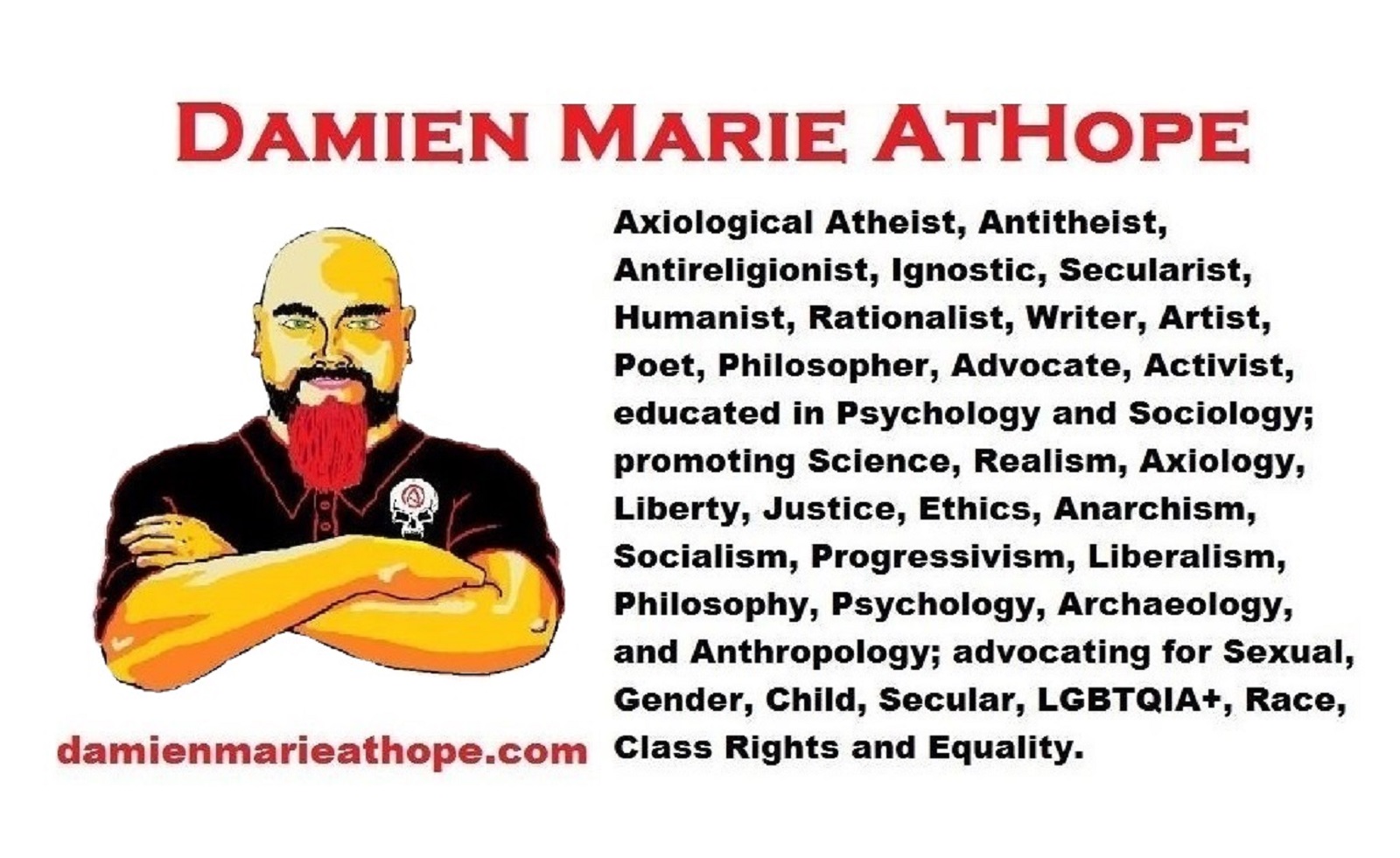
Damien Marie AtHope (Said as “At” “Hope”)/(Autodidact Polymath but not good at math):
Axiological Atheist, Anti-theist, Anti-religionist, Secular Humanist, Rationalist, Writer, Artist, Jeweler, Poet, “autodidact” Philosopher, schooled in Psychology, and “autodidact” Armchair Archaeology/Anthropology/Pre-Historian (Knowledgeable in the range of: 1 million to 5,000/4,000 years ago). I am an anarchist socialist politically. Reasons for or Types of Atheism
My Website, My Blog, & Short-writing or Quotes, My YouTube, Twitter: @AthopeMarie, and My Email: damien.marie.athope@gmail.com

